
Rail Safety Week 2024 – Let’s Build Safety Together
How to Get More Tracks for Your Greenbacks & Rail Live 2024 It’s Make-or-Break for US Passenger Rail – Connectivity Is Key for Long-Term Success
Railway-News The latest news & reviews from the industry ISSUE TWO 2024 MAGAZINE Inside:
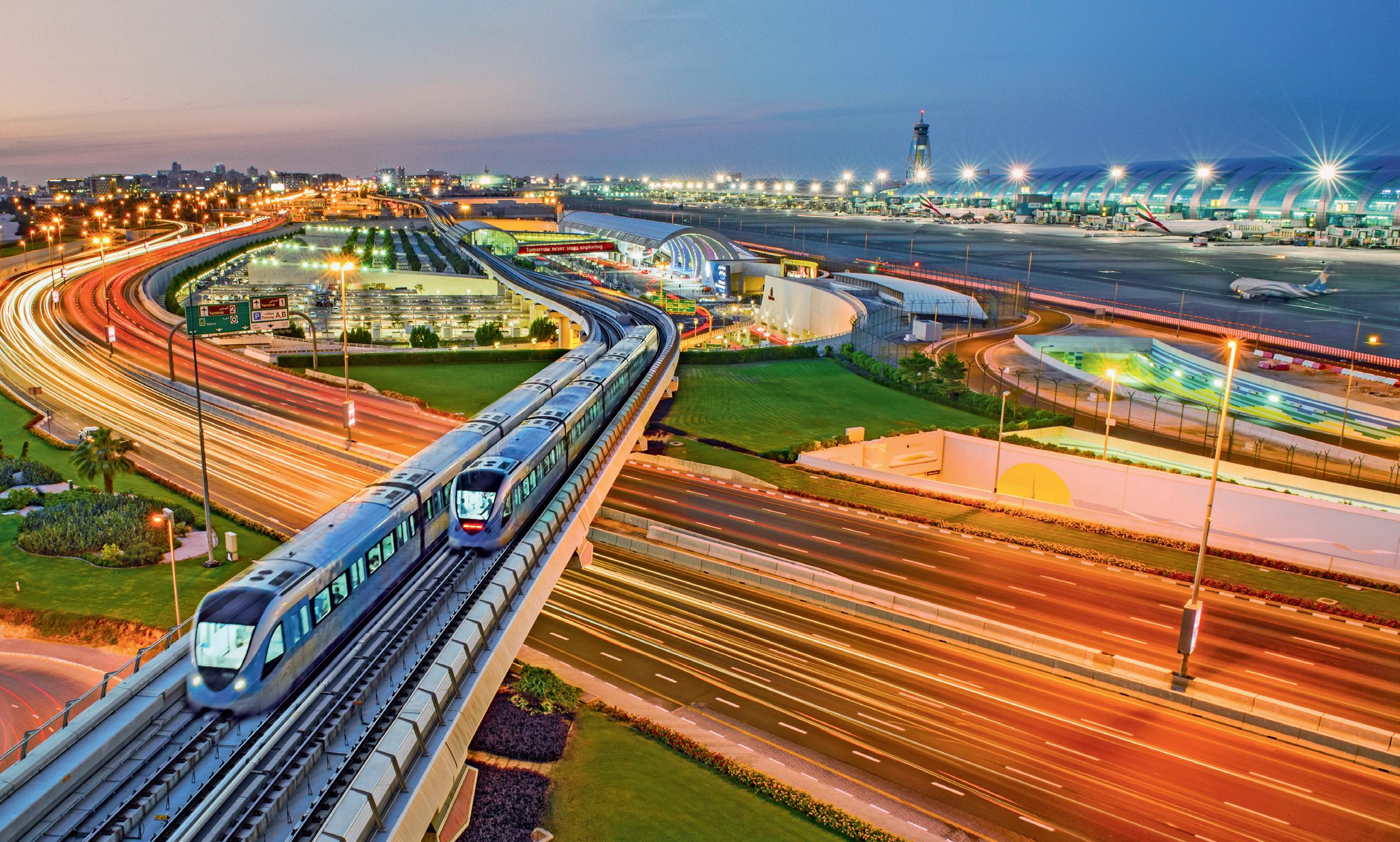

Together with you, Goldschmidt masters the challenges of modern, railbound mobility – for safe, sustainable and long-lasting railways of premium quality.

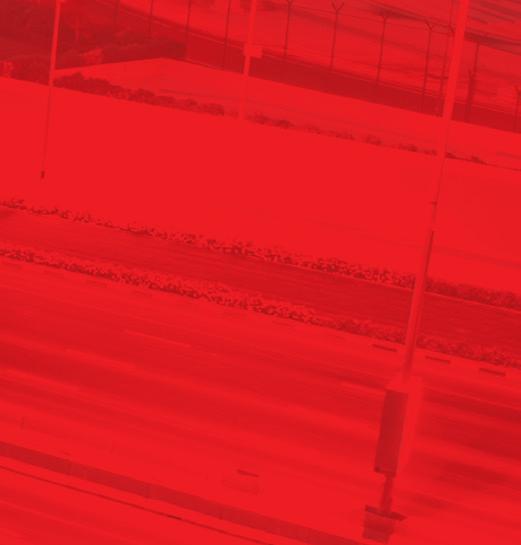






Goldschmidt offers a comprehensive range of products and services worldwide for the joining of rails, modern construction of railway track, and inspection and maintenance of your track infrastructure. Using our products and services combined with our intelligent digital solutions, we are pushing for the digital future of track.
The unique global network of experts gives you access to the international range of products and services of Goldschmidt – right where you are, via your local contact person, backed by the power of the entire group.
www.goldschmidt.com
MOBILITY WITH VISION
Letter from the Editor

Dear Readers,
In this issue we have two articles that look at rail in the US. The first one, How to Get More Tracks for Your Greenbacks, presents the key recommendations made by Paul Lewis, Principal at DB E.C.O. North America on how rail infrastructure costs could be reduced in the United States, given that rail projects in the US have a much higher per mile cost than equivalent projects in other countries.
Martin Shaw, Head of On-Train Digitalisation for Icomera, says that following the authorisation of large-scale investment through the Bipartisan Infrastructure Law, rail operators are comprehensively upgrading their vehicles and technologies. He argues that this is a make-or-break moment for US passenger rail in terms of delivering on the digital train.
On the events side of things we are on the other side of the pond. We look at what’s in store for this year’s Rail Live 2024, which will take place in Long Marston this month.
In addition, Elaine Clark, CEO of Rail Forum, raises awareness of the upcoming Rail Safety Week in her contribution, Rail Safety Week 2024Let’s Build Safety Together.
In our sections on track & infrastructure, rolling stock and data & monitoring, you can read the latest news and developments about green loans for infrastructure projects, trackbed maintenance, train seating, wheel profile measurement, FRMCS, revenue management, remote condition monitoring and much more!
If you would like our rail news straight to your inbox, make sure you’re subscribed to us here. If you want to be featured on our site or in our e-magazine, please email Andrew Lush or call +44 7432 725001.
We hope you enjoy this issue. As always, we welcome your feedback and insights, which you can send to editorial@a2bglobalmedia.com.
 Josephine Cordero Sapién, editor-in-chief
Josephine Cordero Sapién, editor-in-chief
ANDREW LUSH Director al@a2bglobalmedia.com
JOSEPHINE CORDERO SAPIÉN Editor-in-chief jcs@a2bglobalmedia.com
NICOLA BROWN Head of Sales nb@a2bglobalmedia.com
ZOE GRIFFEY Head of Design zg@a2bglobalmedia.com
TIANA MAY Principal Journalist tm@a2bglobalmedia.com
a2b Global Media Ltd
The Generator Hub, The Gallery Kings Wharf The Quay, Exeter EX2 4AN
Office: +44 (0)1392 580002 Mobile: +44 (0)7432 725001
Email: info@railway-news.com Website: railway-news.com
To subscribe to our newsletter, visit railway-news.com/subscribe
3
Meet the Team! Meet the Team!
Follow us on LinkedIn COVER: Aerial view of Rail Live © JB Media
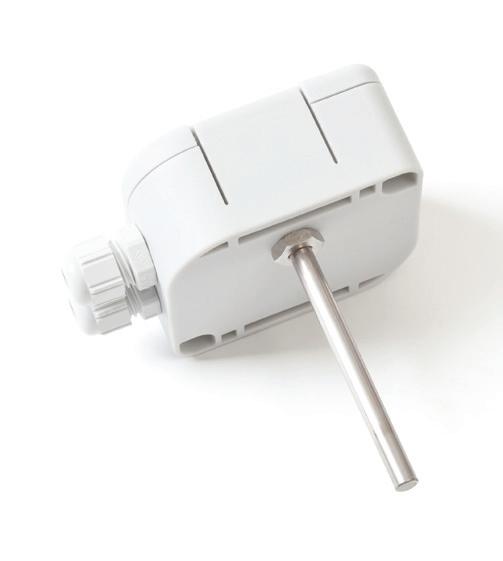

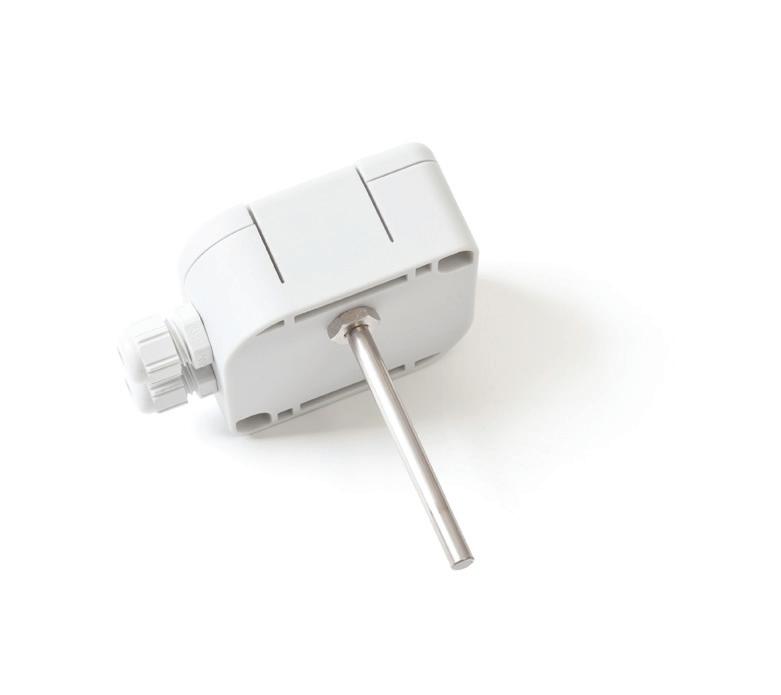



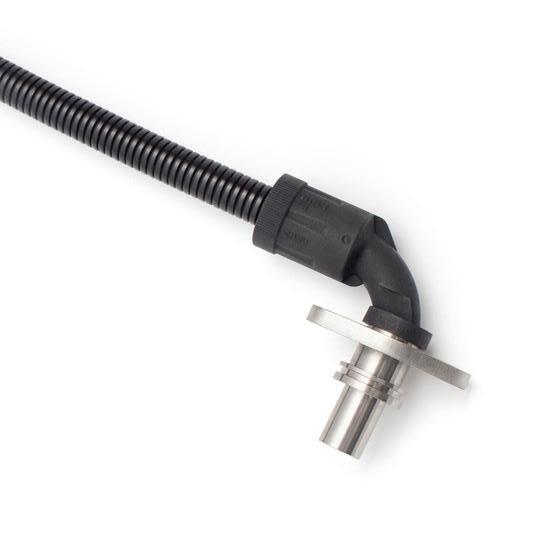

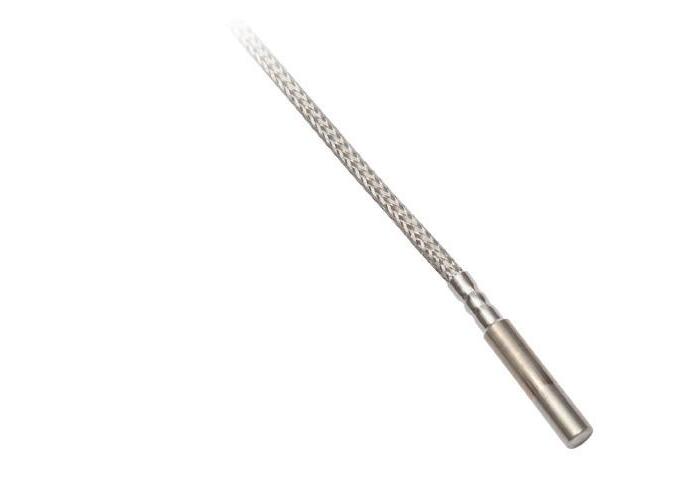

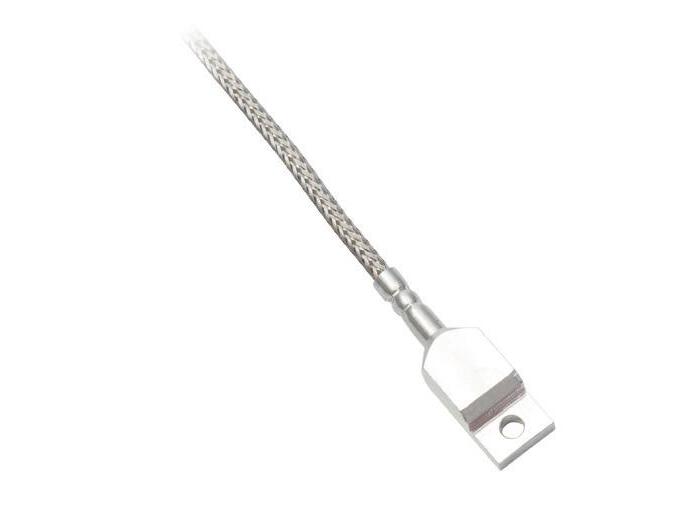
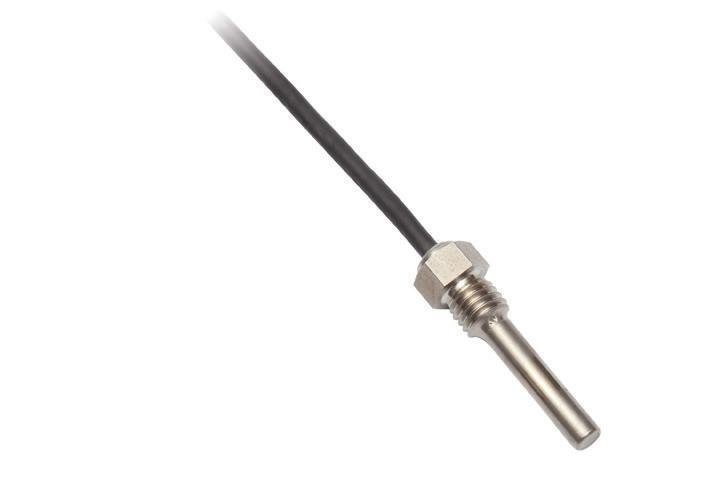
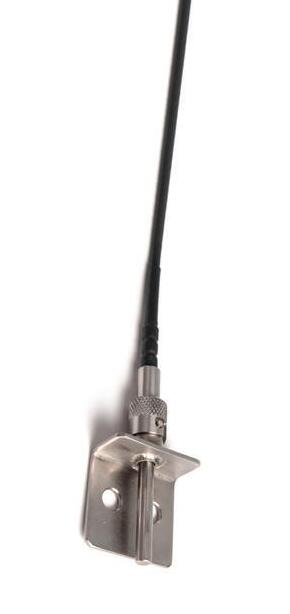

Issue Two 2024
Features
p.6
How to Get More Tracks for Your Greenbacks
Our journalist Tiana May looks at why rail infrastructure projects in the United States are so much more expensive than elsewhere in the world and presents the key recommendations made by Paul Lewis, Principal at DB E.C.O. North America at the recent High Speed Rail Alliance webinar Global Best Practices for Cutting the Cost of Building High-Speed Rail.
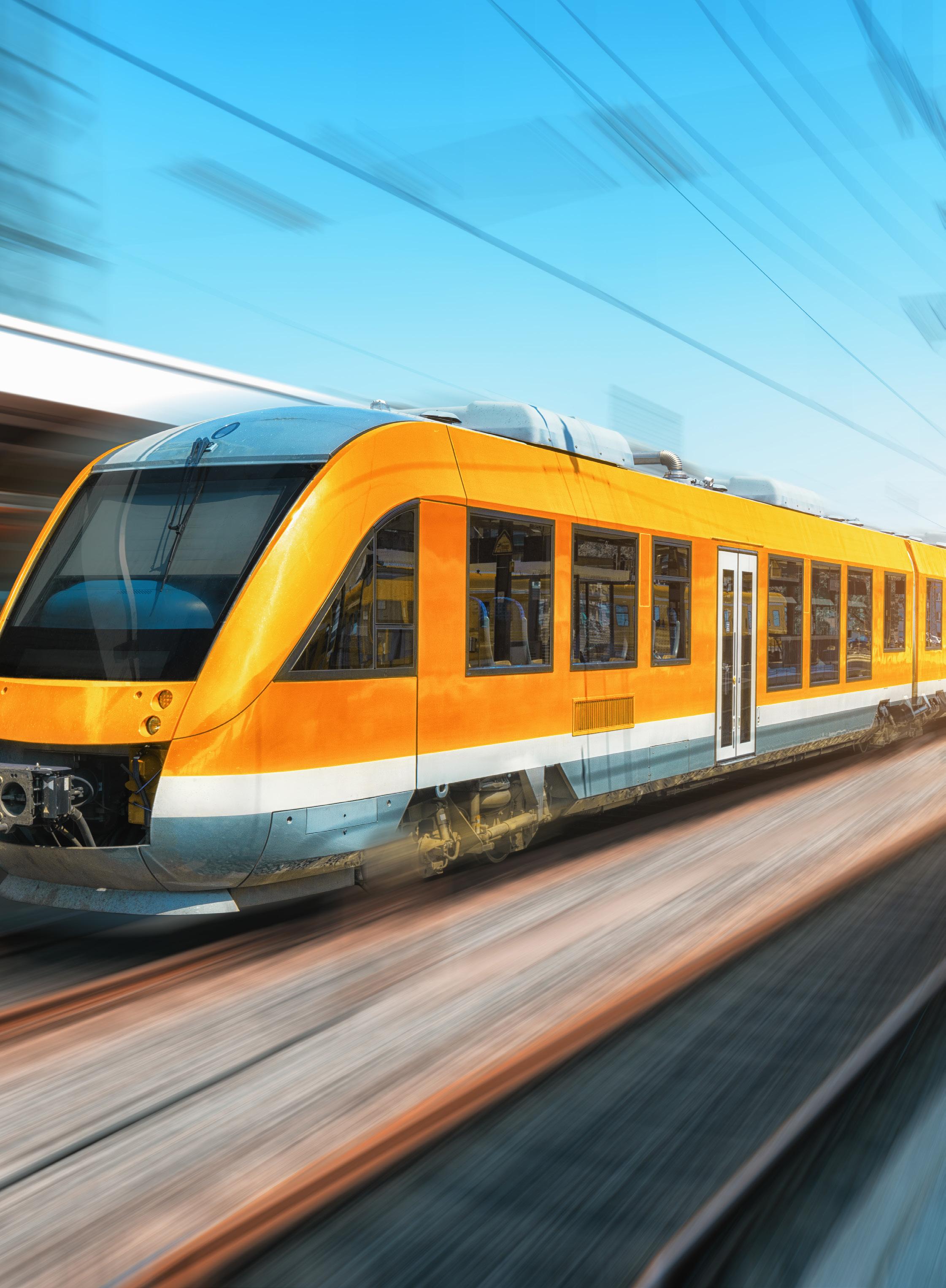
p.10
It’s Make-or-Break for US Passenger Rail –Connectivity Is Key for Long-Term Success
Martin Shaw, Head of On-Train Digitalisation for Icomera, discusses the concept of the digital train and its importance for interoperability and affordability.
p.14 p.81
Directory
A directory of railway suppliers for data & monitoring, track & infrastructure, rolling stock and services. Read about all the latest innovations and product developments in the rail sector.
Track & Infrastructure – p.17
Rolling Stock – p.29
Data & Monitoring – p.55
Events
Rail Live 2024 – p.82
Supplier Spotlight – p.84
Upcoming Events – p.85
Rail Safety Week 2024 – Let’s Build Safety Together – p.86
5
CONTENTS
How to Get More Tracks for Your Greenbacks
By Tiana May, Principal Journalist
The USA is currently experiencing historic investments in intercity passenger rail services thanks to the Bipartisan Infrastructure Law. Among many initiatives, this funding is helping to support the construction of high-speed rail projects, including California HighSpeed Rail and Brightline West.
However, the nation’s High-Speed Rail Alliance argues that a systemic cost problem in the US could risk restricting the impact of such investments. In fact, rail projects in the US currently cost 2 to 4 times more per mile than comparable projects abroad, thus inhibiting the nation’s ability to expand its network.
To address this concern, during a recent webinar, the High-Speed Rail Alliance invited Paul Lewis, Principal at DB E.C.O. North America to discuss global best practices in the industry that could help agencies complete projects at a lower cost and to a more efficient timeline.
As an extreme example, Lewis compared the Hamburg U4 Extension Phase 1 with the NYC 2nd Avenue Subway Extension Phase 1. These projects had comparable scope and similar infrastructure and geology. The U4 extension stretches 2.4 miles under Hamburg, while the 2nd Avenue extension spans 1.7 miles under New York City. However, the former cost 238 million USD per mile to construct, while the latter cost 3.28 billion USD per mile (adjusted for purchasing power parity and inflation). This highlights a delivery cost that was more than 10 times greater in the US compared to Germany.
To explore the reasons behind such a disparity, Lewis identified three key drivers affecting the cost and timeline of a project: project governance, process and standards. With these factors in mind, he offered ten recommendations for delivering cost- and timeeffective projects.

6
Fresno Station © CHSRA
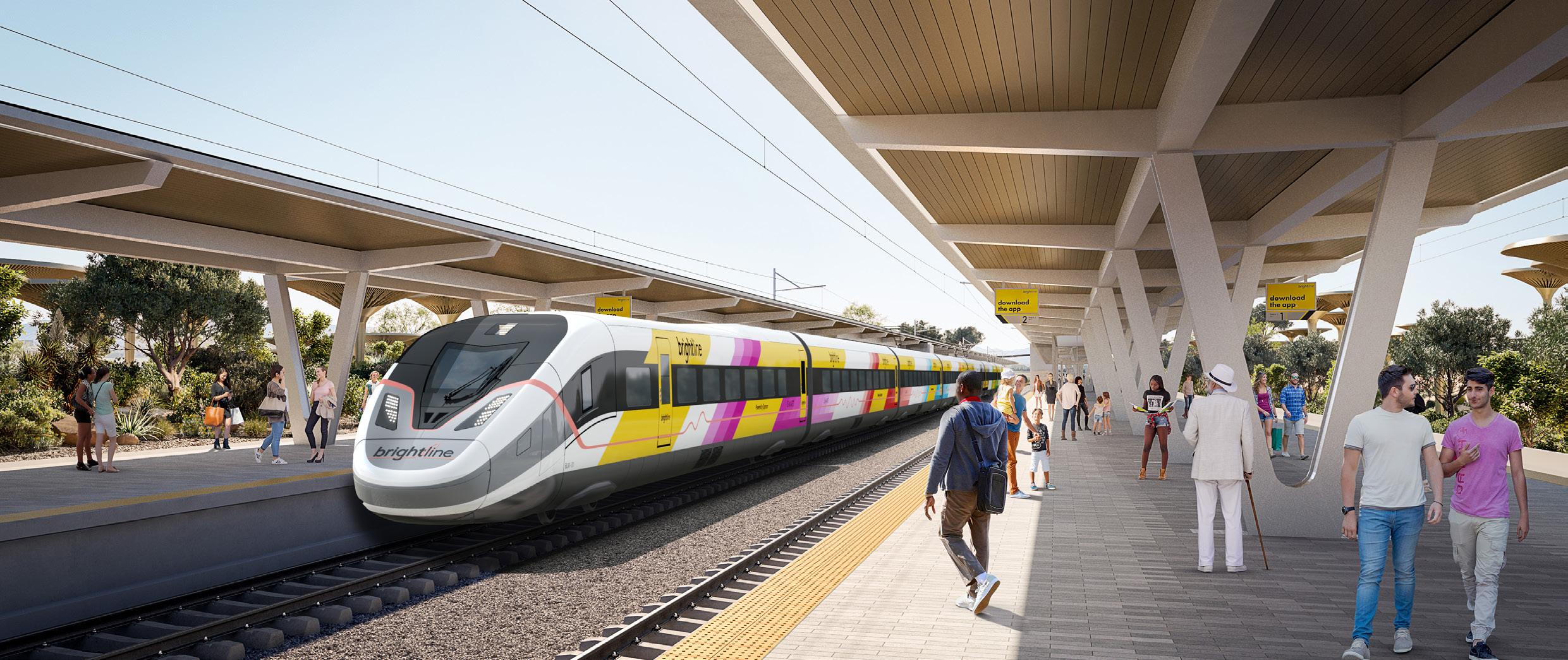
1. Building Simple and Useful Projects
As an achievable commitment, agencies should avoid unnecessary customisations and complexities, including in station designs. Indeed, the most cost-effective approach tends to be for all stations to be functional and interchangeable in design, rather than prioritising unique aesthetics.
Likewise, Lewis stated that the construction of rail infrastructure should avoid tunnelling deeper than required and argued that cut and cover designs should be considered where possible.
2. Break Up Civil Works Contracts and Set Itemised Costs
Currently, the US is one of the only countries in the world that relies on multi-billion dollar mega contracts to deliver major rail projects. Elsewhere, civil rail contracts do not tend to surpass between 100 and 200 million USD. For example, when constructing the Leipzig City Tunnel in Germany, the tunnelling, ramps and stations were broken up into different contracts.
This approach provides greater competition, as more firms can bid on smaller contracts, whereas only a few are qualified for multi-billion dollar endeavours. In addition, this gives the agency more control over the project’s performance as contractors who do not deliver satisfactory work can be replaced. Finally, the project’s schedule can also be better controlled, as
issues can be addressed without disrupting the rest of the project.
3. Manage More Risk on the Public Sector Side
To help lower bids, Lewis argued that public agencies need to assume more risks that are not under the control of contractors. Otherwise, if contractors are expected to assume risks that they do not have control over, they will inevitably price this into their bids.
4. Empower Staff to Engage the Community
Traditional community engagement in the US can be viewed as ineffective or a “tick the box exercise”. Instead of hiring external consultants, Lewis recommended using in-house staff to engage the community during the entire planning, design and construction processes.
Furthermore, he asserted the importance of the agency being empowered to say no, rather than trying to accommodate for every community comment.
5. Proceed with the More Disruptive Timeline
Here, Lewis dismissed the need to minimise disruptions by keeping roads open and limiting working hours. He argued that a more disruptive approach from the start ultimately leads to less disruptions in the long run and helps significantly cut costs.
7
© Brightline
6. Finish the Planning Process before Environmental Review
Environmental reviews are time-consuming worldwide. However, Lewis identified that more efficient projects tend to avoid using this procedure as part of their planning process.
When an environmental review commences before all key planning decisions are made, it becomes an inefficient vehicle for making these decisions. This leads to the creation of environmental impact statements (EIS) with dozens of alternatives, thus elongating the process.
7. Boost Internal Staffing
Typically, the US relies on hiring consulting firms for tasks such as project management and construction management. In contrast, in most other countries, the project owner remains in control of the project using an in-house team. In turn, this leads to more efficient and less costly delivery.
8. Set Agreements with Partners Early
When establishing labour agreements and betterments, it is important to have full transparency with all scope and costs factored in. Lewis suggested that all details and eventualities should be established in advance, rather than allowing conflicts to arise once construction is underway.

9. Address Institutional Governance
Transit agencies are primarily tasked with providing transport, rather than delivering multi-billion dollar projects. It is therefore key to establish whether the agency has the right board structure and staff support to move a project forward before it gets underway.
If this is not the case, the issue should be addressed early through reform or changes to the governance, or by creating a special purpose delivery team, such as that established for the Stuttgart 21 project in Germany.

8
© CHSRA
Cedar Viaduct © CHSRA
10. Learn from Peer Country Examples
Finally, thanks to the array of successful transit projects worldwide, Lewis advocated for visiting other countries and agencies to learn from their achievements and talk to experienced professionals. This could help agencies expand their knowledge to understand how common problems are overcome and costs are reduced.
By working to adopt these recommendations, it is hoped that the US can overcome its systemic cost problem in delivering large-scale rail projects.
The average cost per mile of transit projects varies significantly across the globe. For high-speed rail, the average cost per mile is 47.4 million USD in France, 53.8 million USD in Spain and 80.7 million USD in Germany. In Taiwan, this figure averages at 133.2 million USD per mile, while in Switzerland, it costs an average of 134.9 million USD per mile.
Higher-cost countries include Italy at 165.9 million USD per mile; Japan at 185.8 million USD per mile; Great Britain at 220.9 million USD per mile; and the Netherlands at 252.1 million USD per mile.
These figures are adjusted for purchase price parity and construction inflation. However, alongside their differing processes and approaches, in some cases, the varied costs also reflect the required complexity of the projects and the percentage of line that has had to be tunnelled or elevated.
Needless to say, in order to successfully deliver a nationwide rail network, the US must aim towards the lower, rather than high end of these figures.
At present, it is estimated that the California HighSpeed Rail project will cost around 200 million USD per mile. However, arguably, by learning from past inefficiencies and adopting global best practices from abroad, future agencies could significantly lower this figure to further optimise investments in rail across the nation.

To read more from our Principal Journalist, Tiana May visit railway-news.com © Brightline 9
It’s Make-or-Break for US Passenger Rail – Connectivity Is Key for Long-Term Success
By Martin Shaw, Head of On-Train Digitalisation for Icomera
The concept of the digital train is not simply an imaginary glimpse into the future; it is the imminent evolution of public transport tailor-made to meet the expectations of a connected world.
With every turn of the wheels, the very notion of travel is being reimagined, shaping up to fit into a digitally dominated era where seamless internet connectivity is as essential as the tracks upon which the trains ride.
Gone are the days when digital transformation within railways was constrained by bits and pieces of technology scattered across compartments. We are venturing into terrains where central connectivity platforms are not the exception but the standard. Guided by the insights of Martin Shaw, an expert, and Head of On-Train Digitalisation for Icomera, we chart today’s ambitious course toward the digital train – an entity that encourages not only modern conveniences but marks a significant leap in transport technology.
Two years ago, the Bipartisan Infrastructure Law authorised the investment of more than one trillion dollars in federal spending on transportation, broadband access, clean water and electrical grid improvements. The transportation industry is now seeing the effects of that funding first-hand: across the country, rail operators are upgrading their infrastructure and purchasing new vehicles that will carry passengers for the next two decades or more. Our country’s passenger rail network has never before seen such a comprehensive upgrade to its vehicles and technologies.
 Martin Shaw Head of On-Train Digitalisation for Icomera
Martin Shaw Head of On-Train Digitalisation for Icomera
This is a make-or-break moment for rail travel in the US. While the COVID-19 pandemic led to a sudden drop in ridership for rail operators, the American Public Transportation Association (APTA) reported that overall ridership has recovered to 79 percent of pre-pandemic levels in April 2024. A widespread upgrade of the passenger experience could lead not only to a return of pre-COVID levels, but also a sustained period of growth as customers recognise the advantages of commuting and travelling by train.
This growth will only be possible if rail operators focus on delivering a modern, future-proof, customerfriendly experience. To succeed, these companies need to embrace the ‘digital train – building off a single, centralised connectivity system to integrate everything from passenger Wi-Fi to video surveillance to energy metering to passenger counting.
10
Addressing the Digital Train Need
The digital train is crucial for two main reasons: interoperability and affordability.
Interoperability: A modern train includes a dozen or more onboard systems: GPS, on-train data recorders, real-time passenger information and other dedicated solutions for security and operations. Historically, these many tools have been installed and operated as standalone systems, each with its own source of power and connectivity. Each of these individual systems increased the overall complexity of operating and maintaining the vehicle, while also taking up more physical space in the train itself.
The lack of interoperability of these onboard systems limits the rail operator’s ability to introduce new passenger services. For example, if the passenger counting system operates on the same network as the passenger information system, the rail operator can quickly and seamlessly display which cars are full and which are empty, allowing passengers to move towards the empty cabins for a more comfortable experience. When those two systems are walled off from each other, even this basic service is impossible to implement.
Affordability: Rail operators – and the rail industry in general – can no longer afford to look at these systems in isolation. Instead, every system upgrade or replacement should be looked at in the context of the train as a whole.
There are two paths for rail operators to adopt the digital train strategy successfully. As companies consider how to upgrade their vehicles, they must choose between 1) upgrading their systems all at once with a comprehensive solution or 2) taking a stepby-step approach with each individual improvement. While some European and UK rail operators have achieved success with wholesale overhauls of their vehicles, a step-by-step strategy will be more realistic for most rail operators.
Rethinking Strategy for a Digital Train
The digital train strategy starts and ends with rethinking relationships and mindset.
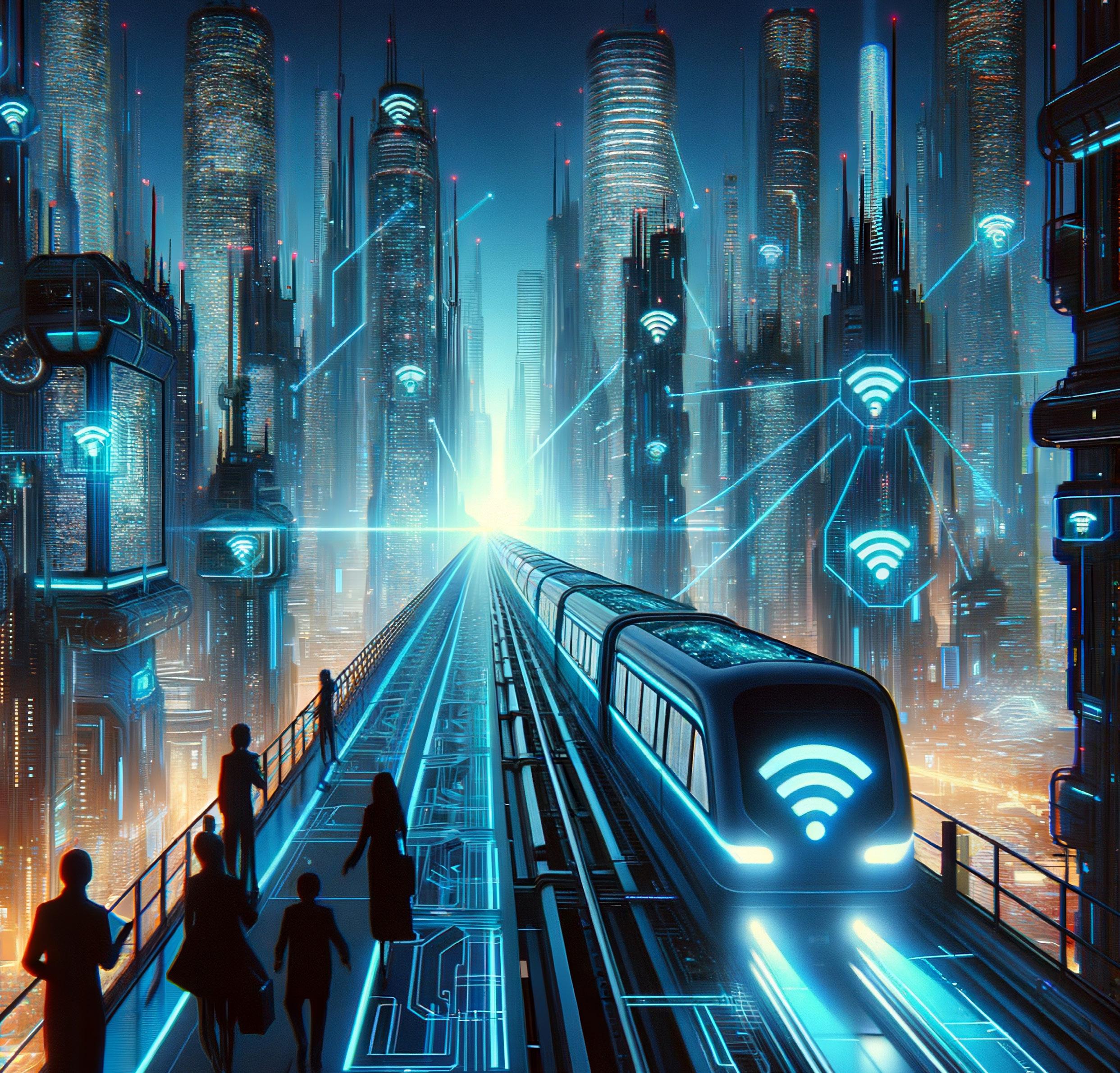
Rethinking relationships: Working towards a digital train strategy requires rail operators to rethink their relationship to their equipment. Previously, equipment was often sold as ‘fit and forget’ – systems that could be installed and operated with minimal ongoing oversight and maintenance. The next generation of onboard technologies will require more expertise and management.
11
Changing the mindset: Passengers will naturally be critical when systems don’t work as they should – bad Wi-Fi and inaccurate passenger information are common complaints among rail travellers. Rail operators need to take a long-term view of their digital train initiatives and recognise that the shortterm growing pains will allow them to deliver a more comfortable and more innovative passenger experience in the future.
Bringing IT internal: As rail companies upgrade their vehicles, they will need to bring on new personnel to manage the health and reliability of the system. Transportation companies must become technology companies to some extent to remain viable in the long-term; as a result, they’ll need to hire IT experts. While some rail operators may be hesitant to take on the added expense, they will see a trade-off in reducing the maintenance costs associated with isolated, fragmented systems. Instead of having to install, maintain and replace multiple connectivity platforms, they will only need to look after one comprehensive system.
Monitoring cyber security: Rail operators have legal obligations to protect passenger data. They must conduct extensive penetration testing to ensure that systems stay compliant with regulations. But while the overall need for cybersecurity increases as a result of the digital train strategy, it’s important to note that the overall risk does not increase when systems are combined on one connectivity platform. A combined connectivity platform allows for central monitoring to ensure resistance to cyber attacks. Networks can also be segmented, isolating any penetration to a single area, significantly reducing the overall exposure and risk.
Long-Term Implications of a Digital Train Strategy
Decisions made when upgrading transit vehicles will have long-term implications.
As rail operators use federal funding to upgrade their vehicles, the choices they make will have longterm implications both for their passengers and for the organisations themselves. Adopting a single connectivity solution keeps the door open in the
“This is a make-or-break moment for rail travel in the US. While the COVID-19 pandemic led to a sudden drop in ridership for rail operators, the American Public Transportation Association (APTA) reported that overall ridership has recovered to 79 percent of pre-pandemic levels in April 2024.”
Martin Shaw, Head of On-Train Digitalisation for Icomera
future to integrate modern technologies and continue upgrading the passenger experience. Maintaining siloed systems keeps the rail operator frozen in place, unable to keep pace with modernisation.
When passenger rail operators deliver a truly modern customer experience, they can compete with private vehicle travel and steadily increase ridership: instead of being stuck behind the wheel of a car, passengers can stay connected, productive and entertained over the course of their journey.
This customer experience is only achievable with exceptional connectivity – the digital train is an essential strategy for the rail industry’s long-term stability and growth.
The next few years will determine the overall trajectory of rail travel in the United States. Rail operators have an excellent opportunity to increase ridership and demonstrate why passenger travel is an appealing alternative to car travel. We can not afford to miss the opportunity by holding on too long to legacy technologies.
For more information visit www.icomera.com alternatively if you have any questions email martin.shaw@icomera.com.
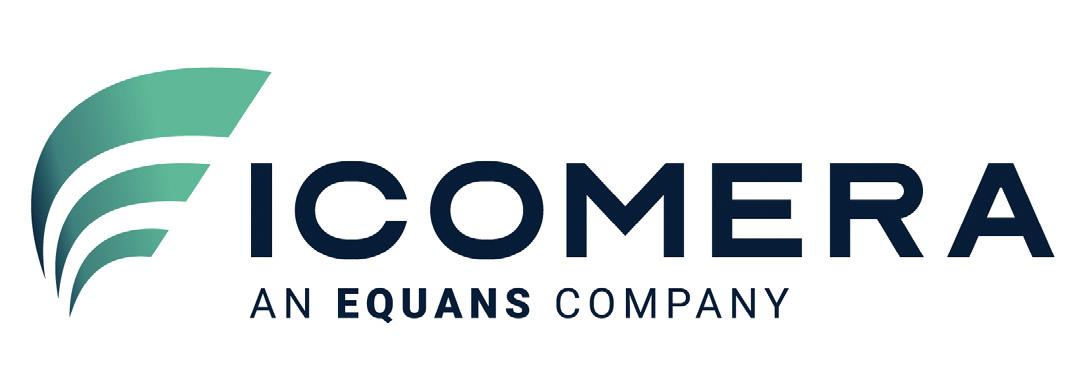
12

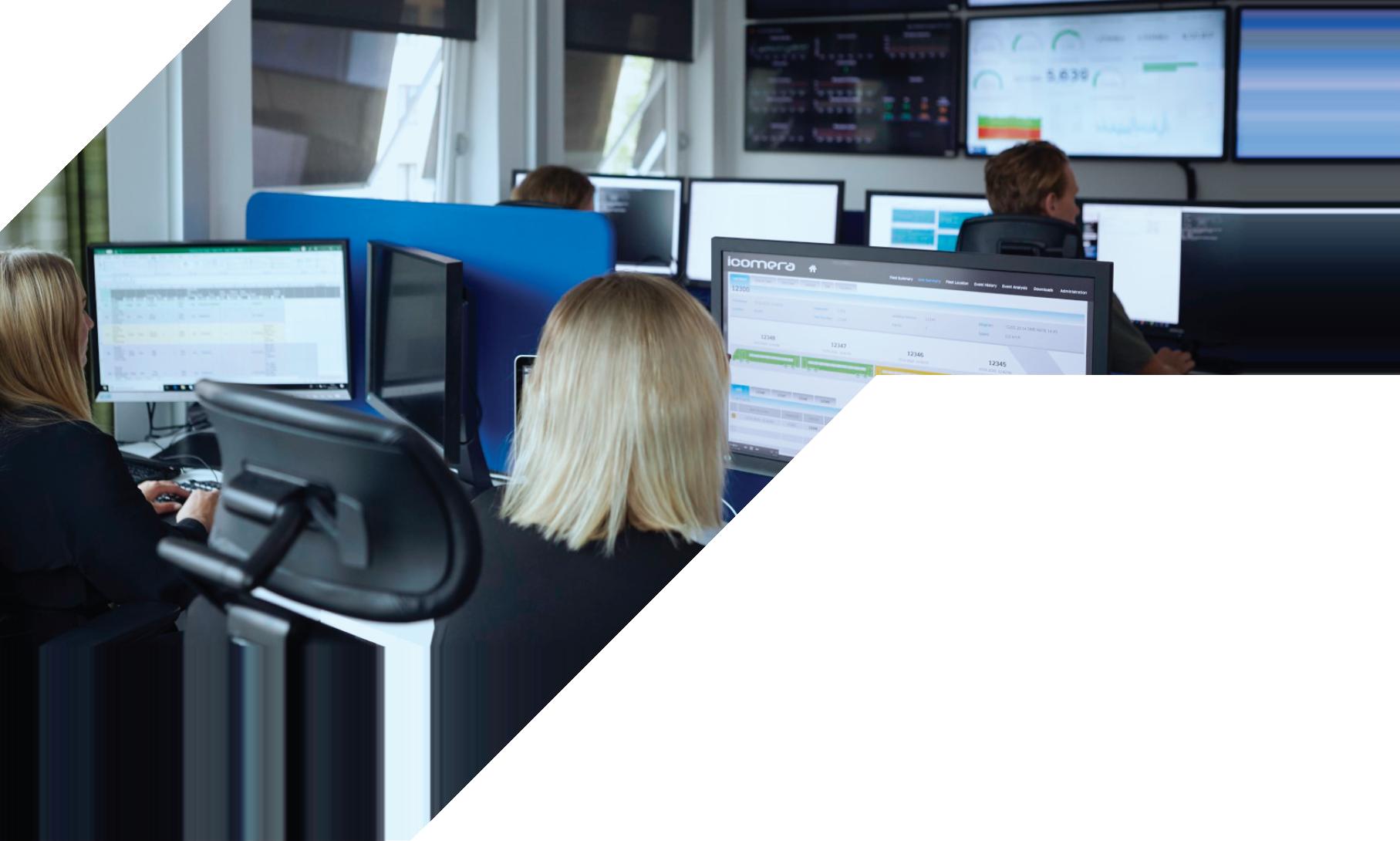


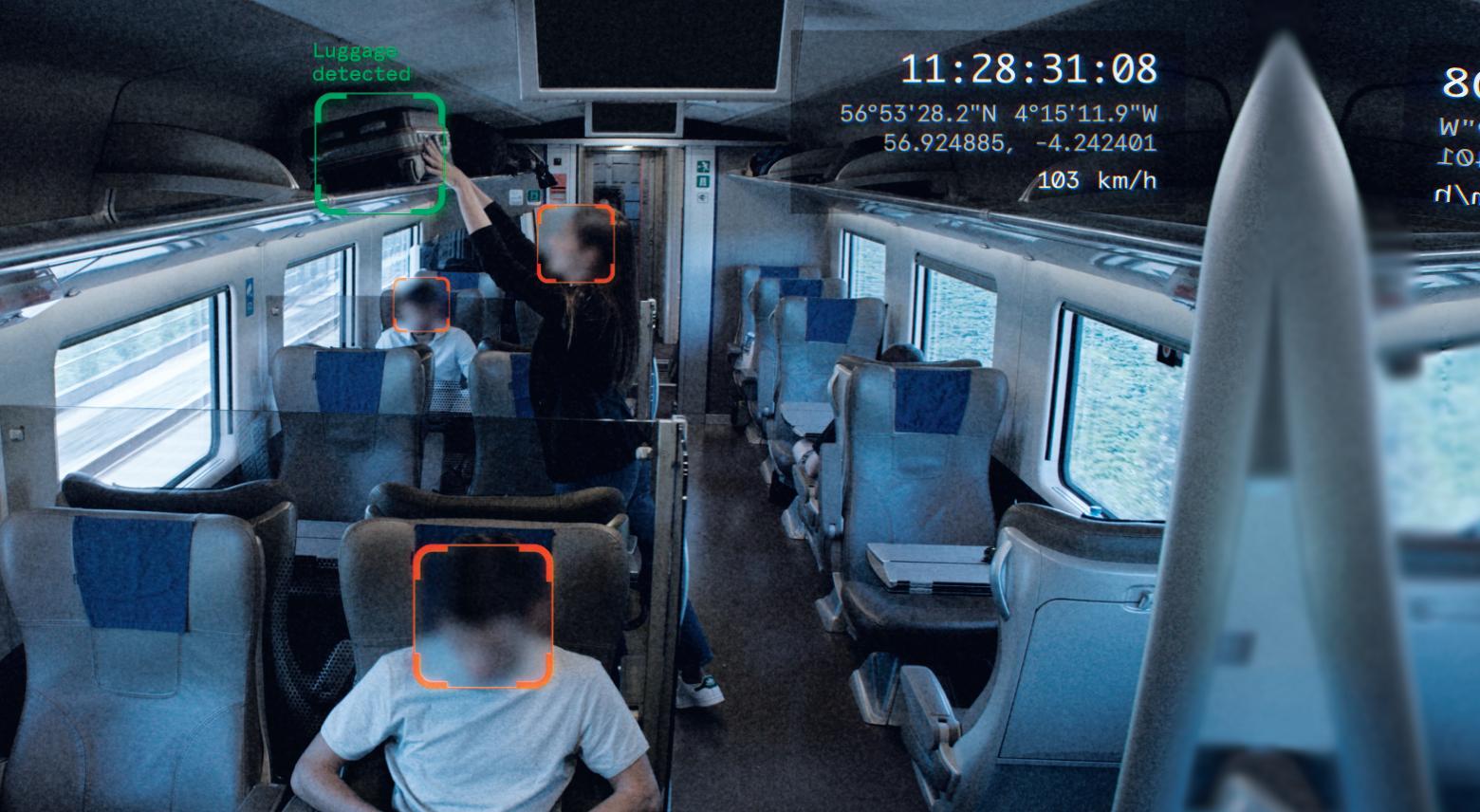




29 55 17 14
Directory


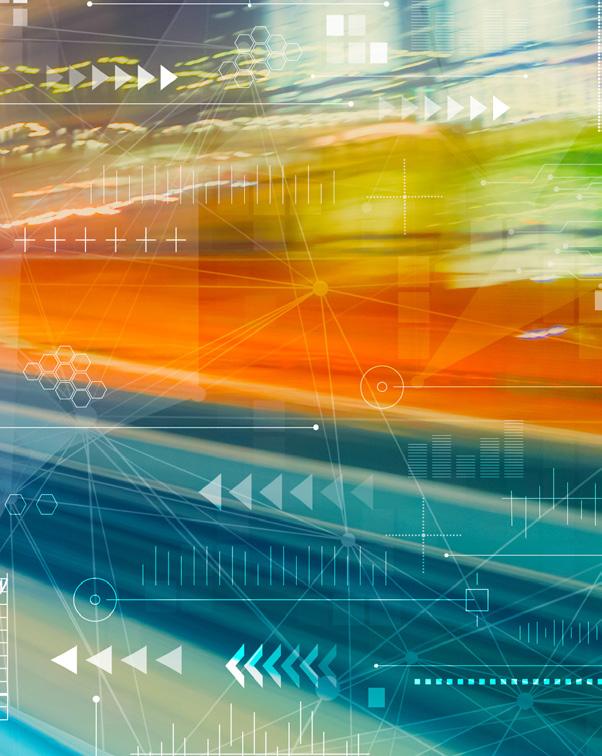
Rolling Stock p.29 Data & Monitoring p.55 Track & Infrastructure p.17 Works Vehicles & Machines p.20 Worksite Protection p.23 Maintenance & Equipment p.26 Train Interiors p.30 Components & Materials p.35 Manufacturing & Maintenance Equipment p.44 Testing & Measuring Equipment p.47 Cleaning & Decontamination p.52 Planning & Management Software p.56 Communications Technology p.58 Computers & Sensors p.62 Revenue Management &Ticketing p.68 Signalling & Train Control p.71 Condition Monitoring p.74 15
Geocomposites: Solving the track stabilisation headache
A one hour overview of the use of geocomposites as a solution to trackbed maintenance problems that includes:
n Why use geosynthetics and geocomposites?
n Cost, time and sustainability benefits
n Installation and best practice
n Product development and testing
n Counts toward PDH and CPD requirements
Contact GEOfabrics for more information or to schedule a session, remotely or in person at info@tracktex.us



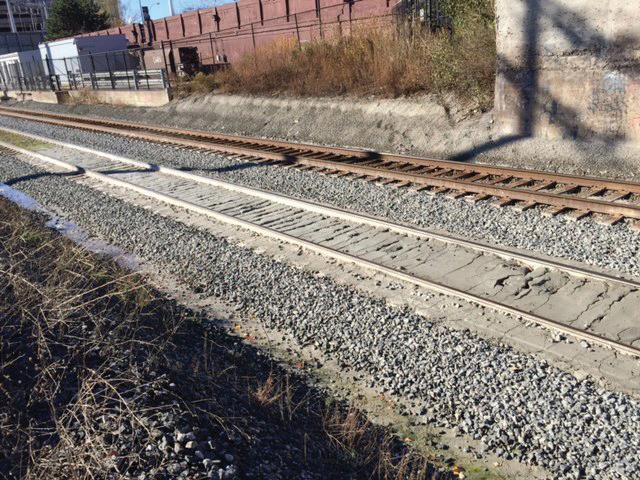
www.geofabrics.com tracktex.us/services/professional-development-hour
The experts in rail geosynthetics Free professional development seminars

Track & Infrastructure
KfW IPEX-Bank p.18
Work Vehicles & Machines
Laser Tribology B.V. (LPS) p.20
Worksite Protection
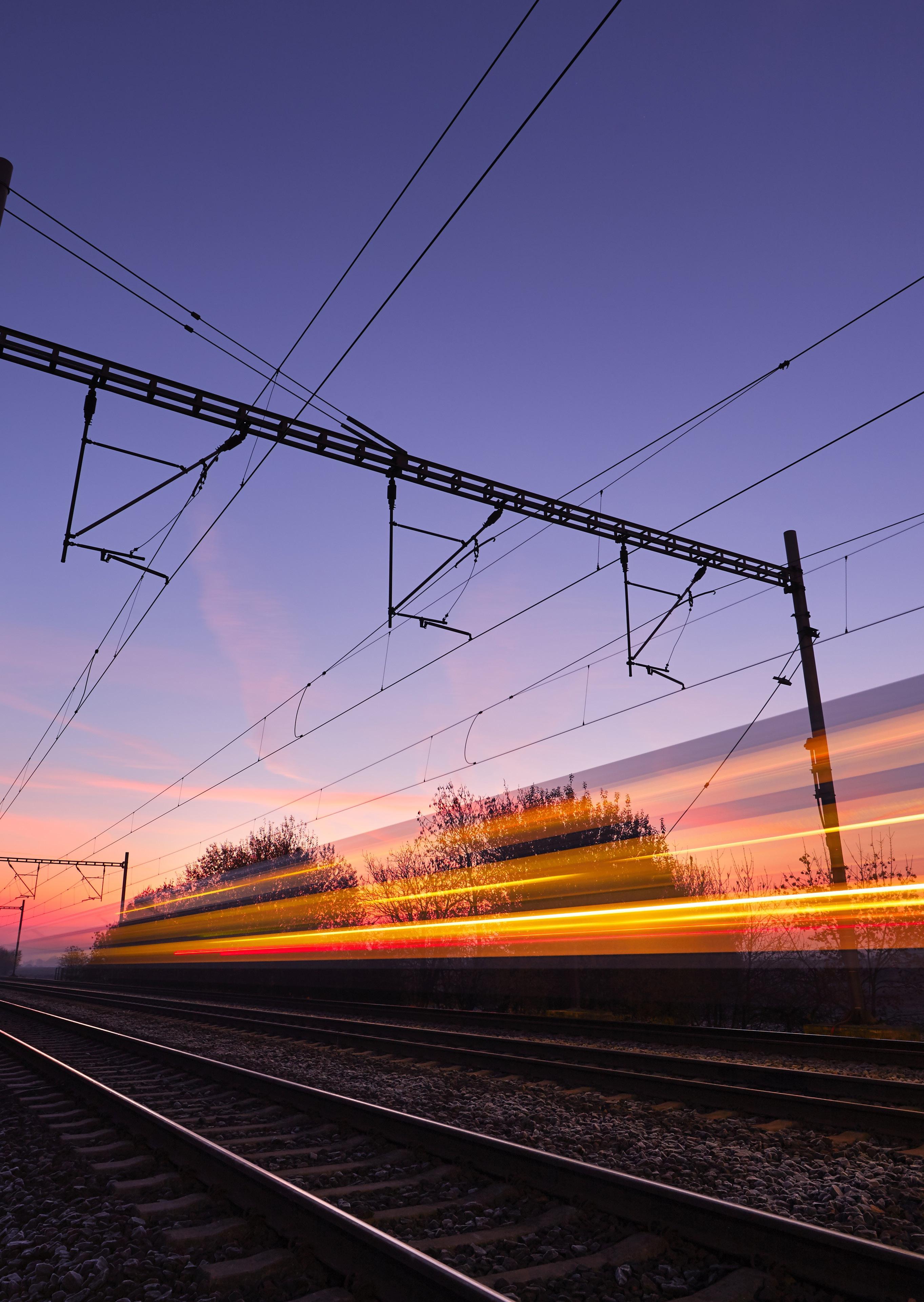
DSRailTech a.s. p.23
Maintenance & Equipment
GEOfabrics p.26
Directory
17

Going Green – How Banks Are Supporting Environmentally Sustainable Projects with Green Loans

Greenloans can help rail organisations get closer to achieving their sustainability goals.
Businesses are prioritising climate neutrality and environmental sustainability more than ever before. Today, stories of the climate crisis make national headlines, and with new record-breaking temperatures reported every month, the world is focused on climate action.
An international goal, known as the Paris Agreement, aims to keep the increase of the average global temperature below 2°C, and also to pursue efforts to keep this rise as close as possible to 1.5°C.
This is no simple task. However, the rail industry has an important role to play in getting us closer to this objective by providing greener transport solutions.
As it currently stands, rail travel is already less polluting than travel by road, but new lower emission and carbon-neutral technologies such as battery electric and hydrogen-powered trains are helping to reduce the sector’s greenhouse gas (GHG) emissions even further.
Opening the Doors to New Financing Opportunities
Across the rail industry we’re seeing a growing number of businesses focus on increased environmental sustainability, which is also opening up new doors to raising finance.
By integrating green finance frameworks into their overall sustainability strategies, businesses are committing to investing in environmentally friendly projects. In order to make this commitment in a credible manner, they often use the widely recognised
Directory Track & Infrastructure
18
© Torkel Dalan / Bane NOR
green loan principles (GLP) of the Loan Market Association (LMA) or green bond principles (GBP) of the International Capital Market Association (ICMA) as the foundation of their frameworks, as complying with these ensures their ability to access green loan opportunities.
This is an example of the banking industry’s commitment to decarbonisation, as green loans were created to finance projects that support the transformation towards a net zero society.
“We’re keen to support our customers doing business in this area,and the green loan principles ensure that projects will truly have a positive environmental impact,” says Sylvia Sedlacek, Director of Mobility and Transport at KfW IPEX-Bank.
As a bank that stands for transformation, KfW IPEXBank finances technologies of the future to support the transition towards a more sustainable society. By implementing ambitious sector guidelines for CO2-intensive sectors, it’s ensuring its financings are compatible with the Paris Agreement goals.
Supporting Green Rail Initiatives in Norway
Scandinavia is a leader in environmental sustainability, particularly in the rail sector. Here we’ve seen the roll out of new night train services powered entirely by green energy from hydro, wind and solar sources, as well as plans for a new Stockholm-Oslo rail connection. These are just two examples of projects in the region designed to promote sustainable public transport options and lower reliance on air travel.
This is why KfW IPEX-Bank was pleased to announce that in late 2023 it signed a green loan with Bane NOR Eiendom valued at approximately NOK 1,140 million (EUR 100 million). This will be used to invest in green projects such as supportive railway infrastructure and service facilities, which can be maintenance depots, trains storage and depot facilities.
The Norwegian state-owned company, which is in charge of the development and management of the country’s supporting rail infrastructure, launched its green finance framework in 2021. This was awarded the Center for International Climate Research (CICERO)
rating Medium Green in 2020. And just recently, in March 2024, it was rated Dark Green by Second Party Opinion Providers S&P Global.
Bane NOR’s overarching goal as a company is to support the Norwegian railway and create attractive transportation hubs. By increasing the efficiency and appeal of rail travel, it aims to encourage people to choose public rail over the use of their own vehicles.
With this financing, KfW IPEX-Bank is supporting a catalyst for environmentally sustainable public transportation.The extension and refurbishment of maintenance workshops will enable maintenance services for the longer passenger trainsets (over 200 metres in length) that will be required to meet the higher demand expected for public rail in the future, as well as increasing the overall efficiency of the maintenance cycle.
Financing Green Rail Projects
KfW IPEX-Bank is experienced in arranging financing for green rail infrastructure projects, as well as the acquisition of rolling stock that uses alternative power sources. This includes innovative and attractive bilateral or large-scale financing structures for among others locomotives, railcars, passenger trains, trams, metros as well as the construction of railway tracks, maintenance depots, station and signalling. By introducing GHG accounting, KfW IPEX-Bank aims to achieve a net zero emissions portfolio by 2050.
Visit our website Follow us on LinkedIn
For further information on how KfW IPEX-Bank can finance your green investments, or for support for developing a green finance framework, please contact:
Sylvia Sedlacek Director of Mobility

and Transport Frankfurt am Main, Germany (Headquarters)
sylvia.sedlacek@kfw.de
Track & Infrastructure 19


Elevating Rail Maintenance: Tackle Autumn Challenges with LaserTrain
The persistent challenge of slippage on the line has far-reaching implications for the industry. As passing trains crush fallen leaves, they become a teflon like substance with an oily residue that diminishes the coefficient of friction (COF) of the railhead and can compromise rail safety. This leads to difficulties accelerating and braking, resulting in hazardous conditions and inevitable delays.
Developed by LPS, LaserTrain introduces an effective solution for rail maintenance. Its high-intensity lasers clean various contaminants such as leaves, oil, debris and rust from the railhead without compromising track integrity, while its advanced control system enables autonomous operation for optimal results. By enhancing de-acceleration distances and improving rail traction, LaserTrain minimises accidents, prevents slip incidents and ensures safer railway operations for passengers and rail staff alike.
Operational Efficiency and Flexibility
LaserTrain offers faster and more efficient railhead decontamination compared to traditional methods, covering larger areas in less time and eliminating the need for refuelling and complex logistics associated with water-filling stations. This dramatically reduces downtime and minimises disruptions to network operations. Demonstrating exceptional performance with MTA Metro North Railroad, one LaserTrain cleaned
435 miles per day, cleaning over 55% of the network every 24 hours.
Additionally, LaserTrain's remote operations boost efficiency and safety by removing the need for workers to be near the tracks or equipment, alleviating the burden of staff planning during the slip-slide season. A selection of cleaning speeds offers operators the flexibility to adapt to individual cleaning needs. The LaserTrain can be leased or purchased with cleaning speeds of 20mph, 40mph, and 60mph.
Cost-Effectiveness
LaserTrain's higher initial investment is offset by its substantially lower running costs. LaserTrain's ability to achieve comparable cleaning performance to traditional methods like water jet, with far fewer units offers significant reductions in operational expenses over time. Since the majority of LaserTrain costs are upfront fixed expenses, the total cost per distance decreases as more distance is cleaned.
Another benefit is that it helps reduce wheel wear and prevent wheel blocks, thereby prolonging rail wheel longevity and decreasing maintenance expenses. For example, during Metro North's 2022 pilot, LaserTrain delivered savings of $1.6 million, while the Long Island Rail Road in 2020 confirmed its role in reducing wheel truing. This reduction translated to an estimated annual saving of $500,000 in shop labour and material costs. The extended lifespan of the rail due to reduced wear is still to be assessed.
Directory Track & Infrastructure
20
Plug and Play: The Freight Model Advantage
The Freight Model of LaserTrain offers several advantages over bespoke models. Its pre-set design is simpler and more standardised, reducing engineering, build and test time and and providing ensured regulatory compliance. Designed to fit a Y25 bogey or R141 truck without modifications, the 20ft half-height container ensures compatibility with UK, EU and US loading gauges.
The pre-existing design and standardised components streamline production, installation and maintenance processes, resulting in shorter lead times, higher uptimes, reduced costs and easy spare parts management. The Freight Model is constructed and tested in the Amsterdam workshop by LPS staff before installation, minimising any risk of oversights or surprises.
Transportation, Installation and Maintenance
Transporting and installing the Freight Model is effortless, facilitated by a flatbed lorry and a forklift. Installation and de-installation times are significantly reduced, dropping from three weeks to just two days, with no need for scaffolding or LPS staff for completion. Maintenance is equally straightforward, accessible components, ensuring cost savings and shorter lead times.
Operations and Performance
Designed to achieve 200,000 kilometres per year versus 50,000 kilometres per year, the Freight model ensures better longevity and reliability. It requires only one hour of maintenance per week compared to one hour per shift, minimising downtime and operational disruptions. Additionally, it can operate with or without a separate generator, reducing costs and boosting operational flexibility.
In conclusion, LaserTrain's Freight Model delivers superior performance, lower maintenance,
enhanced operational flexibility and cost-effectiveness compared to traditional rail cleaning methods and bespoke options, making it a top choice for rail maintenance. Streamlined installation, maintenance and spare parts management further reduce overall costs and maximise return on investment.
Embrace LaserTrain and drive innovation in your rail cleaning operations today.
Get in Touch
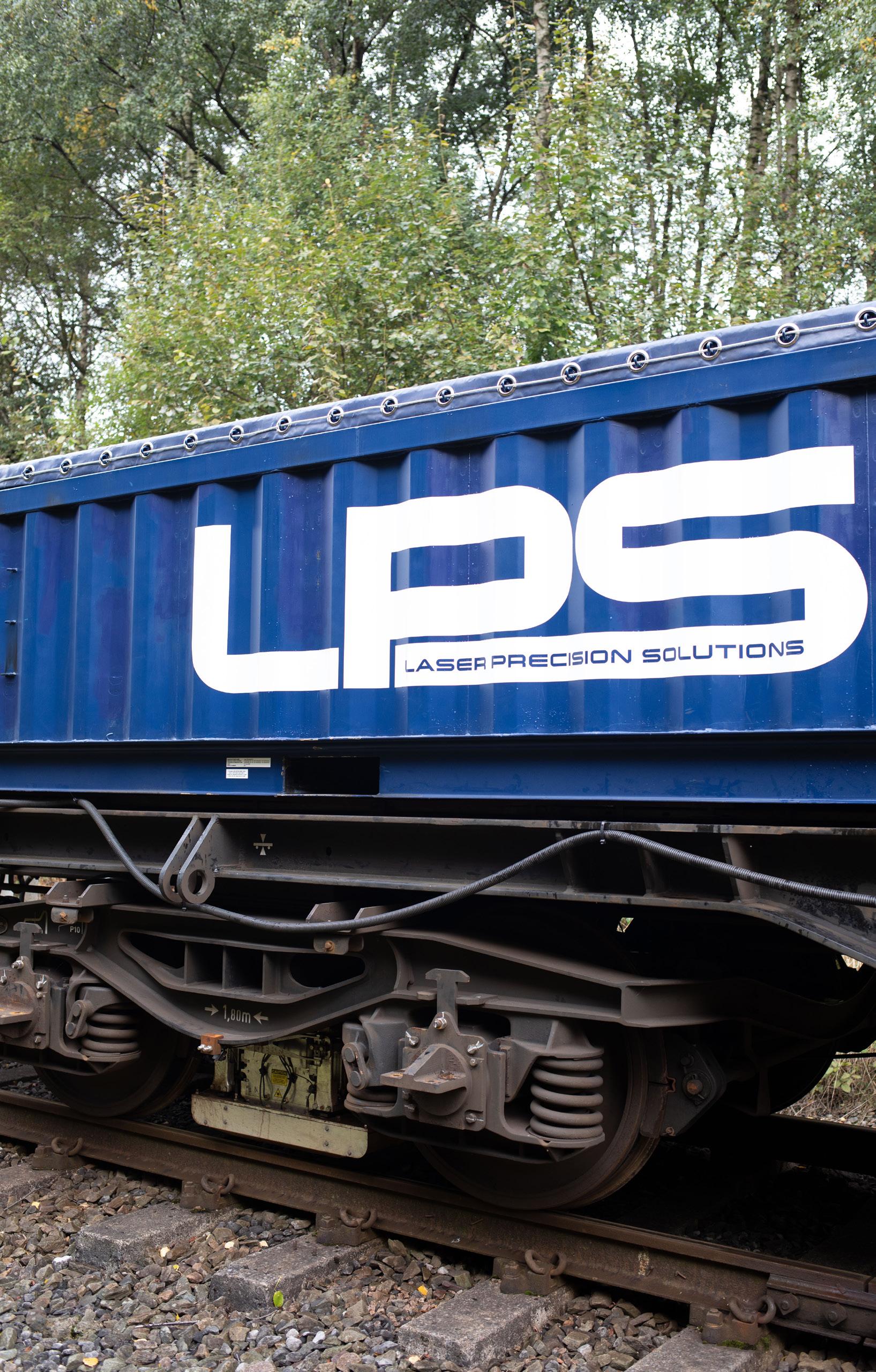
Click here to contact LPS or email info@lasertribology.com to speak to the team
Works Vehicles & Machines
21


M I N I M I S E D I S R U P T I O N S , M A X I M I S E E F F I C I E N C Y . Trust LaserTrain for safer, more efficient operations and keep performance, maintenance and safety on track. laserprecisionsolutions.com

Track & Infrastructure

• Innovative railway company located in Czech Republic with operations since 2015
• Specialises in delivering diagnostics and safety systems to the railway industry with a huge scalability potential and innovative factor
• DSRT solutions bring more accurate results compared to existing solutions together with a broader range of metrics and rail coverage with a single system
About DSRailTech
• Our mission is to improve safety in the railways to protect lives and save costs
• DSRailTech is a mid-sized company with highly skilled and experienced professionals specialising in delivering diagnostics and safety systems to the railway industry
Our Solutions – Railways
• Disruptive deep-tech safety and diagnostics system helping railway operators and infrastructure owners to monitor train movements and detect precursors present or developing in the tracks and on rolling stock, thus increasing railway safety
• Detecting anomalies by analysing the vibrations propagated in the rail over longer distances
• Providing critical information to operators
• Integration with ERTMS and other systems
• DSRT solutions are able to detect accident precursors in advance and in very early stages, monitor their development and severity over time, thus playing a crucial role in preventing accidents from happening
DSRailTech Applications
• Rail occupancy monitoring
• Rolling stock monitoring
• Axle derailment monitoring
• Rail defect monitoring
• Track obstruction monitoring
• Flat wheel detection
• Intrusion detection application
• Switch condition monitoring application (dynamic effects)
• Portable warning system
• Rail buckling monitoring
• Hot box detection
• Hot wheel detection
New Applications Launching in 2025
Our R&D department is constantly working on the improvement and innovation of our solutions.
Rolling Stock Weighing
• Rolling stock weighing application measures the load on every wheel of any rolling stock, regardless of speed, informing the operators of any deviations from their set default values
Flood Detection
• Detects the presence of water and generates alarms whenever the water reaches dangerous levels
• Informs when the water retracts (sensors are not submerged anymore)
• Detects whether the water is flowing or still
• Detects solid materials in the water
DSRailTech Diagnostic System - DMP Platform
The DMP platform is composed of outdoor components and components which are housed inside an enclosure.
Directory
Worksite Protection 23
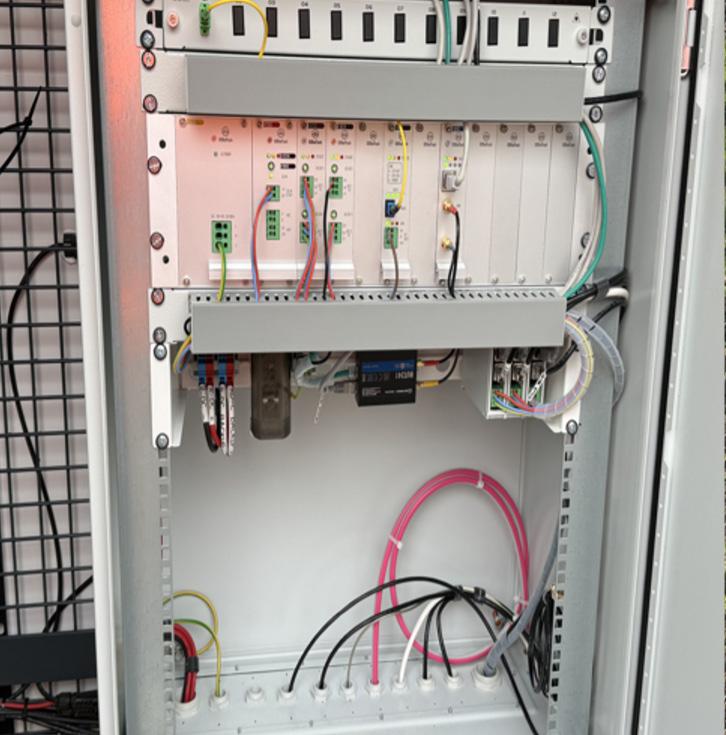
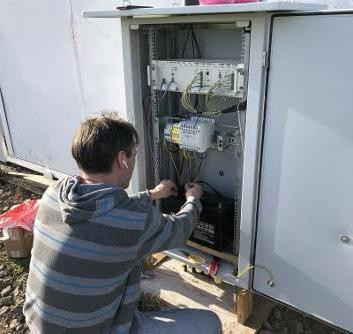
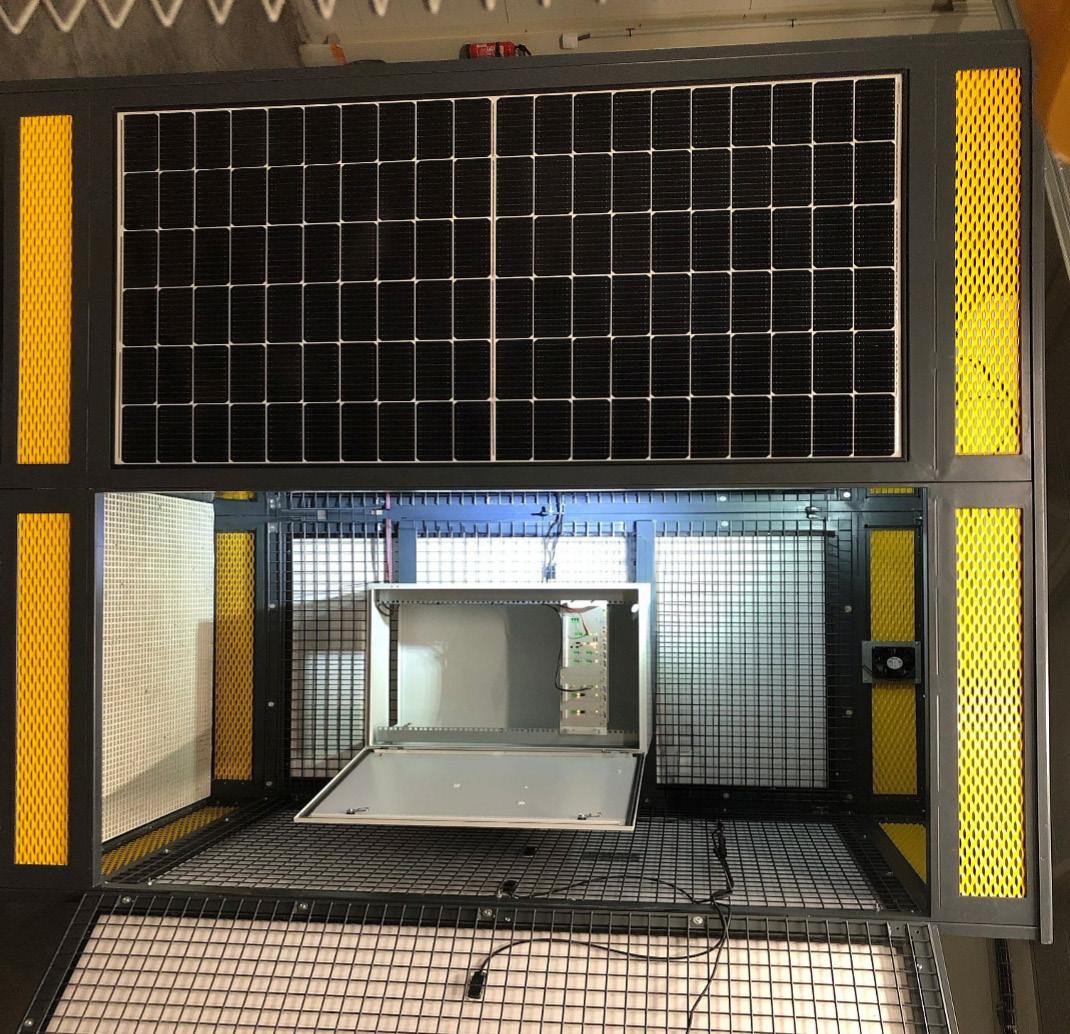
The outdoor components are:
• DXMD – sensing element of the platform. It is responsible for detecting vibrations both from afar, and locally on top of the DXMD
• DXIR – IR detector for hot box, hot wheel and hot brakes detection
• DACT – vibration generating element of the platform used for rail defect and rail buckling monitoring
• UNEX – responsible for grounding and protecting signal and power lines against electrical surges
The rest of the components are either inside the DMP Rack, the main processing unit of the platform, or in a cabinet/enclosure together with the DMP Rack.
The DMP Rack can be housed in a SolarXBox provided by DSRailTech where the complete solution is powered solely by solar energy.
Installation
• Installation of DXMD, DXIR and DACT is quick, does not require interruption of traffic on the track and can be done by a single person
Portable Warning System – PWS
• The PWS (portable warning system) enables maintenance work to be carried out without restricting track operation and at the same time without endangering the health of the workers. The PWS is easy to operate without the need for lengthy training, is compact and portable, reliable and most importantly helps prevent serious injuries to people during railway maintenance.
• The PWS is housed in a briefcase which can be easily transferred to a maintenance site. After attaching the sensors under the head of the rail
 Installation of external cabinet, DMP Rack located in SolarXBox
Installation of external cabinet, DMP Rack located in SolarXBox
24
Installation of DXMD and DACT

using integrated magnets, the device is ready to detect the approaching train and report this fact to the two-way radio transmitter.
• The system can be connected to two-way radio transmitters from various manufacturers and can operate in PTT (push-to-talk) or VOX mode. The reports are available in several languages, including English, German and Spanish, and contain track identification and the state of the device. The reports are repeated until the danger passes. It is also possible to connect a beacon and a siren to the system wirelessly.
• It is possible to connect eight PWS briefcases together to form one system using cellular network and/or LoRa.
• RALM wireless visual and audio alarms can also be connected to the PWS briefcase. These alarms have a built-in beacon and siren. Up to 16 RALM alarms can be connected to a group of PWS briefcases.
Advantages of Our Solutions
• More reliable broader range of metrics than other systems on the market over further rail distances
• Significant reduction of procurement, installation and maintenance costs
• One system can cover up to 4 tracks using a single DSRT Rack
• Up to 3 applications can run on one system depending on the combination of the applications and the number of covered tracks
• Installation time is within hours, based on the number of covered tracks, and does not require
service interruption on the rail track
• The systems are self-learning which ensures high autonomy and extended categorisation of events
• The systems are modular with self-diagnostic capabilities which decrease the time needed for maintenance and service works to a minimum
• Web-based portal where our clients have a realtime overview about their installations
Unique and Innovative Approach to Acoustic Sensing
• The term ‘acoustics’ is usually associated with sound as perceived by a human; however, acoustics extends to the study of mechanical waves, not necessarily perceived by humans
• DSRailTech solutions are based on this extended expertise in acoustics and other dynamic measurements (such as temperature, displacement and acceleration)
• The sensors (DXMD) are finely tuned, and precisely positioned on the rail to acquire even the smallest vibrations travelling through the rails, as well as huge vibrations induced by a passing train
• By implementing these principles, we achieve that our sensors are the most sensitive, cover the spectral density which is the richest in relevant information and thus significantly increasing the reliability and reducing false positive alarms
• At the same time, by building the evaluation algorithms on deep and machine learning, we provide extended categorisation of events
Our Certifications
• Our company has successfully implemented and is certified in accordance with the internationally recognized ISO 9001, ISO 14001 and ISO 27001 standards
• We are currently preparing for SIL certification and the ISO 45001 (OH&S) certification
Our Ambition
To become one of the leading innovative companies in safety and diagnostics systems in the railway industry adopted across the world.
www.dsrailtech.com
25
PWS portable warning system


Solving Trackbed Maintenance Problems with Geocomposites
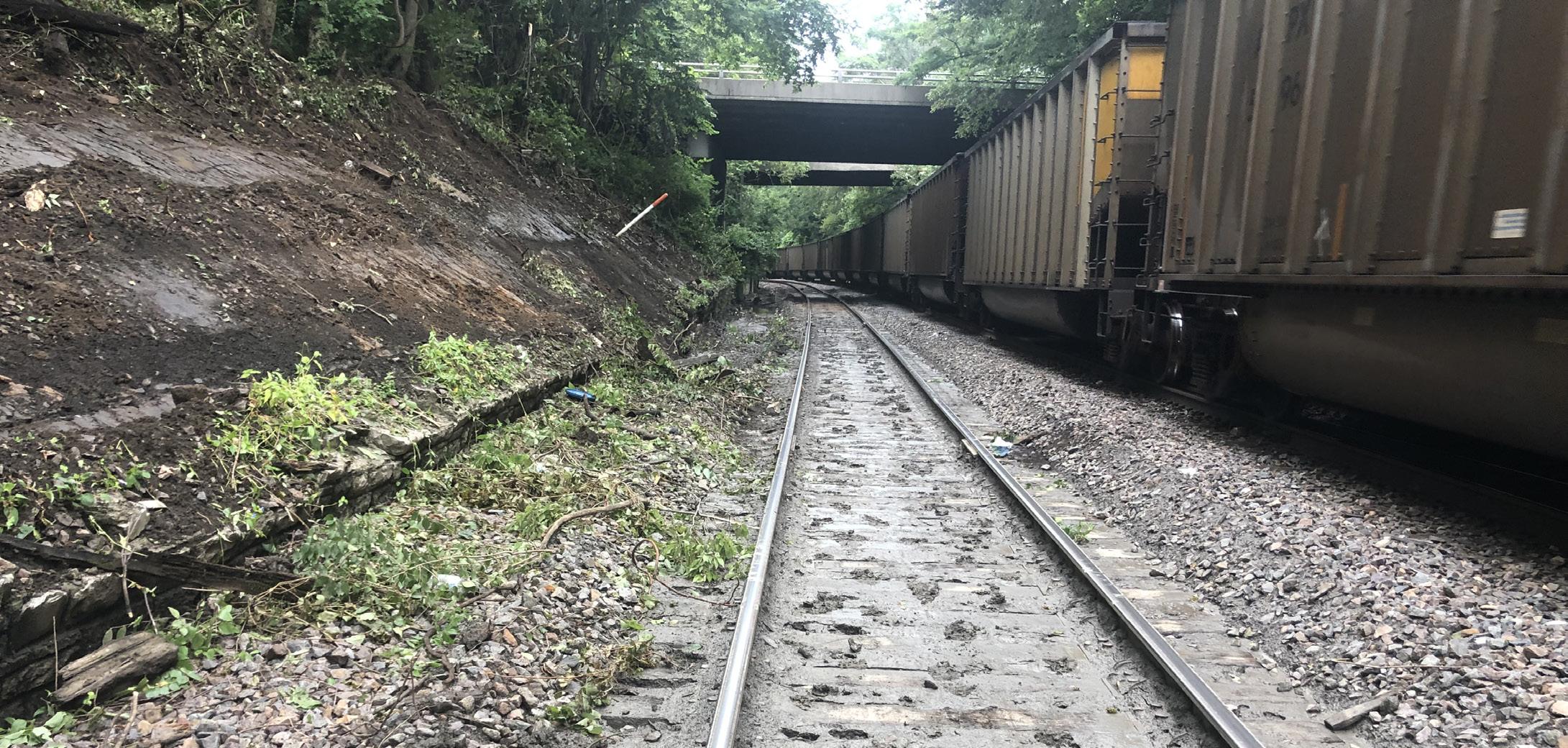
There are many problematic ground conditions that exist beneath railway tracks. As a result, track stabilisation, track geometry and trackbed maintenance are major headaches for the rail industry, worldwide.
It’s true that a range of solutions have evolved over the years – but many come with cost, time and environmental implications, which are far from ideal.
The Issue
The passage of trains applies dynamic loads to soil beneath the tracks. This results in intense compression
and decompression cycles, which can lead to fracturing of the foundations – to the point of collapse. Some of the most widely used methods for solving track stabilisation on railroads involve geocomposites. TrackTex, for example, is used in place of sand blankets to prevent mud pumping.
While sand blankets are successful in curing subgrade erosion, achieving the optimum 300mm layer requires a large volume of excavation. This in itself is expensive and incurs further costs for soil disposal. There’s a requirement for extensive materials to complete the work and the disruption to services causes loss of revenue, too. So, while sand blanketing is still used today, it’s an expensive, slow and unsustainable process.
Directory Track & Infrastructure
26
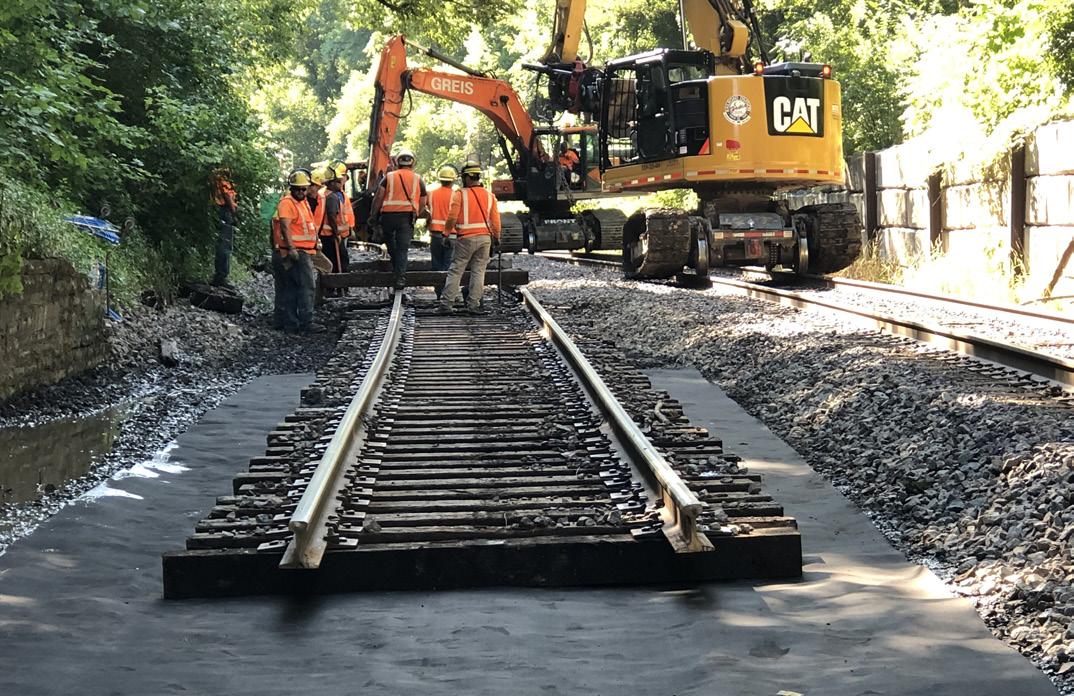
Geosynthetics: A Solution with a Proven Track Record
Geosynthetics have been used for a number of functions in track construction and rehabilitation for almost half a century. When properly specified and installed, they have been proven to significantly enhance the performance of the trackbed, reducing maintenance costs and increasing design lifetime.
Combined in multiple layers, or with the addition of another material, geosynthetics are known as geocomposites. These products provide enhanced benefits, as they reduce required material volumes and speed up installation. With careful design they can provide drainage, protection, reinforcement, filtration and barrier functions while replacing expensive and scarce mineral resources.
GEOfabrics – Experts in Geocomposites for the Rail Industry
GEOfabrics has developed a range of class-leading geosynthetics and composites, specifically geared up to tackling the issues faced by rail operators. These include TrackTex for anti-pumping and RK4 for rail filtration and confinement. Products are performancetested at their state-of-the-art facility which includes a UKAS-accredited laboratory, as well as independently by external bodies.
For example, the TrackTex testing regime included realtime rail loading, simultaneously and cyclically applied to the replicated track construction through three hydraulically powered ram actuators. The rams were programmed to load the installed track dynamically to
simulate anything from an empty passenger train to a fully loaded freight train, or an ultra-high-speed train of the future. Trafficking frequencies were modelled, too. GEOfabrics materials have been used in live rail for many years. So whichever solution a customer opts for, they can feel reassured that it’s been tried and tested by experts.
Free Education Seminars for Businesses
Rail companies across the globe can benefit from GEOfabrics’ expertise in this field through the continuing professional development (CPD) sessions they offer. Delivered by GEOfabrics rail specialists, seminars give businesses greater insight into the use of geocomposites – and how they can solve the challenges they face.
These free-of-charge professional development hours (PDH) are designed to give companies a good understanding of how and where geocomposites provide the most effective performance. Training is usually in person at an organisation’s premises but can also be delivered remotely as a webinar. Sessions can be tailored to meet the training needs of those involved in trackbed maintenance, across all levels of experience. Attendees will gain a good understanding of how to specify and use geocomposites to treat trackbed issues. All workshops are certified by GEOfabrics and count towards professional development hours requirements.
Jim Herbert, Commercial Director at GEOfabrics explains, “Our Technical Sales Team have many examples of clients who use our geosynthetics in their rail schemes reporting reduced costs,faster installation and dramatically extended maintenance cycle times. We offer these training sessions to help clients understand how they can enjoy these benefits on their future projects.”
Contact GEOfabrics for more information or to schedule a session, remotely or in person
Europe, Asia & Africa
Jim Herbert jherbert@geofabrics.com +44 7773 334 742
Frank Pace fpace@geofabrics.com +1 816-305-3160
USA & Canada
Maintenance
Equipment 27
&
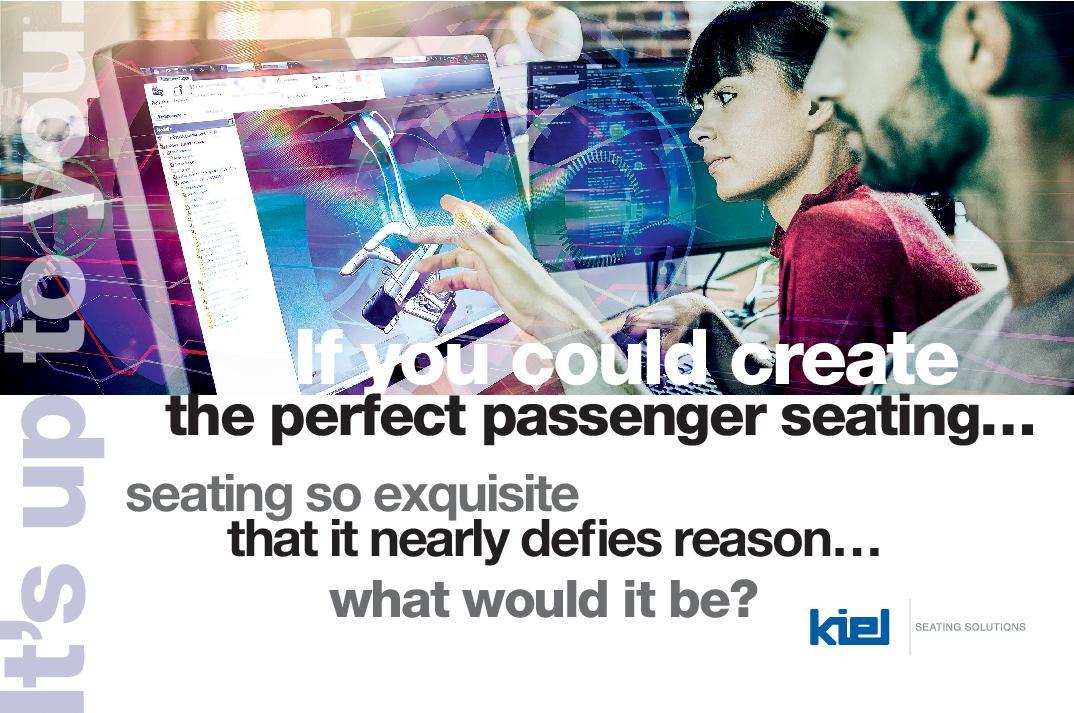



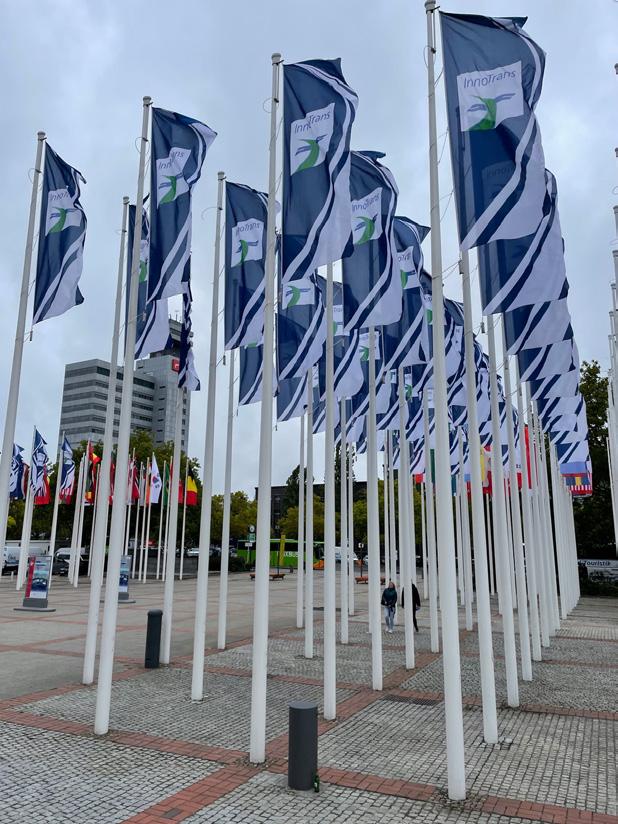


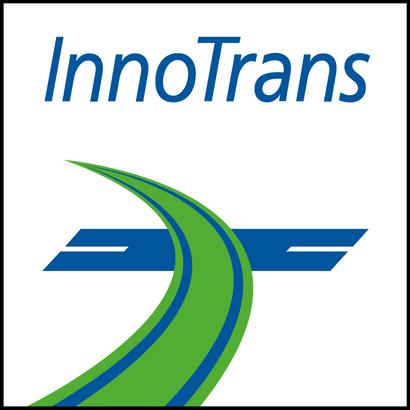
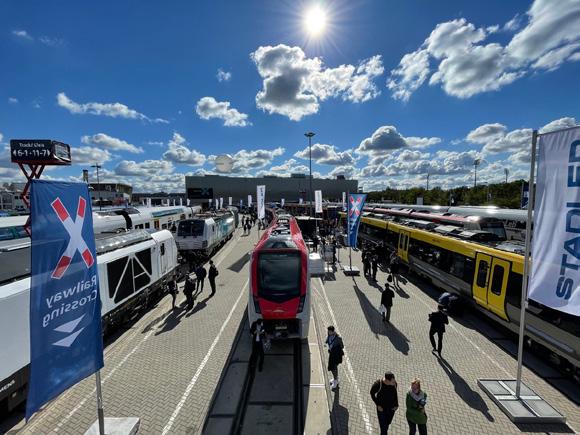
Find out how Railway-News is able to help generate as much footfall and interest in your stand as possible with the following: Targeted Marketing Digital Newsletter LinkedIn Campaigns Easy Search InnoTrans 2024 Digital Newsletter Click here to get in touch and find out more Railway-News is going to InnoTrans!
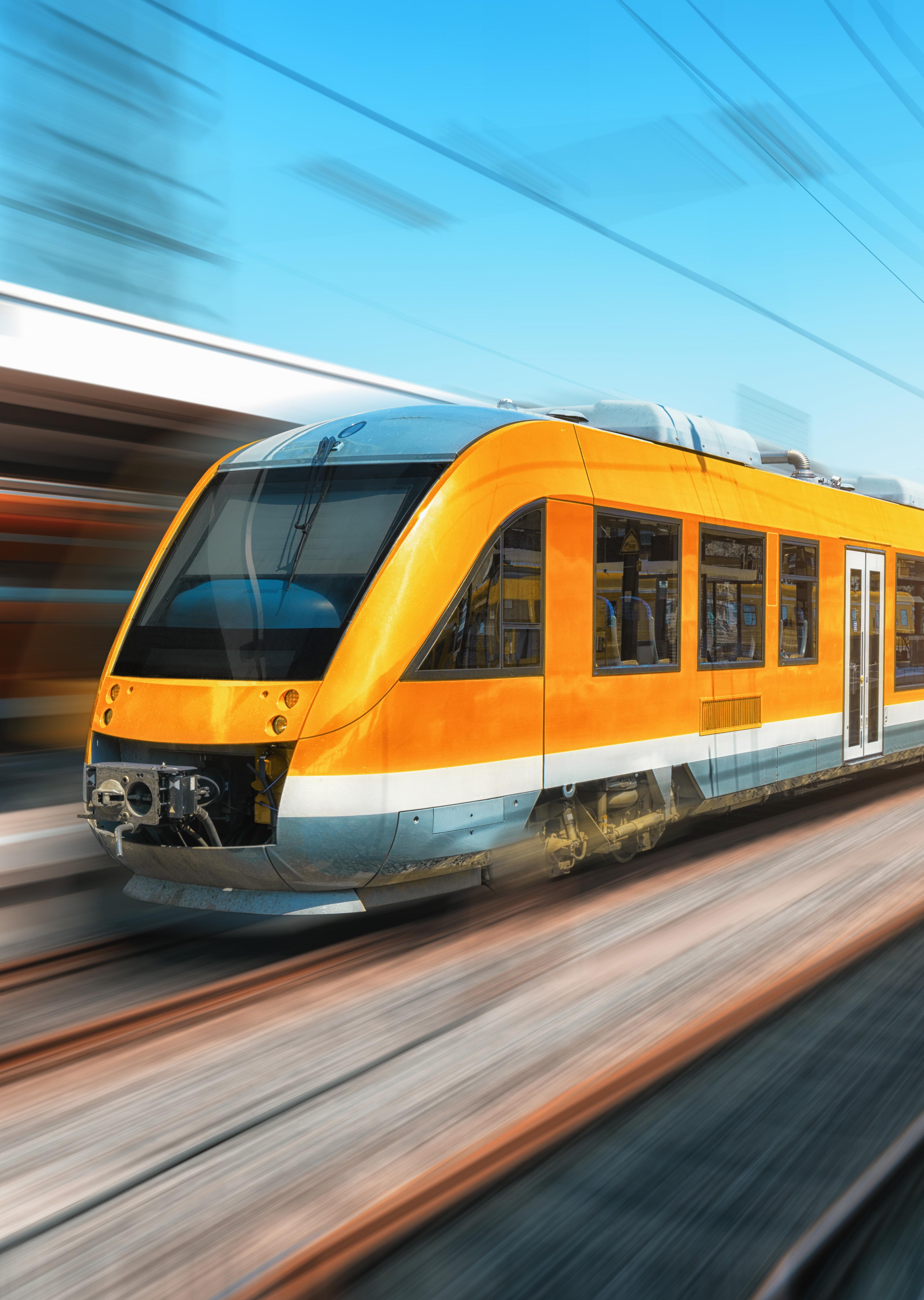

Rolling Stock
Train Interiors
Kiel Americas p.30
Artex p.32
Components & Materials
FreiLacke p.35
HellermannTyton p.38
FinnProfiles p.40
Roxtec International AB p.42
Manufacturing & Maintenance Equipment
Columbus McKinnon p.44
Testing & Measuring Equipment
Evident/Olympus p.47
HEXAGON p.50
Cleaning & Decontamination
Roediger Vacuum GmbH p.52
Directory
29

Kiel Americas
Seating Solutions for Mass Transit
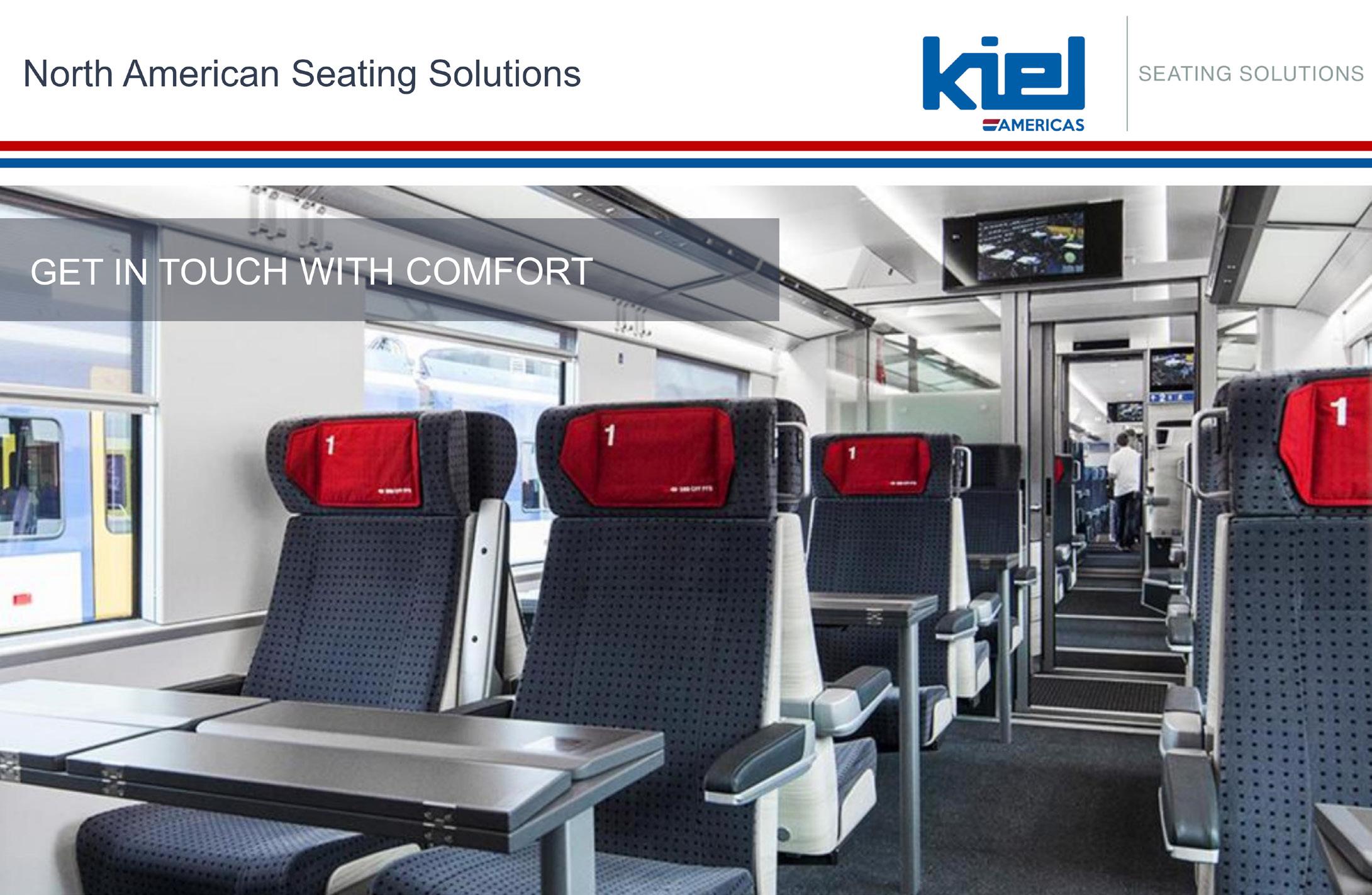
Kiel Americas, as a part of the Kiel Group, has been providing seating solutions for the North American mass transportation industry since 2009.
Kiel Americas employs approximately 150 employees and has full R&D and manufacturing capabilities at its facility located in Bellwood, Illinois. However, we are also part of a global network, with additional production facilities and technical resources in Germany, Poland, Turkey and Macedonia.
Kiel Americas offers a wide range of passenger rail seating systems for local, regional and intercity transport. In the best Kiel tradition, all our seats combine quality, individuality, cost-effectiveness and safety with innovative ideas and attractive, lightweight designs. With a commitment to ergonomic design, durability and space optimisation, we’re not just seating passengers; we're elevating their experience.
With safety always at the forefront of our designs, Kiel engineers have experience working and conducting crash testing in many different countries. Because they
Directory Rolling Stock
30
incorporate standards from a variety of safety boards around the world, Kiel passenger seats have achieved high quality standards.
Kiel Americas utilises modular, recyclable construction systems, aiming to conserve resources and provide as many environmentally friendly options as possible. Most importantly, a Kiel seat can be renovated after 10 years of use by simply replacing the fabric and foam.
When it comes to designing and producing the optimal seat for a given application, Kiel Americas stands behind the slogan ‘It’s up to you’. At the end of the day, it is a question of what a specific country or a specific customer wants. For instance, this can mean a steel structure with steel components, or a composite material base. It is not only the travellers who have specific requirements for seating: Kiel’s customers – the manufacturers of passenger intercity rail cars, commuter rail vehicles and light rail vehicles – expect seats that are increasingly economical, robust and lightweight. Furthermore, Kiel’s customers expect seating that covers all eventualities, from basic to luxury features, depending on the intended purpose. Simply put, it’s up to you.®



To find out more about Kiel Americas visit www.kiel-seating.com, email rkomm@kielamericas.com or call +1 (0) 708 547 – 7000 Train Interiors


Artex Group - Specialist in Seats and Interior Components

Artex designs, redesigns, refurbishes and upgrades seats and other interior components for trains, aeroplanes, trucks and public spaces. With a presence in Sweden, Latvia and now also in Denmark and Finland, Artex employs approximately 500 people.
Artex Expands through Acquisition in Denmark and Initiates Its Own Foam Production in Finland
Artex, a leader in large-scale textile projects for public spaces, public transportation and the automotive industry, is enhancing its offerings in the transportation
sector with the acquisition of the Danish company JP Train, formerly part of JP Group.
JP Train specialises in the disassembly, renovation and assembly of train interiors, and their logistical expertise will now be integrated into the entire Artex group as Artex Denmark.
In the transportation sector, Artex has successfully provided services such as the refurbishment of train seats, involving the reuse of load-bearing structures in steel, aluminium, or plastic, resulting in significant energy savings compared to replacing them with new seats.
The acquisition of JP Train aims to broaden Artex’s expertise and strengthen its market presence in
Directory Rolling
Stock
32
Refurbished seats for the Stockholm metro
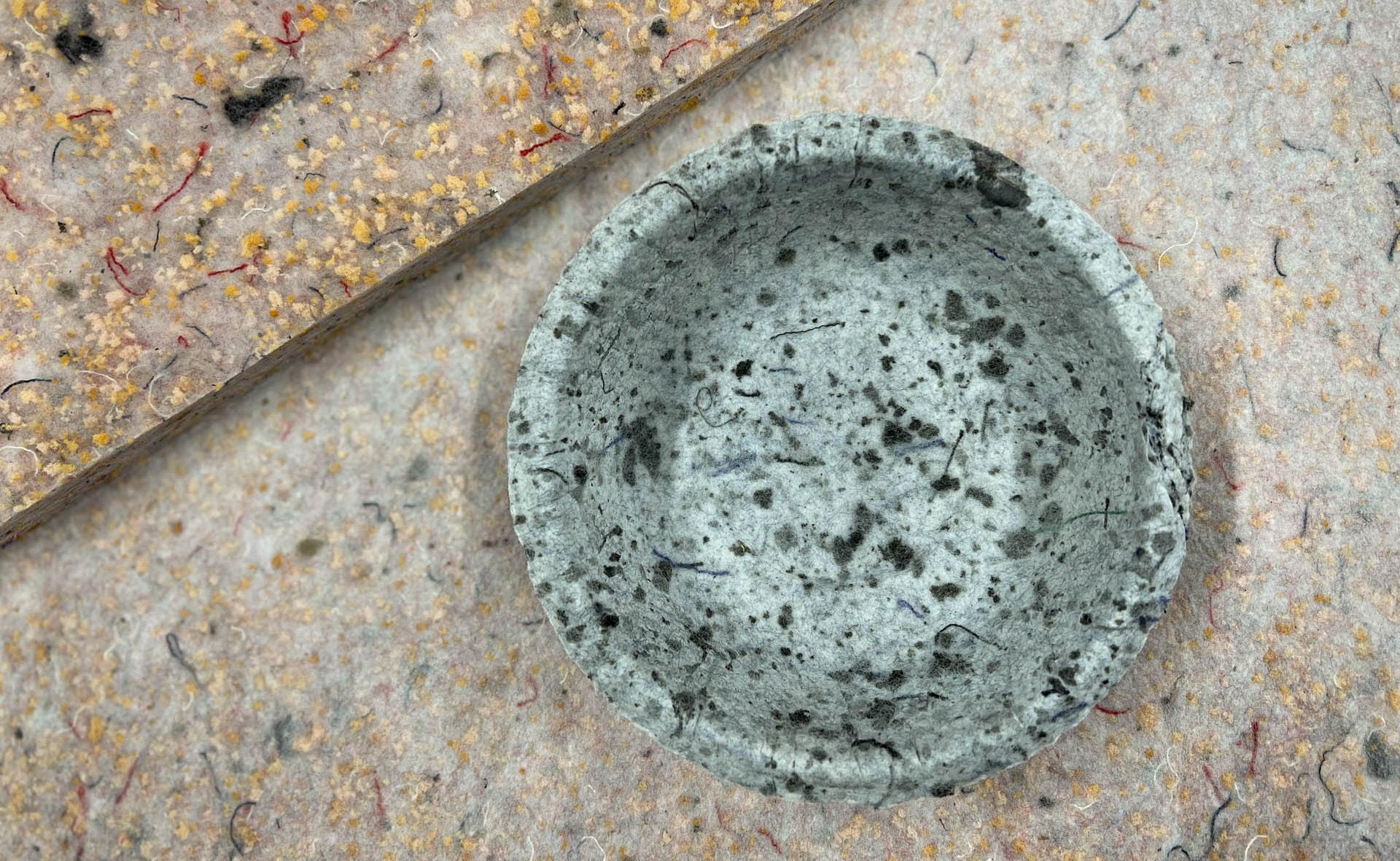
Denmark. JP Train is well-known for its expertise in the disassembly and assembly of interiors in public transportation. This competence will now be an integral part of the Artex group, providing a more comprehensive customer offering.
Artex operates in various business areas, primarily focusing on textile projects for public spaces, public transportation, and the automotive industry.
Björn Samenius, Chief Marketing Officer, explains that this decision is based on Artex’s ambition to be a comprehensive supplier throughout Scandinavia.
Artex Group Strengthening Customer Benefits
The establishment in Finland, with a management and production team that has over 20 years of experience in our field of textiles and foam, means that we are now creating a platform for expansion both geographically and into new business areas. This benefits customers within the Artex group as we can now control and oversee the foam manufacturing process in our projects.
“Refurbishment at Artex implies that the supporting structures in steel, aluminium or plastic are re-used,providing great energy savings.The seats are reupholstered to the latest standards with great freedom of choice regarding customisation,”
Björn Samenius, Artex Group CMO
“We can respond more quickly to our customers’needs and improve delivery reliability,” Björn says.
Refurbishment of train seats is a sustainable choice compared to discarding old seats and buying new ones – Artex is repurposing the waste material from the old seats, such as foam and fabrics, for other products, e.g. sound absorbers and room dividers. Recirculating the material reduces the need for virgin materials and, therefore, the amount of CO2 emissions created in producing new materials.
Environmental and Financial Benefits
Artex offers mid-term refurbishment of train seats, typically taking place after 15 years of service. A new
Train Interiors 33
New material made out of old train seats
seat generates about 205kg of CO2e compared to a refurbished seat that generates about 31kg of CO2e. The savings are multiplied by the number of seats on each train, usually around 10,000 but sometimes up to 100,000. In addition, the climate is half the price compared to buying new seats.
“Refurbishment at Artex implies that the supporting structures in steel,aluminium or plastic are reused,providing great energy savings.The seats are reupholstered to the latest standards with great freedom of choice regarding customisation,” says Björn Samenius, CMO.
Recirculation Creates Value from Waste
To further reduce CO2e, Artex enables the reuse of old foam and fabric for new purposes in other industries. There is approx. 5kg of waste foam and fabric from each refurbished train seat. Artex refurbishes more than 15,000 seats, adding up to more than 75 tonnes of waste material annually.
“Through the help of external experts,we have been able to develop a method to recirculate waste material such that 75 tonnes of waste has been turned into valuable products by others,” says Björn.
The waste material is tested for chemicals, processed into grains and, in some cases, pressed into blocks in preparation for other industries that further refine the recycled material for their products.
“This process reduces the footprint of a refurbished train seat to around 10kg of CO2e,to be set against the 205kg of CO2e of a new seat.The savings in a train with 20,000 seats will be about 4,000 tonnes of CO2e, which corresponds to about 1,000 petrol cars that are driven for a year,” Björn concludes.
Meet Artex at InnoTrans, Berlin, 24–27 September 2024
You’ll find Artex in Hall 5.1/Stand 150. Set up an appointment in advance through info@artex.se or visit artex.se
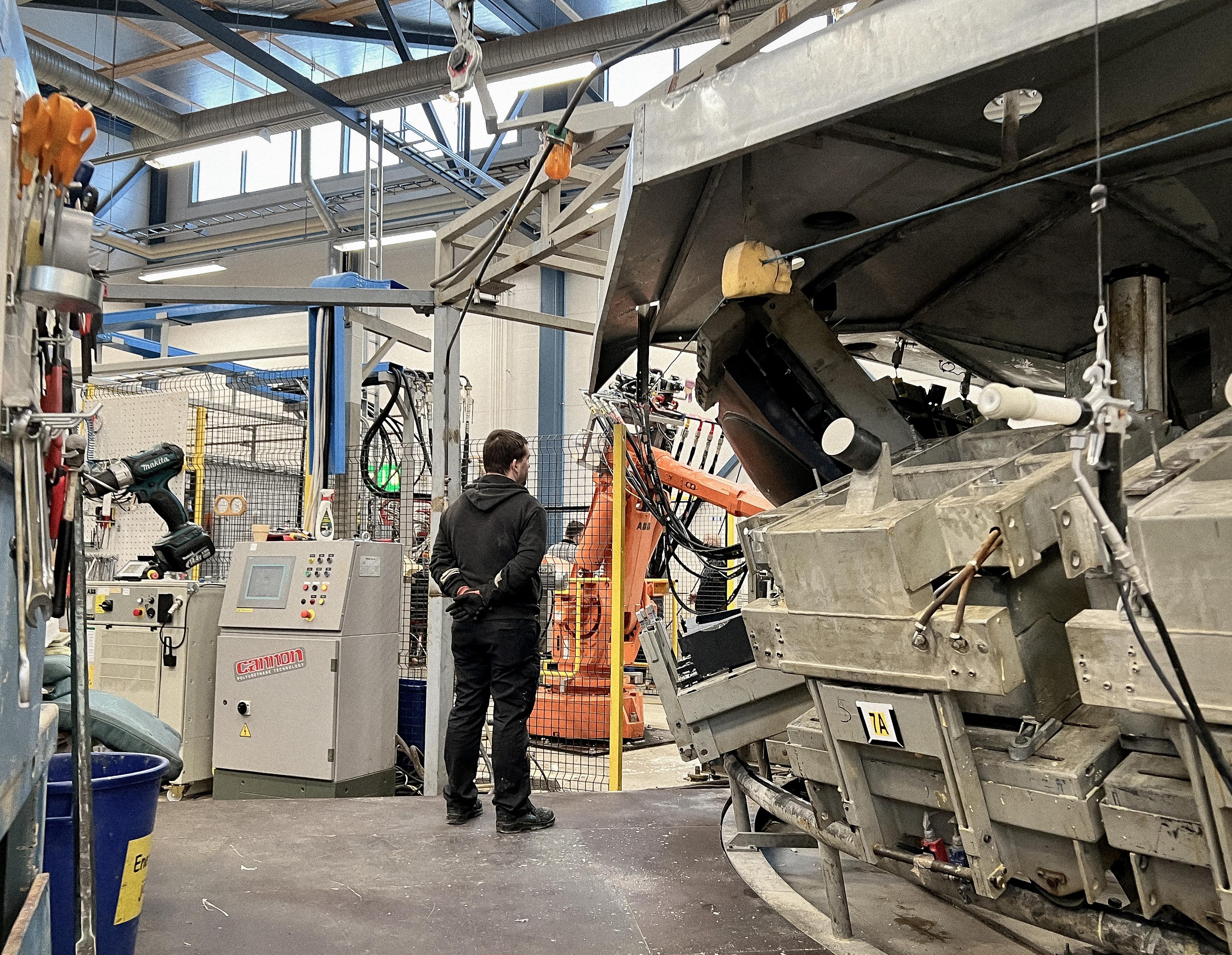
34
Foaming machine and ABB robot in Artex Finland
System coating solutions for rail vehicles
Certified solutions of the highest quality.
FreiLacke has stood for innovative paints and coatings since 1926. The family-owned company has already entered its third generation and develops customised solutions for clients from the wheel and vehicle manufacturing industries, as well as those in the fields of mechanical and apparatus engineering, job coating, functional furniture, rail vehicles, wind power, storage technology, construction and sanitation, directly through its 600 employees at its Döggingen base in the Black Forest.
As a modern family-run company now in its third generation, the safeguarding of the head office is just as important as our worldwide sales and our international subsidiaries and partners.
The product range of Europe’s leading system coating provider covers the entire spectrum from industrial coatings, powder coatings and electrodeposition coatings to composite solutions.
International sales are handled by a global network of subsidiaries and partners around the world.
Environmental protection has always been a key priority for FreiLacke. Therefore, the company makes every effort to develop environmentally friendly products, reduce emissions, packaging materials and waste and use resources sparingly.



Applied solutions. www.freilacke.com Our solutions at a glance (video). Our solutions at a glance (brochure).






























Applied solutions. www.freilacke.com
Composites
Powder Coatings
Liquid Coatings
E-Coats
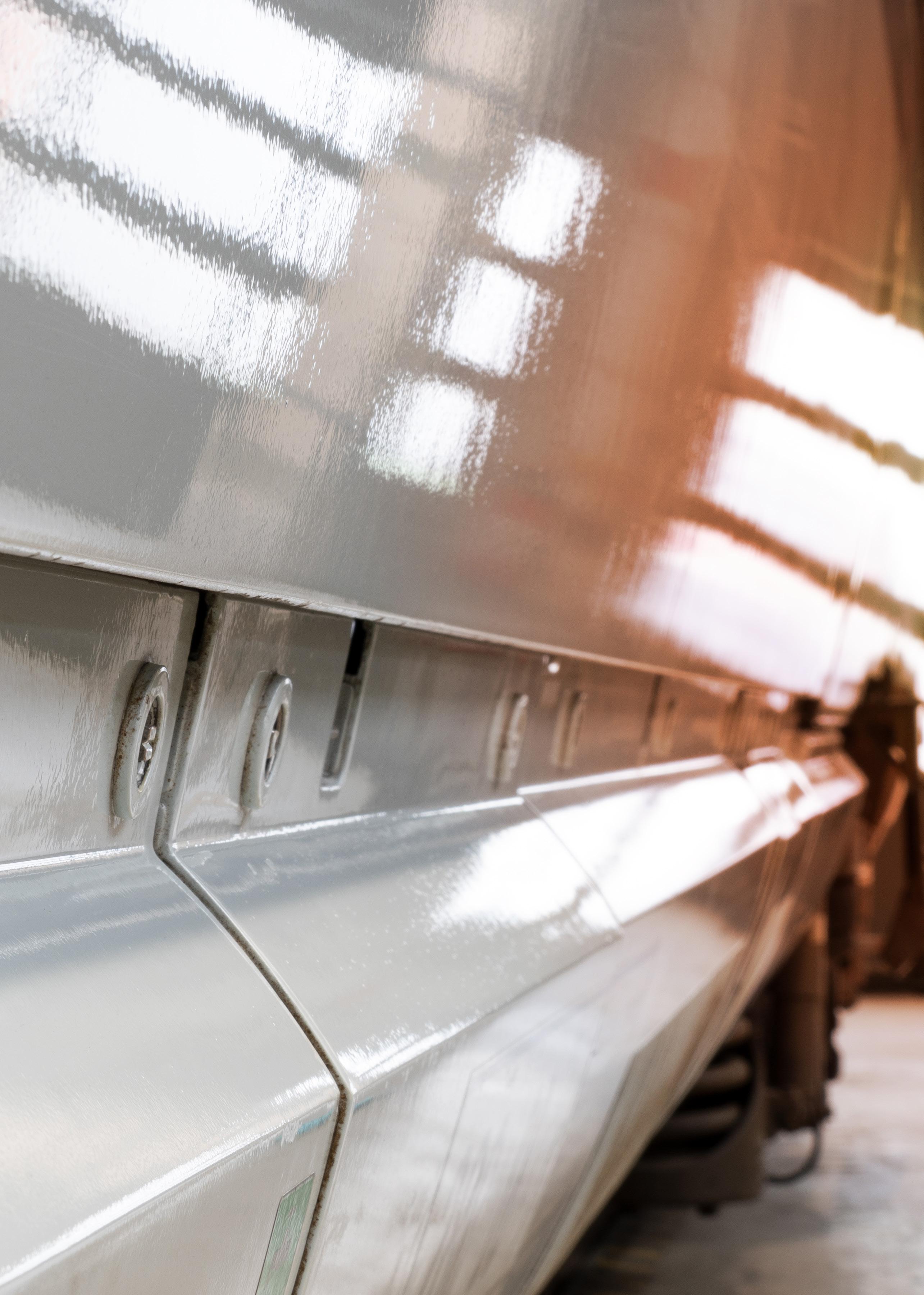

HellermannTyton
How to Bundle Rail Vehicle Cables in Record Time and without Wasting Material
The millions of cable ties used every year in the manufacture of rail vehicles is a testament to their indispensable role.
But when you consider that it takes more than 10 seconds to apply a cable tie by hand, this is a significant amount of time for what is essentially a straightforward process. This begs the question: Is there a more efficient method for large-scale industrial use? Read on to discover a remarkably fast solution that can revolutionise this aspect of rail vehicle wire harness production.
HellermannTyton’s ATS Flex bundling system is a real game-changer in mass processing of cable ties in wire harness production. Not only does it repeatedly complete a bundling cycle in a mere second, it also ensures consistent tying force and eliminates the risk of sharp edges that could potentially injure workers or damage wire insulation during assembly.
Looping, Threading, Tensioning and Cutting at the Touch of a Button
The ATS flex distinguishes itself through its operational simplicity – looping, threading, tensioning and cutting are all executed at the touch of a button. Unlike a conventional cable tie, the ATS strap and locking head are fed separately from two different dispenser reels. This innovative approach allows the tool to automatically feed the strap through the locking head and cut it precisely, ensuring no material wastage.
A key feature of the tool system is its mechanical diameter detection, which is critical to maintaining a
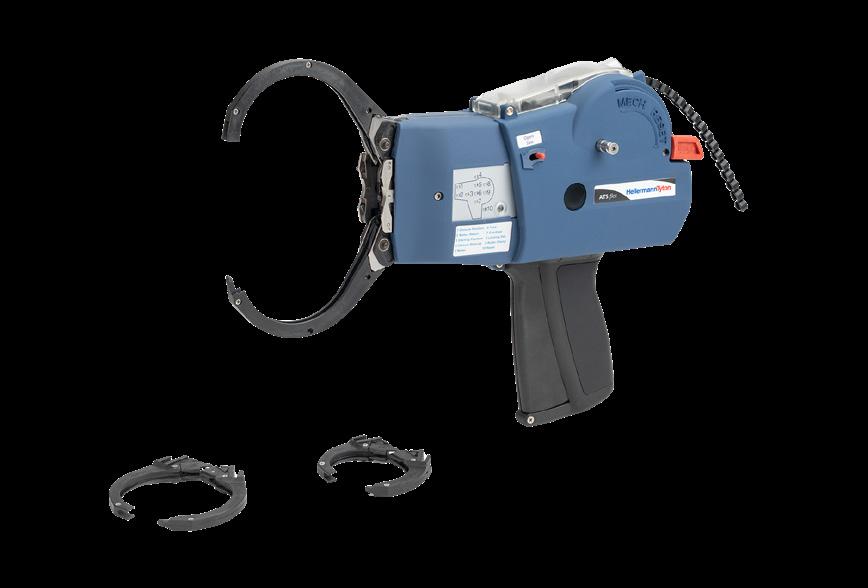
Overhead suspension kit
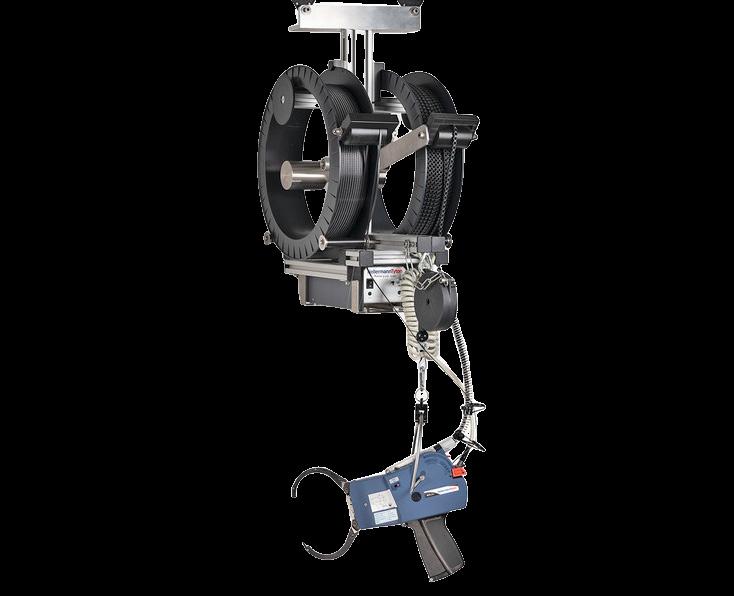
secure fastener in the vibration-intensive environment of rail vehicles. The correct jaw size and speed are automatically determined during the set-up phase. The system is supplied with jaws in three different sizes: 30mm, 50mm and 80mm. These help to optimise the cycle times for different bundle diameters. A 100mm jaw is available separately for larger bundles.
The strap and locking heads are made from PA6V0, which is certified to the EN 45545-2 European railway standard for fire safety. The outside serration of the tie strap is particularly suitable for minimising the risk of damage in applications involving sensitive cable insulation.
Directory Rolling
Stock
The ATS Flex with three different jaw sizes
38


Reducing the Cost of Material Waste
A major benefit of the ATS Flex system is its ability to drastically reduce material waste, in line with the wider environmental objectives of the rail industry. While trains are inherently environmentally friendly once in service, manufacturers still face challenges in minimising the use of resources during production. The ATS Flex addresses this by precisely optimising the length of the tie strap for each bundle, effectively eliminating the need for post-application material removal and the associated waste management processes.
This not only translates to significant savings in material costs, but also in the time and resources spent on waste collection, storage and recycling. By way of illustration, using the ATS Flex system can save approximately 100kg of strap waste compared to the use of 150,000 conventional cable ties, highlighting both the environmental and economic advantages for rail vehicle manufacturers.
Benefiting from Speed and Versatility
The versatility and speed of the ATS Flex make it an exemplary solution for high-volume industrial bundling applications. Its adaptability allows it to be seamlessly integrated into fully automated production lines, mounted on a workbench or used with an overhead
suspension device for manual handling, to suit a wide range of assembly environments. For organisations that use over 200,000 cable ties per year, the return on investment is rapid, with subsequent applications at a fraction of the cost.
In summary, the HellermannTyton’s ATS Flex bundling system offers unrivalled efficiency, safety and environmental benefits for rail vehicle manufacturers. Its ability to speed up cable bundling processes while minimising material waste is a compelling reason for rail vehicle manufacturers to consider this technology.
Click here to find out more about HellermannTyton’s portfolio of cable management solutions for the railway industry, or to request an on-site demonstration of the ATS Flex bundling system.
HellermannTyton manufactures cable management products for fastening, fixing, routing, connecting, insulating, protecting and identifying cables
www.hellermanntyton.com
Components & Materials 39

Directory
Rolling Stock
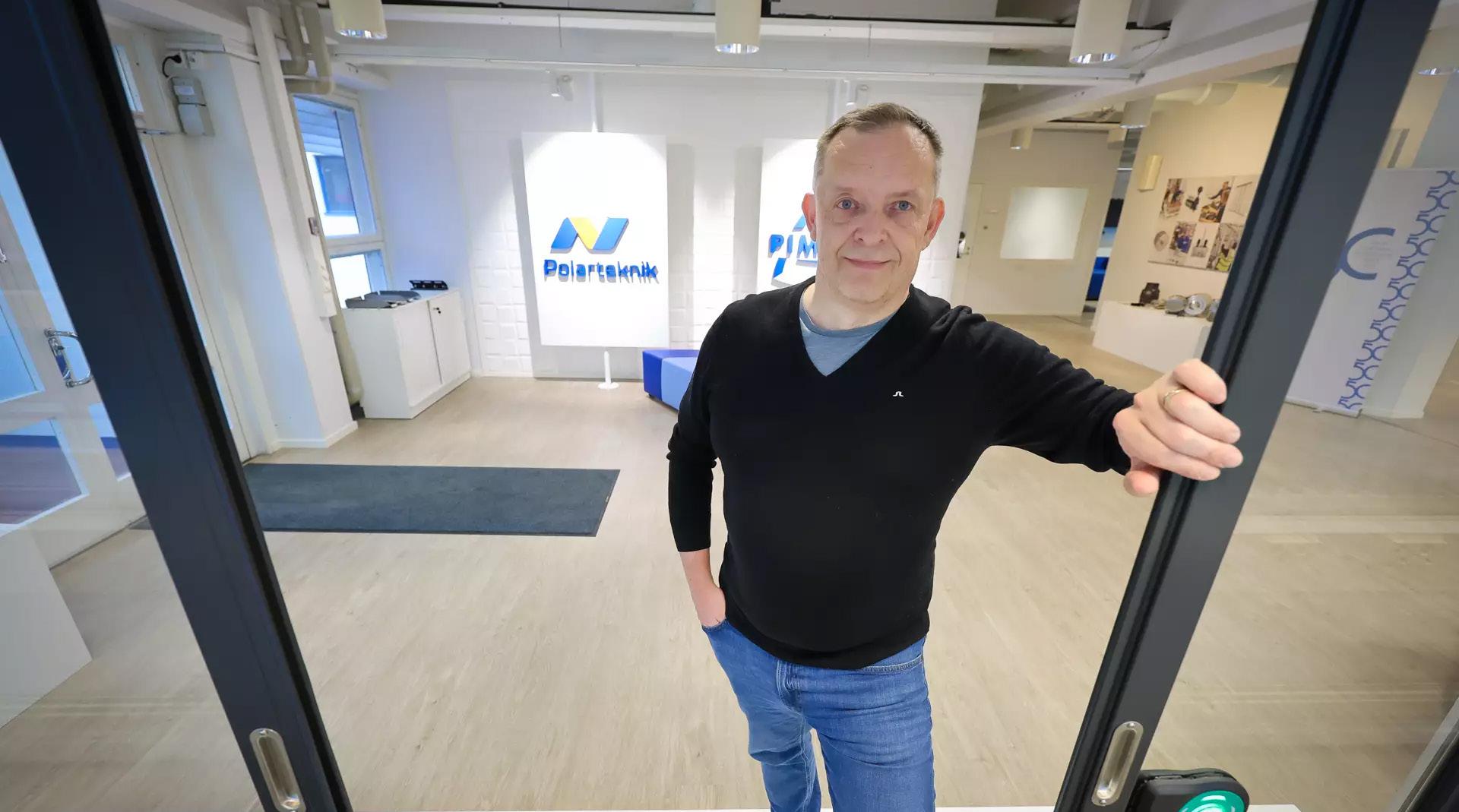
FinnProfiles
“The Quality Is Good, and Deliveries Are on Time!”
Mika Korhonen, Polarteknik’s Business Development
Polarteknik, based in Finland, manufactures reliable, sustainable, highquality interior door systems for the world’s leading train manufacturers.
As you can imagine, seals play a significant role in their door solutions!
Polarteknik and FinnProfiles have collaborated since the early 2000s. Around the same time, Mika Korhonen began working at Polarteknik, where he currently serves as the company’s Business Developer.
We met Mika at Polarteknik’s headquarters in Huittinen and asked a few questions about collaboration.
FinnProfiles: First, could you tell us a little about Polarteknik’s products?
Mika Korhonen, Polarteknik: Well, we produce approximately 4000–5000 train door systems annually,
primarily delivered to Central Europe. The systems can be single or double-leaf doors or telescopic, curved and hinged doors. Additionally, we manufacture gangway cassettes, toilet and cabin doors, each with their own specific requirements.
“Seals contribute to passenger comfort and are associated with many safety aspects.”
FP: How significant a role do seals play in your products?
MK: Each of our door systems contains several metres of seals, so in that sense, seals are a significant part of the structure of our products. Additionally, they contribute to passenger comfort and are associated with many safety aspects, in case of fire and smoke, for instance, that we must consider.
40
Mika Korhonen Business Development at Polarteknik
“The collaboration works extremely well!”
FP: How has the collaboration with FinnProfiles gone so far? What do you particularly appreciate about it?
MK: The collaboration works extremely well! The quality is good, and deliveries are on time. At the same time, we can rely on the fact that our seals are manufactured according to all required standards. In fact, FinnProfiles was one of the first companies to meet our needs when Europe transitioned from national material standards to unified standards.”
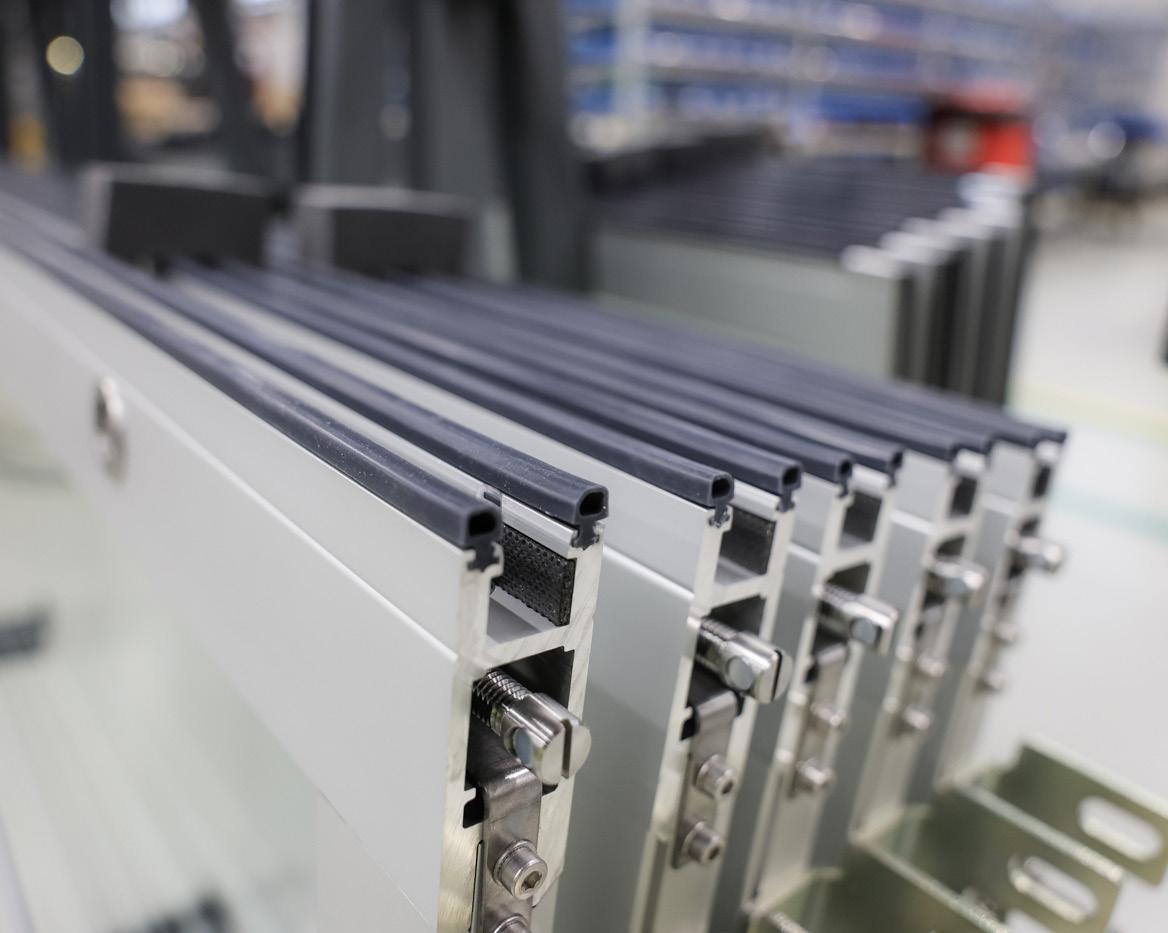

Click here to read more about Polarteknik’s products and services.

Learn more about FinnProfiles’ sealing solutions for the Rolling Stock industry.


 Polarteknik’s employee installing a window seal frame
FinnProfiles supplies several different sealing materials and profiles to Polarteknik.All of them comply with the EN 45545-2 standard
Polarteknik uses several kilometres of sealing material every year
Polarteknik’s employee installing a window seal frame
FinnProfiles supplies several different sealing materials and profiles to Polarteknik.All of them comply with the EN 45545-2 standard
Polarteknik uses several kilometres of sealing material every year
Components & Materials 41
Supplied sealings also include strips to prevent draft and smoke in case of fire

Flexible Seals for Cables, Pipes and Conduits
Lightweight Yet Robust Protection for the Rolling Stock Industry
Designing locomotives, high-speed trains, metros and other rail vehicles is a constant search for the optimised combination of strength, safety and low weight.
To ensure operational reliability and safe transportation of people and goods, and to avoid the risk of damage or downtime, engineers look for the very best components and every detail that can make a difference – such as Roxtec cable and pipe seals. Roxtec has an impressive history of solving problems in the rolling stock industry. Roxtec sealing experts know what it takes to seal off around cables and pipes in fire rated barriers throughout the vehicle structure. They have developed penetration seals that fulfil the highest fire resistance requirements and cover the highest hazard levels. Roxtec has thereby become an important partner for many rolling stock manufacturers around the world, providing innovative seals that ensure certified protection against multiple hazards and offering sealing knowhow, design services and software that enable fit-for-purpose solutions. The Roxtec sealing system is recognised by and familiar to most operators, engineers and installers who focus on speed, safety and sustainability. This has made it convenient to standardise with Roxtec penetration seals to enable success on the global market and to secure easy maintenance and reliable operation wherever the rail vehicle will be rolling.
Developed to Protect Life and Assets
Roxtec provides standard and tailor-made solutions to cover all sealing requirements to help manufacturers ensure passenger safety while maintaining operational
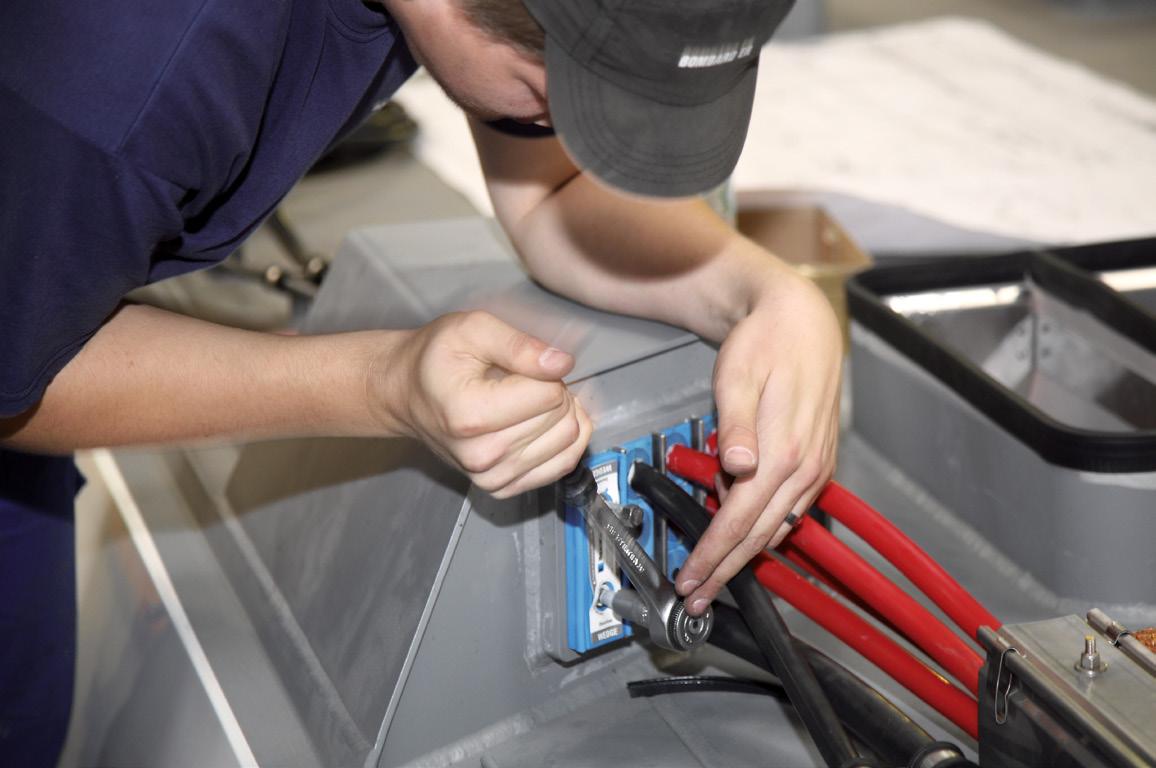
performance throughout the vehicle lifecycle. Roxtec has extensive research and development resources, including a technical centre and a material development lab, and is working together with manufacturer teams to continuously develop efficient seals. The company has advanced fire and test labs where internal and third-party witnessed tests are performed to support the product development process and verify the performance of the Roxtec products. The Roxtec system protects against fire, smoke, dust, water and vibration. The seals are tested in accordance with the major standards, such as EN 45545, NFPA 130, EN 60529 and UL/NEMA.
Tailor-Made Sealing Solutions
Roxtec sealing experts often create and design seals and transits according to specific needs. The team of designers, engineers and test technicians is always ready to take on a sealing challenge, even if it requires the creation of a completely new solution. The certified
Directory Rolling
Stock
42
Roxtec cable and pipe seals are designed for easy installation
and well-proven Roxtec system is often the base for new tailor-made seals, as Roxtec can supply it in other dimensions, with special frames, other rubber materials or bespoke sealing modules. Customisation of seals according to manufacturer needs is part of the service concept which includes everything from design support to fast deliveries.
Smart Engineering Tool
Roxtec Transit Designer™ is the rolling stock design engineer’s shortcut to safety and efficiency. This free, web-based engineering tool simplifies product selection as well as the entire design process that surrounds cable and pipe transits. Users simply enter input, such as cable schedule, sealing requirements and mounting preferences, and the software automatically provides full documentation. There are currently more than 50,000 users in more than 100 countries, and it is free to sign up for the tool on roxtec.com.
Multidiameter™ by Roxtec
Roxtec modular-based mechanical seals are lightweight, compact and openable – and they ensure a perfect fit, regardless of the dimension of the cable or pipe. This is thanks to Roxtec Multidiameter™, an innovation for flexibility based on sealing modules with removable rubber layers. It makes the system adaptable to cables, hydraulic pipes and plastic conduits of different sizes. With only a few parts, manufacturers get a strong reliable barrier against multiple threats. The multicable transits are quick and safe to install from one side of the structure and allow for sealing of several cables, pipes and conduits in the same opening. This allows for high cable density, which in turn allows designers to save space by reducing the size and weight of enclosures and junction boxes. One cut-out is, in fact, enough for routing and sealing of dozens of pre-terminated cables. Another advantage is the builtin spare capacity for additional cables and pipes which simplifies retrofits and upgrades. The seals are available with frames in different shapes and materials, for welding or bolting, and for a variety of applications.
Seals for Any Rail Vehicle Application
Manufacturers all over the world rely on Roxtec because there are so many applications where they can benefit from the sealing system. The transits are available for sealing floors, partition walls and roof
tops. It is used for converters, inverters, motors, brake systems, hydraulic pipes, junction boxes, pantographs, antennas, roof boxes, HVAC systems, air conditioning, switchboard panels and equipment. One example is cable management, cable retention and vibration damping. The area-efficient sealing system is gentle to the cable sheath, but also extremely resistant to pressure and excellent for keeping cables in place to avoid damage. It helps manufacturers extend cable lifetime and ensure long-term functionality.
World Leader in Modular-Based Seals
Roxtec is a global company with a strong local presence that understands the international activities of the leading rolling stock players. Roxtec supports customers and partners in design, production and modernisation across continents and geographies, and is present all over the world to ensure everything from quick support to smooth logistics and just in time deliveries from local stocks. This partner strategy has made Roxtec the world leader within flexible cable and pipe transits for the rolling stock industry.
For more information visit www.roxtec.com.
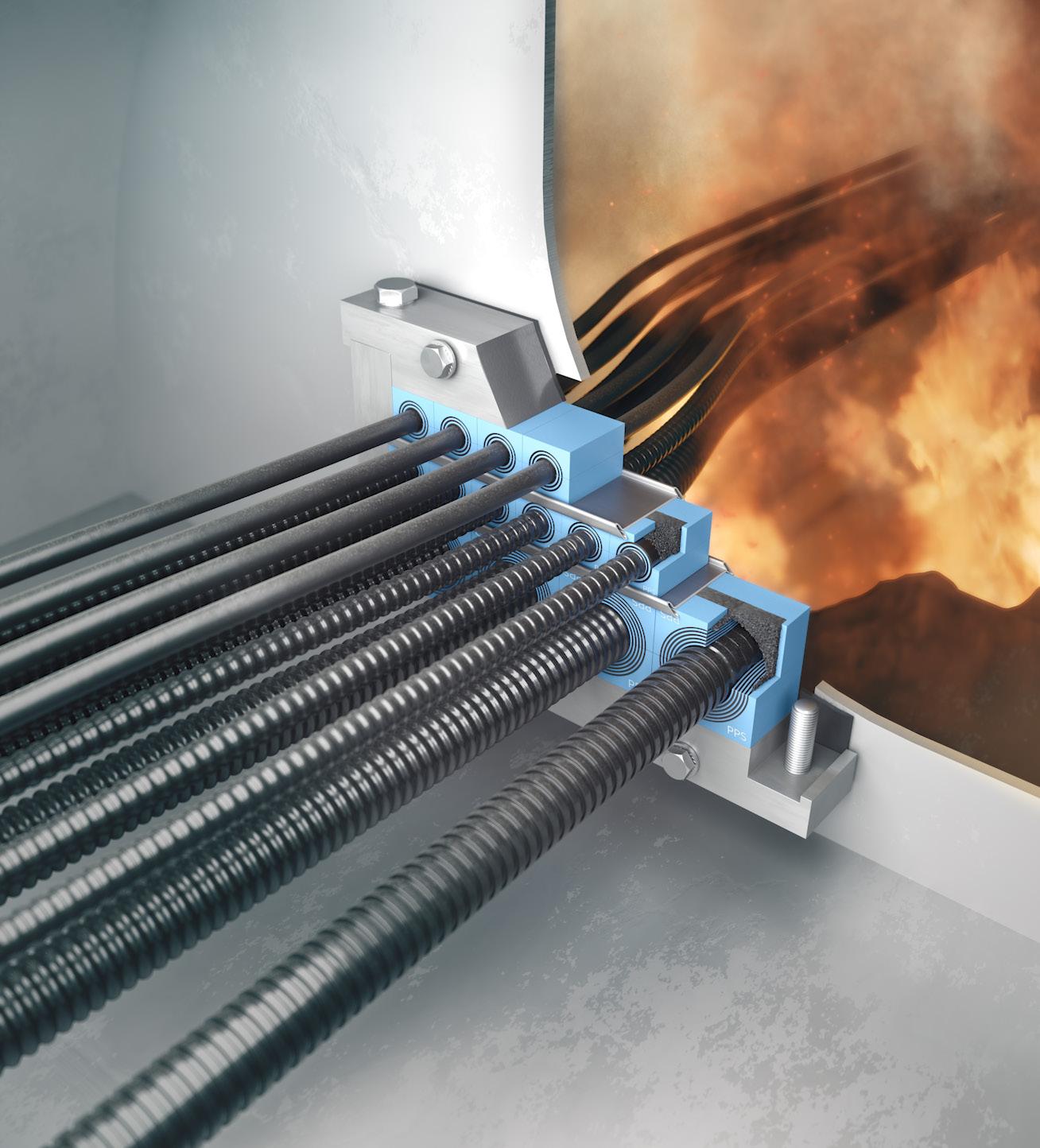
Roxtec sealing solutions provide fire protection for cable,pipe and conduit penetrations Components & Materials 43

Columbus McKinnon
Integrated CMCO Solution Expertise for Railways Worldwide
Since Pfaff Verkehrstechnik was fully merged into Columbus McKinnon (CMCO) in mid-2023, integration within the Group and the mutual support of the Group’s various brands has been further strengthened.
When it comes to project execution, it is not only the Pfaff-silberblau brand that is involved – STAHL CraneSystems and YALE also play their part in the success of the projects. Co-operation within the Group results in new outstanding railway technology solutions, which are realised worldwide together with local partners and subcontractors.
The portfolio of the former Pfaff Verkehrstechnik continues to be expanded under the umbrella of CMCO.
Sister brands YALE and STAHL CraneSystems also make a strong contribution towards implementing specialised railway technology solutions. These include transport components, but also the complete planning, installation and maintenance of turnkey lifting systems for a wide range of railway projects worldwide.
Diverse Projects in Europe
A huge number of major projects have been realised or are underway worldwide. In India alone, large projects are currently in progress at eight different locations, including Delhi, Pune, Bangalore and Mumbai. CMCO is highly active in Europe too – for example for the German Eiffage Group, which requires a Wi-Fi controlled system (10 lifting units for 30 tonnes each) for lifting maintenance vehicles and track-laying machines over a length of up to 110m.

Directory Rolling
Stock
44
Underfloor lifting system for heavy trains with up to seven carriages and a length of 120m
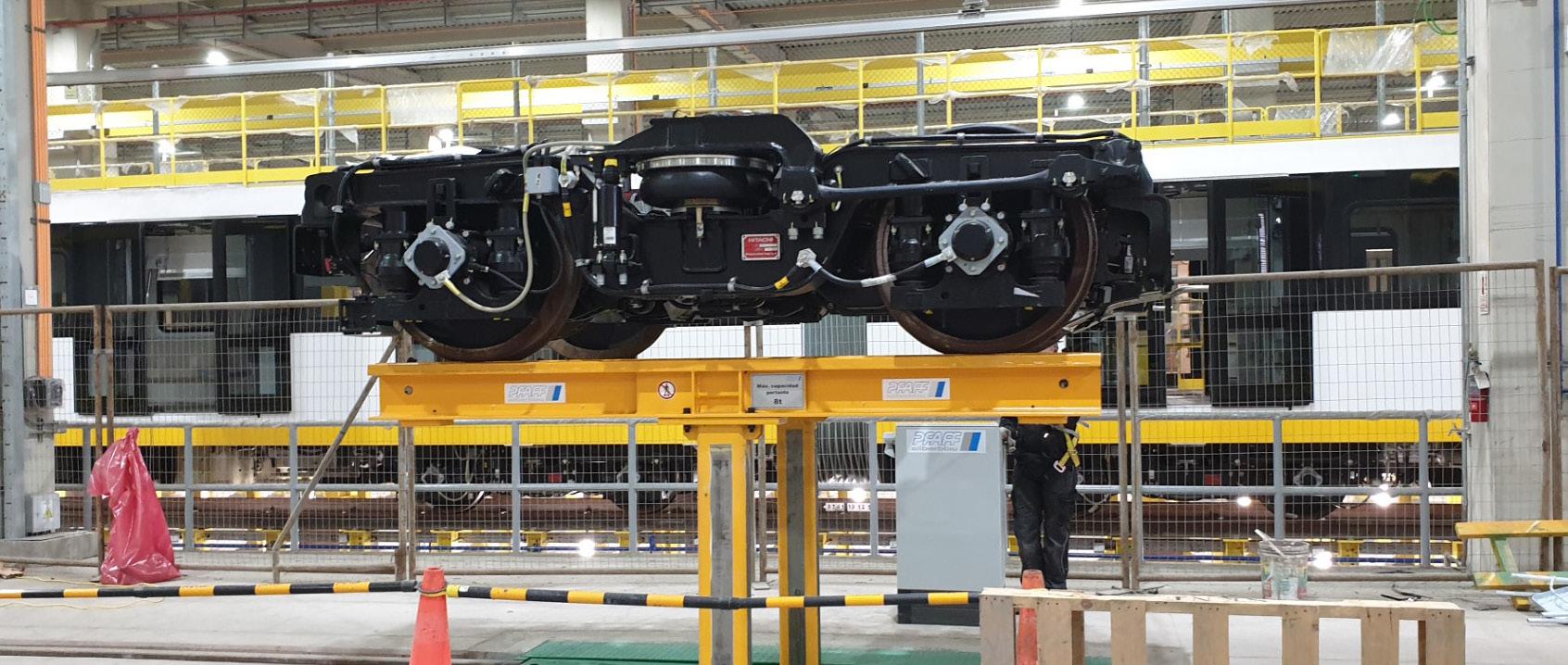
In recent years, for Swiss Federal Railways, existing rail platforms in Basel have been upgraded with roof working platforms, crane rails and service lifts. Skanska AB, a Swedish multinational construction company, also uses CMCO technology – for example to equip a depot in Sävenäs, Gothenburg, including 25-tonne lifting jacks on a rail-guided lifting system with automated laser tracker positioning.
‘Make in India’ Projects
CMCO recently delivered an underfloor lifting system to an Indian customer, HYT Engineering Company. It was manufactured under the ‘Make in India’ initiative, i.e. more than 50% of the production was carried out in India. For the first time, the factory acceptance test of an underfloor lifting system including load tests was carried out on site in India, and was approved in Ahmedabad at the first attempt without any defects. To meet the requirements of the initiative and factory acceptance, Pfaff Verkehrstechnik co-operates with local manufacturing partners, such as STAHL India, part of Columbus McKinnon, and Techno Industries, a leading Indian manufacturer of cranes, lifts and escalators.
Major Projects in Israel
Desiro HC (High Capacity) electric trains made by Siemens Mobility are maintained at the railway depot in Ashkelon, Israel. CMCO has provided solutions to fully equip the depot’s workshop. In addition to track systems, these include an axle changing system,
multiple lifting tables, mobile lifting jacks, hydraulic support jacks, turntables and roof working platforms (‘flying carpets’) for maintenance work on the train roofs. Twenty-four mobile lifting jacks each with a load capacity of 20t are used to lift up whole trains for maintenance and servicing work. The entire lifting jack system is controlled by frequency converters. Synchronisation of the individual lifting jacks makes it possible to lift a train with a precision of ± 4mm.
For maintenance and repair work on the train roofs, all three maintenance tracks were equipped with ‘flying carpets’ by CMCO subsidiary STAHL CraneSystems. These cradles are suspended from crane runways on the workshop ceiling. They can be moved over an extensive range of 175m along the entire length of the workshop and thus along the entire length of the train. Each ‘flying carpet’ has two hydraulically lowerable gondolas that can be operated either as a pair or individually.
Railway Technology in Peru
CMCO has supplied workshop equipment system components for the new Santa Anita depot for the Lima metro in Peru. The entire equipment was installed together with Berlin-based company SIM IMPEX, and includes an underfloor lifting system as well as bogie lifting stands, axle lifting systems (underfloor), mobile lifting jacks, manual turntables, lifting and turning equipment for bogie frames, auxiliary bogies and transport devices in large quantities.
Manufacturing & Maintenance Equipment 45
Underfloor bogie lifting stands in Peru
Major Siemens Order in Egypt
Two years ago, Siemens announced it had received the largest order in the company’s history, from Egypt. The order includes 41 eight-car Velaro high-speed trains, 94 four-car Desiro High Capacity regional trains, and 41 Vectron freight locomotives. Siemens Mobility will provide the latest technology platforms to optimise train operations, the rail infrastructure and subsystems throughout the network.
The Green Line is serviced at the October Gardens depot (west Cairo) to ensure maximum availability. Here too, CMCO has supplied numerous system parts, components and other equipment for the maintenance of the rail vehicles, including underfloor lifting systems for the Velaro and Desiro trains. In addition, lifting and turning equipment for bogies, wheelset changing systems, lifting stands, working platforms and overhead cranes from STAHL CraneSystems have been installed.
All-Round Expertise: Hydraulic Solutions from YALE
In the German rail transport network, Deutsche Bahn uses lifting solutions from YALE, including small hydraulic pumps, to maintain the bogies on DB Regio trains. A PYB cordless battery-powered pump together with the YALE YLS-20/45 low-profile cylinder slightly lifts the train by a little over 2mm so that the wheels can be turned and checked for damage – this is an official railway maintenance procedure that used to be done by hand.
Deutsche Bahn has now opted for the mobile solution with the PYB cordless battery-powered pump, which can develop an operating pressure of up to 700 bar. Applications include the operation of small to mediumsized cylinders, such as the YLS single-acting low-profile cylinder with a lifting capacity of 10 to 100 tonnes and a spring return. Such cylinders are ideal wherever space is limited. They are mainly used for lifting, positioning and clamping.
Normally, the bogie is lifted from at least four points – with this solution, it is sufficient to lift it on one side (i.e. slightly tilted) because the wheel only has to be rotated once to check for damage and cracks, for
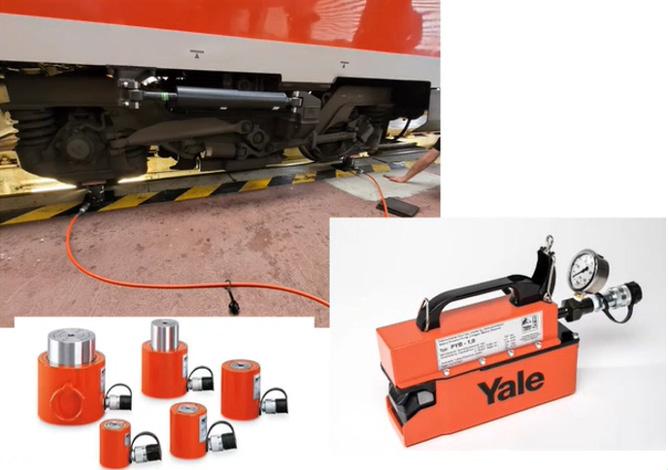
example. However, the CMCO solution also allows the entire bogie to be lifted, by simply replacing the 2-way distributor with a 4-way distributor.
Conclusion
Operators of modern transport systems depend on reliable maintenance and inspection. Equipment from CMCO enables maintenance work to be organised and carried out efficiently with the shortest possible downtimes. As well as supplying transport components, the company also offers complete project planning, installation and maintenance of turnkey lifting systems for all kinds of rolling stock worldwide. The comprehensive portfolio is complemented by various types of roof working platforms, cranes and a wide range of workshop equipment.
A CMCO premiere took place in April 2024: numerous key customers from across Europe met in Augsburg, Germany, for the two-day CMCO Customer Exchange & Show 2024, with a theme of ‘Inspiration, Growth, Partnership’. Here they gained direct insights into the Group’s integrated solution offering.
Click here to find out more about Columbus McKinnon and Pfaff Verkehrstechnik.
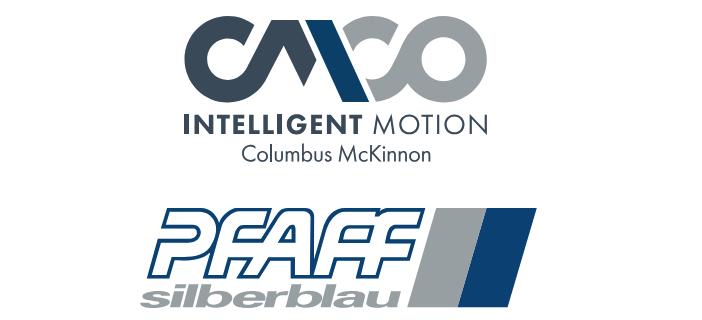
46
Cordless battery-powered pump moves a low-profile cylinder at 700 bar
Railway Wheelset Inspections Made Easy PASAWIS
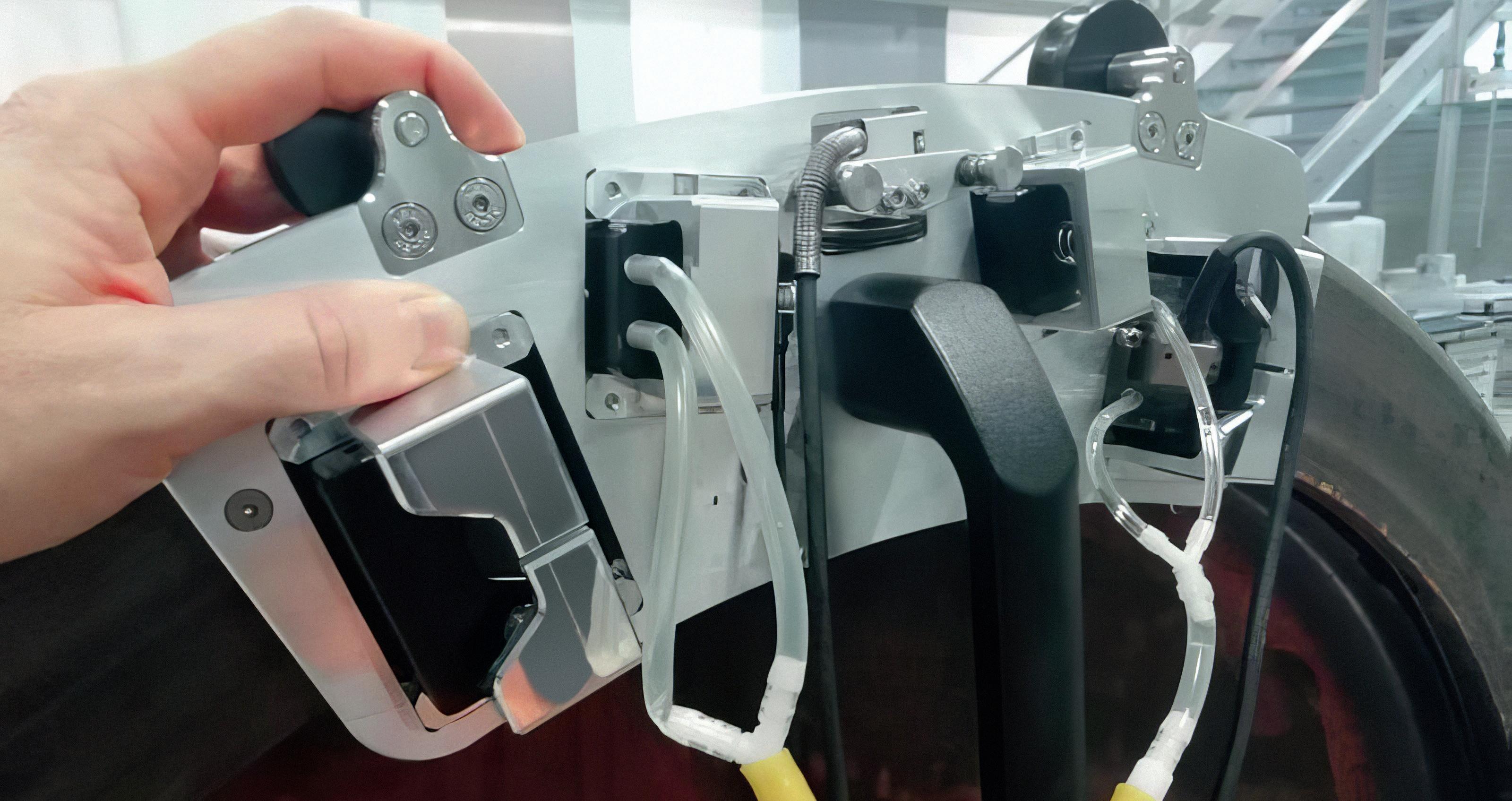
Phased Array Semi-Automated Wheelset Inspection System
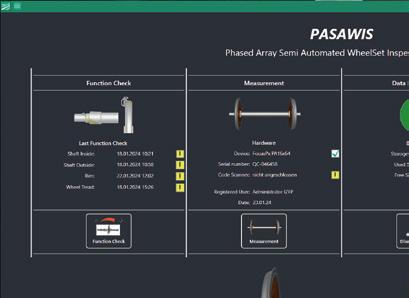

Get outstanding coverage of wheelset components for faster, more efficient inspections with the Evident PASAWIS system. Developed in collaboration with Fraunhofer IZFP and RailMaint, this powerful testing platform combines the latest ultrasonic and phased array scanning technology with dedicated software—meeting the VPI-EMG09 regulation for NDT maintenance. With a complete step-by-step workflow, the software guides you through the inspection procedure from functional check to results and report creation.

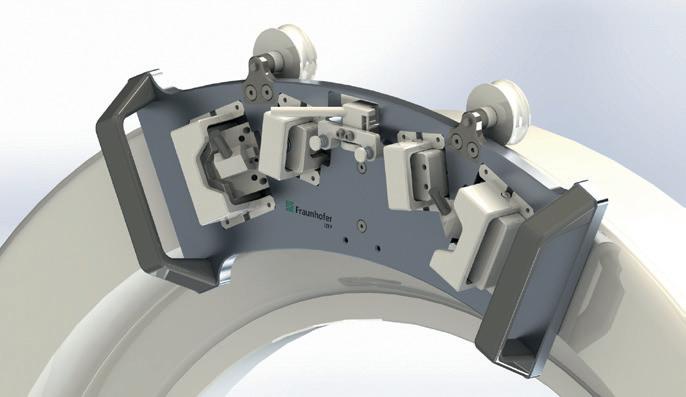

www.EvidentScientific.com
Caffamacherreihe 8–10, 20355 Hamburg, Germany
Three dedicated phased array ultrasonic testing (PAUT) scanners, optimized for the inspection of the wheelset axle, rim, and tread.
New

Evident
PASAWIS: The Comprehensive Solution for Railway Wheelset Inspection
Railway wheelset inspections are vital to ensuring the safety, efficiency and reliability of rail transportation systems.
During operation, wheelsets encounter a high degree of stress, which can lead to wheel wear, fatigue cracks and misalignments that can compromise the integrity of the wheelset and cause knock-on damage to tracks and other rail infrastructure. Detecting these issues as early as possible is key to preventing accidents, derailments and other safety hazards.
Nondestructive testing (NDT) of rail wheelsets can be a time-consuming and laborious task when approached via manual conventional ultrasonic testing (UT) or phased array ultrasonic testing (PAUT) methods. This is primarily due to key components such as the axle, rim and tread being difficult to access, meaning that wheelset disassembly is sometimes necessary to complete inspections to a satisfactory standard. Following disassembly from the carriage, it can still be challenging to access key components for inspection, requiring multiple probes to be set up at various angles to gain an appropriate level of coverage. This
lengthy and cumbersome workflow can have significant financial implications, from increased railcar downtime to labour costs. Manual UT/PAUT inspection results are highly human-dependent, and as such, prone to operator errors. Furthermore, manual inspection data often lacks traceability since the data is volatile, and not always stored on a local system.
The PASAWIS (Phased Array Semi-Automated Wheelset Inspection System) is a next-generation, all-in-one solution that makes wheelset inspections substantially more efficient, faster and more reliable. Developed by Evident, in collaboration with Fraunhofer IZFP and RailMaint, this powerful testing platform meets the requirements of the VPI-EMG09 regulation for the maintenance of freight cars through the implementation of NDT.
Wheelset Inspections Made Easy
PASAWIS is a UT platform that uses a combination of the latest ultrasonic and phased array scanning technology and custom software to gain unparalleled coverage of wheelset components. In comparison to traditional UT platforms that utilise a series of single

Directory Rolling Stock
PASAWIS brings customised scanners,portability and data reporting into a compact unit
48

element transducers, PAUT probes contain an array that accommodates multiple elements. This enables the PAUT probes to generate wide angled beams, providing a more comprehensive picture of wheelset components and increasing the probability of detecting potentially dangerous indications.
PASAWIS comes equipped with three hand-held scanners, each optimised for a different wheelset component (axle, rim, tread). These optimised PAUT scanners are designed to fit flush with each wheelset component to accelerate inspections and gain complete coverage to ensure that all relevant indications, including wear and cracks, are not missed. Supporting wheelset inspections, dedicated PASAWIS software provides a number of pre-defined inspection programmes, also optimised for each wheelset component. Integrated into the system is the software interface, a large touchscreen monitor that provides a clear visualisation of wheelset components and test data.
Another major benefit that PASAWIS provides is its high degree of mobility. The system is compact, and comes with wheels for easy manoeuvring. This highly mobile system can be deployed anywhere, and can be operated by a single person, making it suitable for almost any workshop environment.
Automated Data Storage Like Never Before
In addition to making inspections quicker and easier, PASAWIS provides robust data storage capabilities. Unlike other wheelset inspection tools, PASAWIS enables full storage of all inspection test data. Inspection parameters and test data can be
automatically uploaded to cloud-based document management platforms, or instead transferred to central storage systems via USB, Wi-Fi or LAN. This enables long-term traceability and reproducibility of inspection data.
Once the inspection is complete, PASAWIS creates inspection reports with minimal input. Graphical results for each wheelset tested, e.g. A-scan, sectorial image and C-scan, as well as several key metadata such as calibration date, instrument serial number and inspector are included in the report, which comes in PDF format. Each inspection report has a unique digital signature to ensure data security.
Ready to Take Your Wheelset Inspections to the Next Level?
Developed by trusted partners with decades of industry experience, PASAWIS is the comprehensive solution for wheelset inspections. With the latest PAUT technology, optimised scanners, high portability and robust data storage and security, PASAWIS can help to reduce the time and costs associated with wheelset inspections, while providing a more comprehensive picture of wheelset health versus other manual scanning methods with the human factor on inspection results limited to a minimum.
Want to find out more? Contact our expert team today!
 Three dedicated PAUT scanners,optimised for inspection of wheelset axle,rim and tread
Three dedicated PAUT scanners,optimised for inspection of wheelset axle,rim and tread
Testing & Measurement Equipment 49


HEXAGON
Automated Wheelset Measurement System Enables
Predictive Maintenance
Case Study: Wiener Linien, Vienna, Austria

To enhance their rail vehicle maintenance operations, Wiener Linien selected Hexagon’s CALIPRI X automated wheelset measurement system because of its quick, exact and reliable wheel profile measurement capabilities.
Clarity on wheel wear conditions allows more efficient condition-based and predictive maintenance, less downtime, better resource planning and significantly reduced maintenance costs.
But safety is the paramount priority in rail. To ensure the safe operation of rail vehicles, all wheels must be measured at frequent, regular intervals to ensure all operating tolerances are adhered to. Looking to
improve the efficiency and reliability of this process, Wiener Linien assessed various options available on the market that would allow them to increase the productivity of their maintenance operations. After a rigorous selection process, they chose Hexagon’s CALIPRI X automated on-track solution for precise train wheel profile measurement.
Unrivalled Technical Concept
Wiener Linien currently has three CALIPRI X wheel measurement systems in use for their rail vehicles. The first system was installed at the Erdberg site in June 2022 and by 2025 they will have a total of nine systems in use. Even before the first CALIPRI X overrun system was installed, Erwin Quintus, Technical Referent in the Rail Vehicle Technology department at Wiener Linien,
Directory Rolling Stock
50
was impressed by the capability of the technology to provide quick, exact and highly reliable wheel profile measurement. “Hexagon’s product prevailed over other well-known suppliers in an international tender.In addition to economic points,the CALIPRI X product was able to set itself apart from the competition primarily through its technical concepts,” says Quintus, who has been working with wheel measuring systems for over seven years.
Making Condition-Based and Predictive Maintenance Possible
Fundamental to improving maintenance efficiency is the ability to reliably capture accurate and very precise measurement data that can be used to determine the ideal maintenance activities and times and plan workshop resources accordingly. The other key consideration is how to carry out the measurement process with the highest degree of efficiency. With CALIPRI X, a single pass over the permanently installed system is sufficient to obtain all wheel parameters and wheel profiles. Measurements are taken using a laser light section method, with all wheel profiles of the vehicles recorded. The most important parameters and variables are known in seconds, and out-of-tolerance areas immediately identified. The data generated by CALIPRI X is then processed in Wiener Linien’s specially developed in-house software. This determines the ideal maintenance time and the necessary maintenance measures to achieve the longest-possible wheel service life with the most even workshop utilisation possible. “It’s absolutely essential to have very good raw data for this,which the CALIPRI X system gives us,” emphasises Quintus. Unplanned or unnecessary downtimes are avoided, workshop planning is improved and wheel service life can be significantly increased.
Measurement Repeatability, Time and Cost Savings
In addition to improved maintenance efficiency and higher vehicle availability, the system also benefits Wiener Linien by reducing the workload in their workshops. Workshops worldwide are facing the major challenge of a shortage of skilled workers. Installing an automated wheel measuring system enables Wiener Linien’s vehicle technology department to deal with this and save time and money. “In times of staff
shortages,the automation that CALIPRI X brings is essential to us,” says Quintus.
Before using the system, like most of the industry, the Wiener Linien maintenance team still manually measured subway wheels. However, the manual, conscientious measurement of rail vehicle wheels was highly labour-intensive, time-consuming, less accurate and meant long vehicle downtimes.
The wheel profile, or, to be more exact, prominent points of the wheel profile, were measured using hand gauges attached to the wheel. However, the accuracy of such measurements is far from those of an automated system because only prominent points can be measured, not the entire wheel profile and results can also depend on the experience of the person making the measurements. Using mechanical gauges, it takes about 2.5 hours to measure all 48 wheels on a subway train. In comparison, with CALIPRI X, all 48 wheel profiles are determined in a single pass, with measurement data available in seconds after the pass. The system operates entirely autonomously, delivering exact results with unmatched repeatability. The employees’ only task is to periodically clean the system’s measuring glasses of dirt based on the weather conditions.
And because CALIPRI X has been installed directly in front of the car wash, one pass, including measurement, has been integrated into the daily process sequence, and several vehicles drive over this system daily. Making more measurements means more data on wheel wear is available for analysis, allowing Wiener Linien to accurately forecast wear levels.
“Measurement repeatability is in the tenth of a millimetre range.” Erwin Quintus, Technical Referent, Wiener Linien.
Click here to download the case study.
www.nextsense-worldwide.com/en


Testing & Measurement Equipment 51

Roediger Vacuum GmbH
In Any Weather: Supply & Disposal Systems for Norwegian Trains
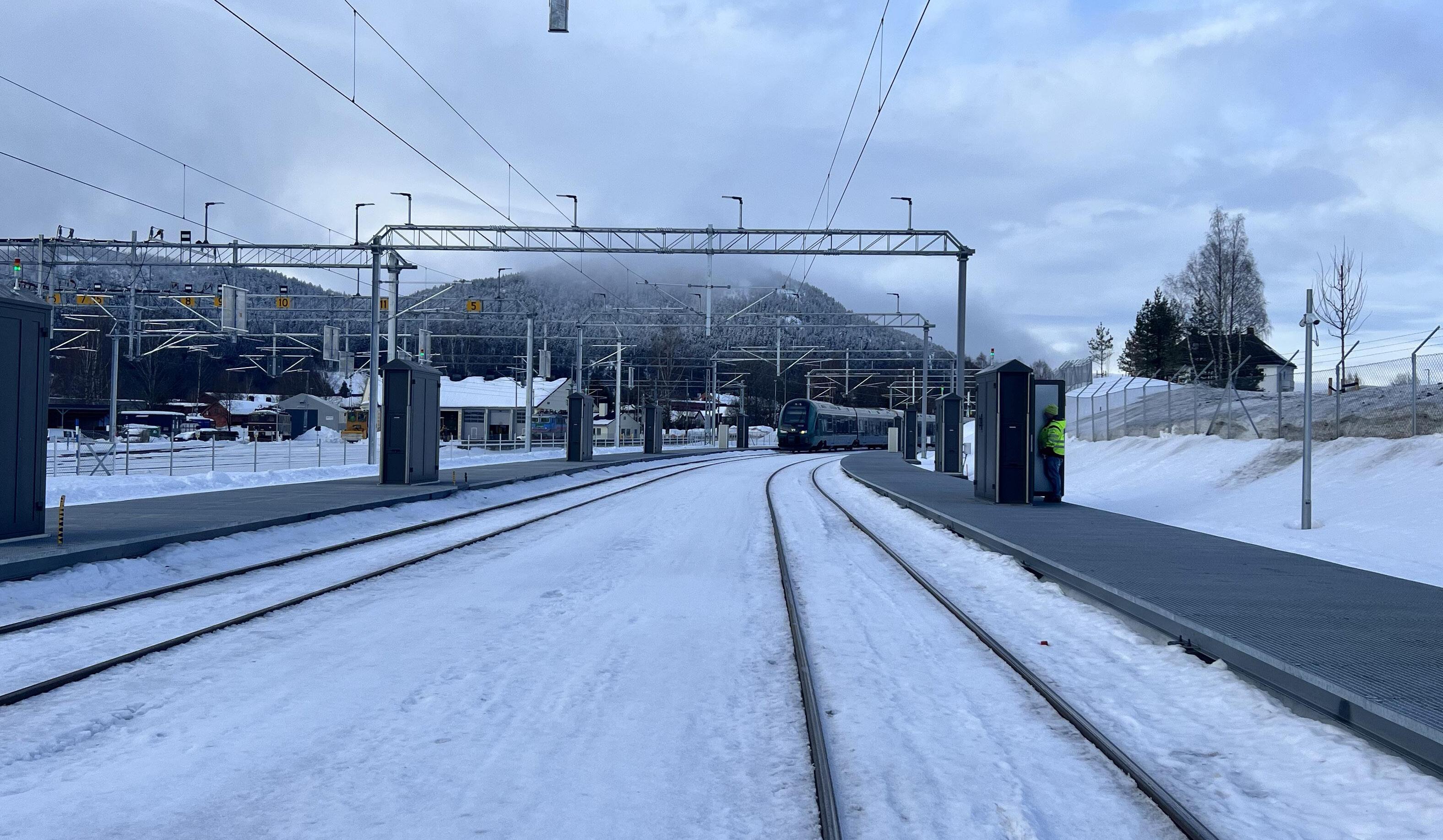
Norway, the land of the midnight sun and deep fjords, experiences extreme temperature and weather fluctuations. This requires particularly robust technology for servicing the trains.
Along the coasts, the climate is comparatively mild and oceanic, influenced by the Gulf Stream. Inland, on the other hand, winters can be extremely cold, with temperatures often dropping as low as -30°C. These contrasting weather conditions characterise life in Norway and pose a challenge for infrastructure such as the railway.
Bane NOR and the Challenges of Rail Transport
The state-owned railway company Bane NOR is responsible for the operation and maintenance of Norway's rail network, which stretches over 4000km and connects major cities and regions. Coping with extreme weather conditions, especially in winter, places special demands on staff and infrastructure. Trains must be equipped with robust heating systems to keep passengers comfortable even in freezing temperatures, while the tracks must be regularly cleared of snow and ice to ensure safe operation. In addition, Bane NOR staff must be trained and equipped to respond quickly
Directory Rolling Stock
52
Supply and disposal cabinets in Kongsberg
and effectively to emergencies and ensure the reliability of rail transport even in the most adverse conditions. Despite these challenges, the railway plays a crucial role in Norway's transport system and provides a reliable and environmentally friendly transport solution for the country's population and economy.
Innovation in Supply and Disposal Technology for Bane NOR
In the world of rail transport, efficiency and reliability are of paramount importance. When it comes to supply and disposal of passenger trains in the service depots, Bane NOR relies on Roediger Vacuum from Germany and their local partner Dahlrail.
A key component of the supply and disposal systems are the cabinets on the platforms, where the hoses for drinking water, rinsing water and wastewater are stored. These cabinets are specially designed to function reliably even at extreme temperatures of down to -30°C.
The service depots in Kongsberg and Sundland in the surroundings of Oslo and another depot in Bergen on the west coast of Norway are equipped with Roediger cabinets. These cabinets have hose reel systems with hoses of up to 15 metres in length. Hose-reel systems with electric motors make the operator's work easier and ensure smooth and ergonomic operation.
Another decisive factor is the high efficiency of the Roediger vacuum system. One high-performance vacuum station per location is sufficient to supply the entire system with a constant vacuum. Compared to conventional double-pump systems, Roediger systems are maintenance-friendly and require significantly less energy, which reduces operating costs and contributes to sustainability.
Remote Monitoring for Reliable Supply and Disposal Systems
In the modern world of infrastructure, reliable remote monitoring is crucial to ensure smooth operation and efficient maintenance of equipment.
Train service depot in Kongsberg

Cleaning & Decontamination 53
Image:

Roediger Vacuum recognises this and offers advanced solutions for remote monitoring of supply and disposal systems in Norway.
The supply and disposal systems in Norway include state-of-the-art remote monitoring technology. By integrating sensors and IoT technology, these systems can be continuously monitored to record the condition of the systems in real time and detect potential problems at an early stage.
Remote monitoring allows operators to remotely monitor key parameters such as vacuum level, temperature, flow rates and physical faults in the supply and disposal systems and networks and to take immediate action if necessary. This not only helps to reduce downtime and avoid operational disruptions, but also enables maintenance work to be planned more efficiently and resources to be utilised in the best possible way.
Another advantage is the possible initiation of predictive maintenance work. By analysing data and identifying trends, potential problems can be predicted even before they occur. This allows operators to act proactively and minimise unscheduled downtime.
With Roediger’s advanced remote monitoring technology, supply and disposal facilities in Norway can ensure smooth operation while maximising efficiency and reliability. These innovations help to strengthen the country's infrastructure and ensure sustainable operations.
Harsh Site Conditions
The installation of enclosures and vacuum pump stations on construction sites in the cold north is a particularly demanding challenge. In regions with the extreme weather conditions, the enclosures and systems must not only be robustly built, but also specially insulated and protected from the elements. Site conditions often require the use of skilled labour that is familiar with the challenges of the Arctic climate and able to work efficiently in adverse conditions.
In addition to the construction of the systems, the vacuum pumping systems must be designed and built to function reliably even at extremely low temperatures. This requires not only the use of high-quality materials, but also careful planning and installation to ensure that the systems can operate efficiently even under the harshest conditions.
roediger-vacuum.com
For more information contact
 Andreas Bayerlein Roediger Vacuum GmbH andreas.bayerlein@roediger-vacuum.com
Andreas Bayerlein Roediger Vacuum GmbH andreas.bayerlein@roediger-vacuum.com
54
Installation of supply and disposal cabinets inside a service tunnel in Bergen
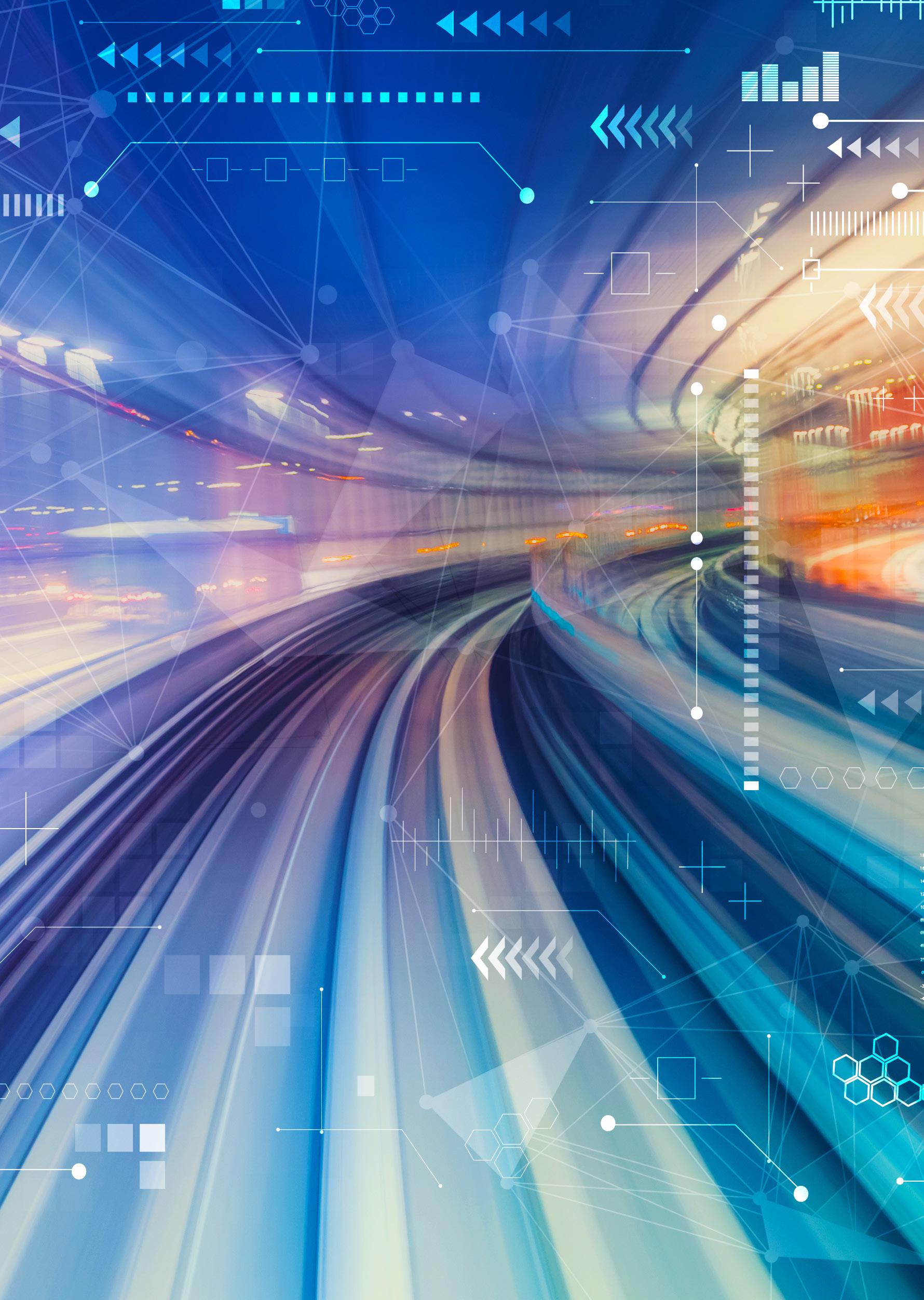

Data & Monitoring
Planning & Management Software
netwiss p.56
Communications Technology
VIAVI Solutions p.58
Calian p.61
Computers & Sensors
NEXCOM International Co., Ltd. p.62
Arentis Limited p.65
Revenue Management & Ticketing
ExPretio p.68
Signalling
& Train Control
Viper Innovations p.71
Condition Monitoring
Yeltech Ltd p.74
Duos Technologies, Inc. p.77
Directory
55


Improved Ecological Footprint through Customer-Orientated Vehicle Layout
Vehicle layouts that meet the needs of travellers are not only much more comfortable and popular, they also significantly improve the ecological footprint. How is this possible?
If, under the mistaken assumption, an attempt is made to increase capacity and thus profits by having as many seats as possible on the train, the opposite of the desired result usually occurs. 20 years of research and development by netwiss in co-operation with the Vienna University of Technology clearly show that the luggage accommodation in these layouts is undersized and at the same time does not meet customer requirements. As a result, a lot of luggage is stored in such a way that it obstructs seats and aisles, thereby reducing the actual capacity and significantly increasing the dwell time in the station. As a result of the extended dwell time, the travelling speed often has to be increased to the maximum permitted in order to keep the timetable, which results in an increased energy requirement of up to 20%!
Optimised vehicle layouts clearly help to save energy and therefore money, thereby also significantly reducing the ecological footprint! On top of this, the capacity in the wagon can be increased and customer satisfaction significantly improved.
For many years, we have been helping operators and manufacturers to significantly improve their vehicles by taking a few very simple steps. We offer the following services:
1) We advise manufacturers, operators, planners or purchasers and others from the very first planning step and help to optimise all designs in terms of efficiency from the beginning. We also analyse existing vehicle
concepts and help to increase efficiency, e.g. with regard to redesign.
2) We offer the special software tool TrainOptimizer®, which is very easy to use and with whose help you can assess and thus optimise vehicle layouts yourself with regard to their efficiency.
With very little additional effort in the planning phase, very high costs can be saved during operation and the operating quality can also be significantly improved. Our customers include DB, SBB, ÖBB and many more, with projects such as the Railjet, ICE3, ICE4 and ICE-L, SBB double-decker trains and many more.
Click here to watch our TrainOptimizer® video.
Are you curious about the possibilities of improving your vehicles? Then visit us at www.TrainOptimizer.com Here you will find valuable information and videos on how to get the best out of your vehicles in just a few steps, or simply contact us at: info@TrainOptimizer.com
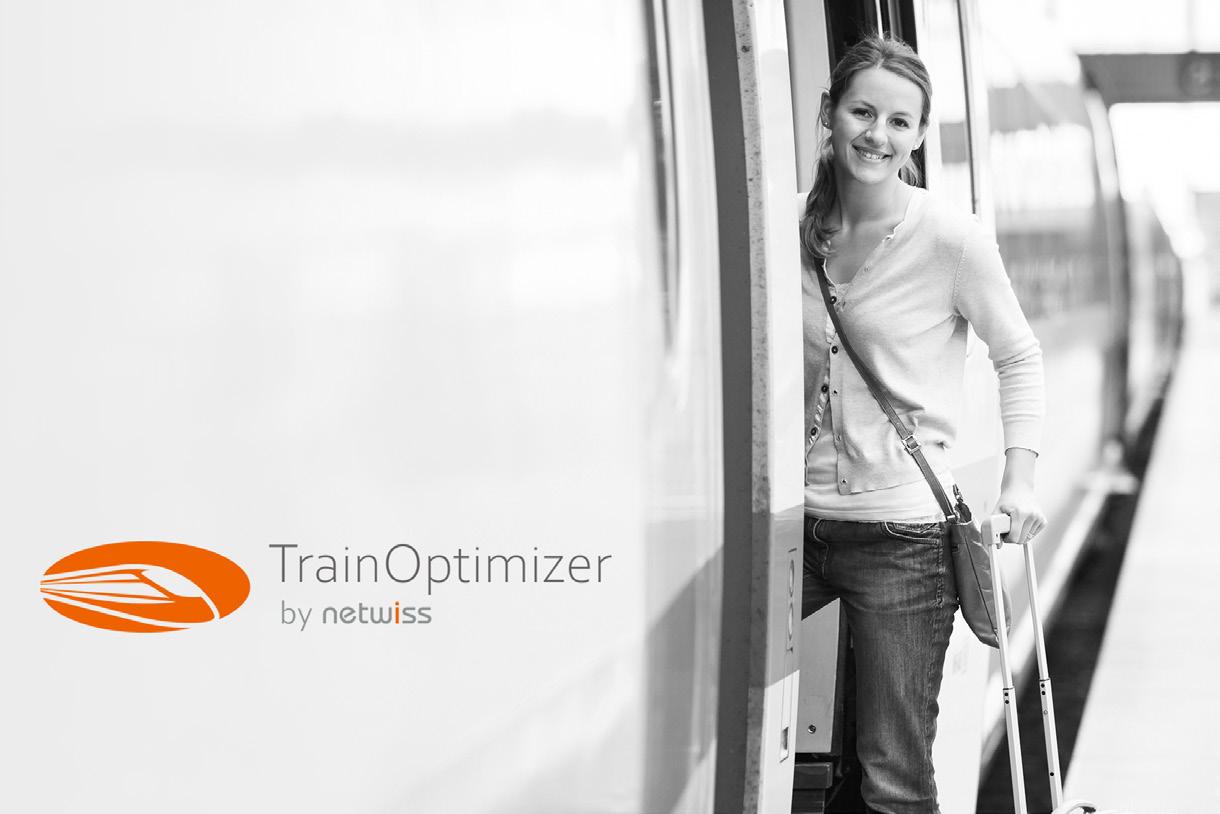
Directory Data & Monitoring
Planning & Management Software 56
Inter-City Trains
Night trains
High-Speed Trains
Local Trains
Light Trains
Metros Busses Optimize passenger vehicles and increase efficiency with just a few clicks!
You are a rail vehicle manufacturer design or engineering company railway operator purchaser of transport services educational institution other institution and you want efficient vehicles with short dwell time high occupancy rate best possible baggage stowing high passenger comfort
then TrainOptimizer® helps you to optimize your vehicles with just a few clicks!

Let us show you TrainOptimizer® without obligation!
With TrainOptimizer® you can very easily and quickly check any vehicle layout with regard to its efficiency and thus achieve significantly shorter dwell time and higher seat occupancy with increased passenger satisfaction at the same time through targeted optimization measures. info@TrainOptimizer.com www.TrainOptimizer.com
TrainOptimizer

VIAVI Solutions
Advancing Rail Telecom Networks: The Essential Role of Drive Testing
By Massimiliano Beccuti, Railway Product Line Manager, VIAVI Solutions
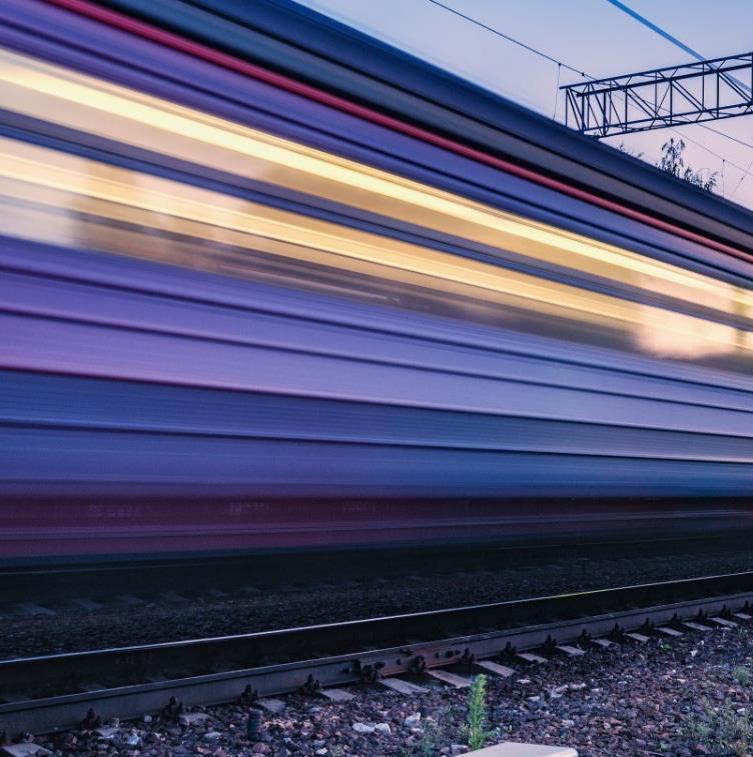
Industries are becoming increasingly digitised, and the railway sector is no different. Urban mobility is undergoing a huge transformation, and railways are at the very heart of freight and passenger transport on a local, national, and in some cases, international, level.
Traffic management tools, passenger information systems, signalling and real-time communication systems are just some of the areas in which digital innovation is proving useful to rail networks. According to one figure, the global digital railway market size is expected to reach $103 billion by 2028 – a CAGR of more than 9%.
If we think of digitisation as a set of new carriages, telecommunications networks are the tracks that support and guide them. Telecommunications serve as the backbone for operational efficiency, safety and the overall reliability of rail services. As this sector transitions from traditional systems, such as the 2G-based GSM-R, to more advanced networks like 4G and 5G, the need for rigorous network performance and reliability assessments becomes critical. Drive testing has emerged as a critical tool in this context, offering a precise method for evaluating new telecom infrastructure. Drive testing ensures that the rail telecom networks meet the high standards required for supporting current operations as well as future technological advancements. Stakeholders can verify network readiness, identify areas for improvement
and guarantee that communication systems uphold the safety and efficiency essential for modern rail operations.
Full Steam Ahead: Leaving GSM-R Behind
5G is already promising to reshape the future of railways by offering ultra-low latency and ultra-high reliability. While GSM-R, TETRA and LTE are still the standards adopted by traffic control centres in more than 30 countries around the world today, the future is rapidly approaching. Work has already begun on FRMCS, which will leverage 5G to facilitate advanced functions such as the Internet of Things, remote monitoring, high-speed rail, driverless trains and CBTC systems. These new technologies and use cases demand fast, robust and reliable connectivity networks that can collect, transmit and process enormous volumes of data in real time. According to one European-based study, more than 80% of railway executives are already piloting, planning or implementing FRMCS as part of their infrastructure.
Given the breadth of potential new use cases and technologies being deployed, ensuring that FRMCS and networks supporting them are fit for purpose and able to perform under high-pressure real-world scenarios becomes vital. That’s where drive testing comes in.
What Is Drive Testing?
Drive testing is a methodical approach employed
Directory
Data & Monitoring
58
to assess the performance and reliability of telecommunications networks, crucial for safety and efficiency. This process involves collecting data on network coverage, capacity, speed and overall quality from various points within the rail network. By simulating the user experience, drive testing provides invaluable insights into the operational integrity of telecom systems, enabling the identification and rectification of potential issues before they impact operations. Drive testing can be manual or automated, where manual testing allows for targeted, on-theground insights, and automated systems offer continuous, wide-scale coverage. Data collected ranges from signal strength and network latency to voice and data transmission quality, painting a detailed picture of network health and performance across the rail system.
Drive Testing: Challenges and Strategies
Conducting drive testing effectively within the rail environment presents unique challenges, primarily due to the dynamic nature of network conditions and the imperative to minimise disruption to ongoing rail
operations. The mobility of trains, varying terrain and the diverse infrastructure across urban and rural areas contribute to fluctuating network performances that require meticulous assessment. Further, ensuring that drive testing does not interfere with the daily train operations demands careful planning and execution. This balance is critical to maintaining service reliability while simultaneously conducting comprehensive tests to evaluate the telecom network's performance and resilience.
Consequently, formulating effective drive testing strategies from the outset is crucial. Choosing appropriate – representative – test routes is a good starting point. Equally important is determining the frequency of tests to capture a comprehensive data set that reflects both peak and off-peak conditions, further informed by any known issues or areas of concern within the network. Integrating testing activities with regular rail operations, possibly through the use of operational trains for testing purposes, can also help to mitigate disruptions and breaks in service. If possible, both portable and fixed testing solutions should be deployed to maximise coverage of extensive networks; portable devices facilitate focused assessments in areas


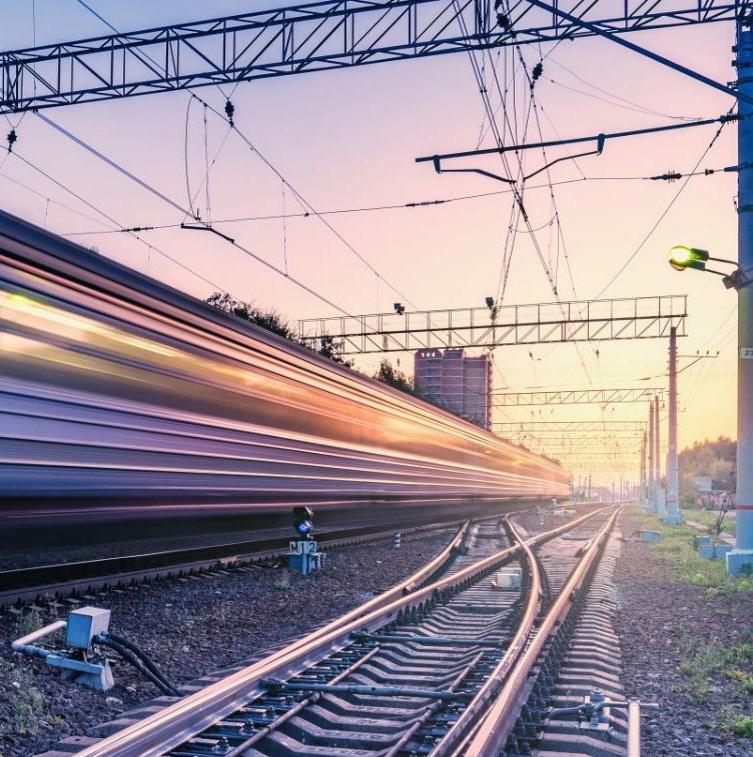
Communications Technology 59

that might be temporarily affected by environmental factors or undergoing infrastructural changes, while fixed installations offer ongoing monitoring capabilities, ensuring a consistent level of network quality is maintained across all operational areas.
As we move toward 5G-enabled FRMCS, the rich data harvested through drive testing provides a solid foundation for making informed decisions about
network improvements, strategic investments and compliance with regulatory standards. This data-driven approach will ensure that rail telecom networks are not only equipped to meet today's demands for high-speed and reliable communications but are also future-ready, capable of adapting to the fast-paced advancements in telecommunications technology and the ever-growing expectations of operators, businesses and passengers.
Massimiliano Beccuti
Railway Product Line Manager, VIAVI Solutions
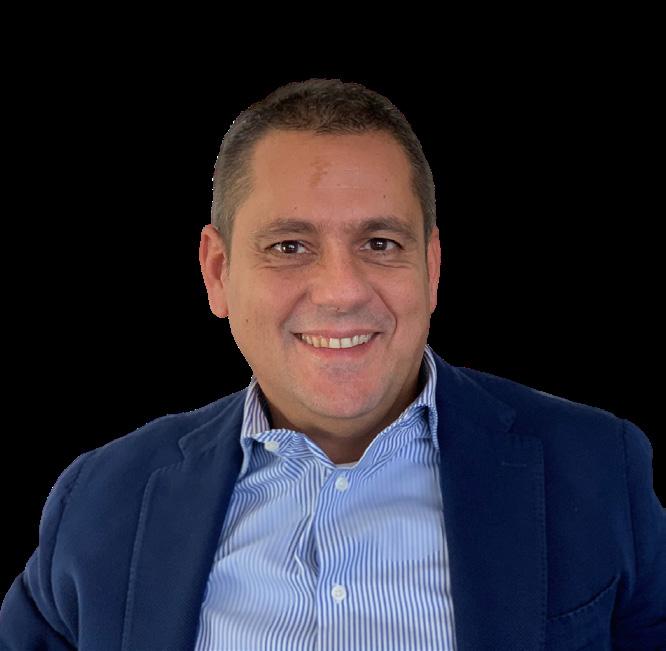
If you’d like to know more please visit viavisolutions.com/railway or contact us at sales.railway@viavisolutions.com

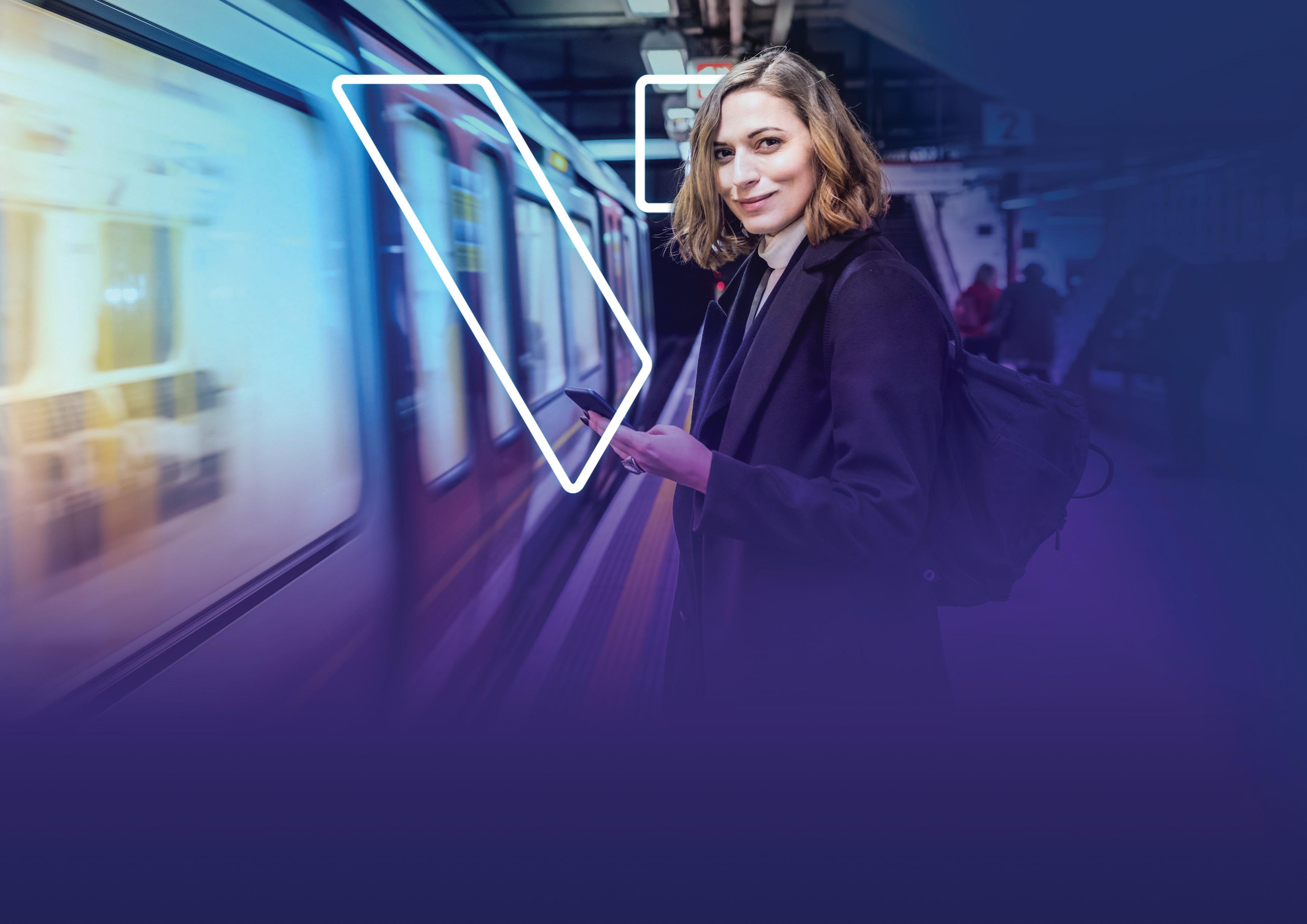
FRMCS ERTMS GPRS Drive Test Cybersecurity GSM-R ETCS Emergency Calls Mission Critical UNITED IN POSSIBILITY Together we provide efficent railway telecom and signalling service assurance Visit viavisolutions.com/railway or contact us at sales.railway@viavisolutions.com for more information

Calian’s broad range of Tallysman® GNSS antennas – designed for the next generation of GNSS rail systems.
✓ Multi-constellation, multi-frequency
✓ Precise positioning
✓ Interference mitigation
Precision at any speed
+1-343-804-5329 | info.gnss@calian.com calian.com/gnss/rail (formerly Tallysman Wireless)

Data & Monitoring
NEXCOM
Transforming Hong Kong’s Railway Safety with AI-Powered Transportation Management

Background
Hong Kong's railway system epitomises efficiency and connectivity in urban transit. It serves as the city's arterial network, efficiently carrying millions of commuters daily. Renowned for its punctuality and reliability, the railway system stands as a model for urban transportation globally.
Connecting diverse districts, blending residential, commercial and cultural landscapes, its importance as an infrastructural backbone is undeniable.
With this tremendous responsibility, ensuring the safety of railway infrastructures and operations is of utmost importance.
Challenge
All types of transportation infrastructure, including highways, railways and subways, have one thing in common: they face critical challenges in operationalising data across safety, maintenance efficiency and always-on security. Maximising safety while minimising maintenance costs is a massive challenge for any transit authority.
In particular, let’s delve into operational safety. Manual inspections can take up to 10 times longer than machine inspections; they are both labour intensive and compromise accuracy.
Inclement weather conditions, such as wind, rain and
Directory
62
darkness, can further complicate manual inspections. Extreme precipitation events have become more frequent in Hong Kong. The hourly rainfall record was broken several times in the last few decades. In consequence, the inspections often fail to monitor the safety of operating tracks. For instance, vegetation intrusion or railway track shift can lead to derailments. Hundreds of incidents occur annually due to undetected infrastructure defects, vegetation and landslides. Unplanned disruptions result in an average of 300 hours of operations lost per year across these sectors.
Traditional camera infrastructure and IP cameras often lack depth perception for accurate monitoring. Satellite imagery doesn’t have enough precision and is highly dependent on weather and satellite availability. Aerial monitoring is costly, with airspace regulation issues and the requirement for experienced pilots.
Solutions
Advanced computing and AI are the path forward, covering tasks from image processing and optimisation to machine and deep learning, as well as machine vision and object recognition for safety applications, including collision avoidance. NEXCOM, an NVIDIA NPN partner and Metropolis partner, in partnership with Kodifly (www.kodifly.com), an NVIDIA Inception partner, a Hong Kong-based spatial intelligence company, deployed the Intelligent Railway Infrastructure System (IRIS), assisting Hong Kong Railways in efficient and safe infrastructure management.
NEXCOM’s product, ATC 3750-A6CR, a robust edge AI railway computer featuring the NVIDIA® Jetson AGX Orin™ system-on-module, connects high-resolution cameras and LiDAR sensors by PoE LAN ports as the image and Point Cloud Data (PCD) inputs for machine vision.
Additionally, NEXCOM offers a comprehensive

software service called NEXCOM Accelerator Linux (NAL), integrating the NVIDIA JetPack™ 5.1.1 software development kit, Ubuntu 20.04, an onboard MCU library and custom-made peripheral I/O functionality drivers. It provides developers with efficient control of the hardware and NVIDIA® Jetson™ system-on-modules through APIs, sample code and I/O utility, facilitating a seamless solution to accelerate customers’ app developments. The stable software architecture of NAL made it easy for software vendors to extract train information and develop programmes, allowing their software to successfully interface with the ATC 3750 and meet the requirements of this project.
IRIS, the infrastructure monitoring system, is powered by SpatialSense, a LiDAR and camera scanner that can be mounted on any moving vehicle. The SpatialSense and processing device are installed on the train, surveying the railway infrastructure, capturing precise details and creating a digital twin. The software analyses the railway circuit and helps to identify potential concerns, such as intrusions, obstacles or the growth of trees that can cause disruption of service on the tracks. The exact location of potentially hazardous



Computers & Sensors 63
instances is pinpointed directly on the 3D map in an intuitive web application. Staff from the control centre can view the alert in real time and immediately rectify the risk, such as by removing trees or repairing rails. This solution can also be used by railway operators to schedule maintenance and troubleshoot problems, helping to prevent accidents.
Moreover, this mobile computer facilitates realtime information monitoring by integrating LiDARs, IP cameras or mmWave radar. It provides essential functionalities such as driving and braking control, collision protection, people counting, traffic light detection, railway ballast bed monitoring, railway station monitoring and anonymised monitoring of drivers’ physiological states. These features aim to enhance safety in rolling stock applications.
The railway SKUs for ATC 3750-A6CR, along with the optional power isolation kit VTK PWA series, provide complete power protection. They hold the EN 50155 certification and are equipped with an M12 X-coded connector to prevent wire detachment. In such a complex environment that’s exposed to natural elements, a ruggedised solution is required. Equipped with passive cooling and an optional fan kit for hybrid cooling, the ATC 3750-A6CR can effectively dissipate heat over a wide temperature range in harsh environments. These features enable high-speed data processing, efficient operations and excellent connectivity, facilitating real-time obstacle detection for collision avoidance. NEXCOM plays a crucial role in unfenced environments by detecting and eliminating blind spots, where unexpected obstacles like animals or plants may enter, minimising accidents, damage, deaths and delays while maintaining transportation volume and revenue.
Benefit & Result
Improved Inspection Efficiency
By employing the AI solution, the public transportation network can reduce the impact of uncontrollable factors such as weather and labour shortages, significantly lowering costs and improving inspection efficiency.
Improved Prediction Accuracy
Compared to traditional optical sensors, LiDAR can
accurately detect the distance, location and shape of objects, collecting data from a wider range by emitting lasers in all directions. In this case, it is crucial to effectively and accurately identify the location of trees and whether surrounding objects will obstruct the train’s path.
Reduced Maintenance Costs
According to the reports by the public transportation network and the Federal Railroad Administration, Hong Kong will spend $65 billion on railway asset maintenance and renewal in the next five years. By switching from breakdown maintenance to preventive maintenance, the AI monitoring solution enables substantial savings.
The smart transportation solution, built using NEXCOM’s ATC 3750-A6CR and Intelligent Railway Infrastructure System (IRIS), is a game-changing platform revolutionising the transportation industry. The platform provides efficient, cost-effective and safe solutions, and has been widely adopted across numerous vertical markets. It contributes to new standards for innovation and technological advancement in the transportation sector.
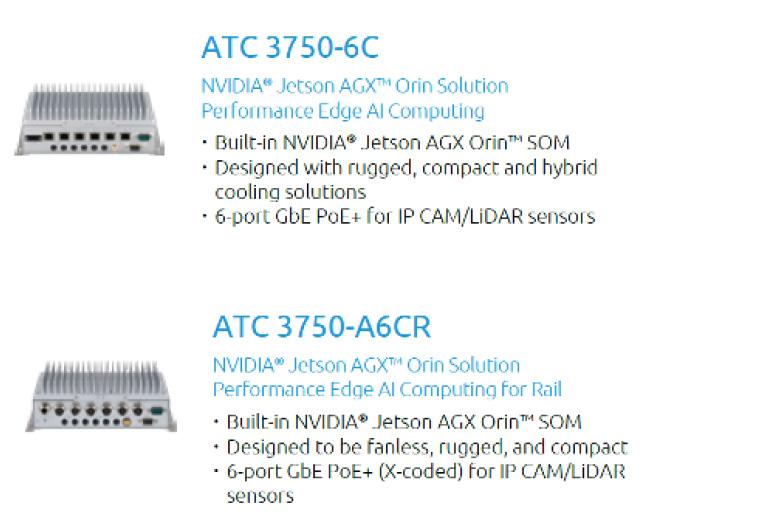
For more information visit NEXCOM or click here to find out more about Kodifly.



Arentis Limited
Arentis Offers Wireless Surveillance System
Wireless monitoring systems have been improving safety and cutting service disruptions for some time and although the technology is now established, it has matured considerably in recent years.
CCTV systems are delivering a much-enhanced product with each advance in digital technology. Specialist supplier Arentis Limited boasts 20 years’ experience in the rail sector.
Arentis provides CCTV solutions for use at crossings, onboard and for depot and station security, most notably manufacturing the Network Rail-approved XNET-TE system in use at UK level crossings.
The company’s latest product − VA-CONNECT − is a wireless camera transmission and recording system which allows clients to view live and recorded video footage from remote locations or from settings where wired infrastructure is cost prohibitive. It can be deployed on manually controlled barriers with obstacle detection (MCB-OD), automatic half barrier crossings (AHBCs) and barrow crossings, delivering live video images on demand or triggered by events on the track, and can also provide continuous recording.
VA-CONNECT allows up to 16 CCTV video images to be recorded locally and streamed wirelessly. It provides workers with access to images, allowing them to review maintenance faults, crossing misuse and detect trespass via inbuilt analytics.

Directory
Monitoring
Data &
Computers & Sensors 65
The system comprises a remotely located video recording and streaming unit for connection to local cameras and wireless communications. A cloud/ WAN-based management server provides the hub for administrator management of field units and users. Users access the system through client applications (including Windows and iOS) to view, control, review and download recorded footage. This can be done from the user’s mobile, once they have the correct software installed.
Attractive Features
A key feature of the system is that users can choose their own peripherals. Camera choice is at the discretion of the customer. Additionally, the choice of data SIM card(s) is again up to the customer, although Arentis can supply a managed data SIM if required. WiFi is included for local access using a PC for recording download and general administration tasks negating the need to physically access the field unit.
Ease of use is another factor that draws customers. Users can quickly deploy and redeploy CCTV cameras
“We have deployed one site with a people counting camera so we can see the number of users per day,which has been of great benefit in risk analysis.As there are an ocean of cameras with a variety of‘edge’functions,this versatility along with the support of the supplier allows maximum leverage of value from expenditure.”
representative from Network Rail’s
at locations where infrastructure is limited and the system requires very little setup, saving time and disruption to customer sites.
The system does not rely on network cabling and requires only a power source to operate. This can be a fixed power point, though the system’s solar and battery options improve its flexibility. This aids with installation and makes the system resilient to cable theft, a problem which costs the rail industry millions of pounds each year and which VA-CONNECT can help protect against.

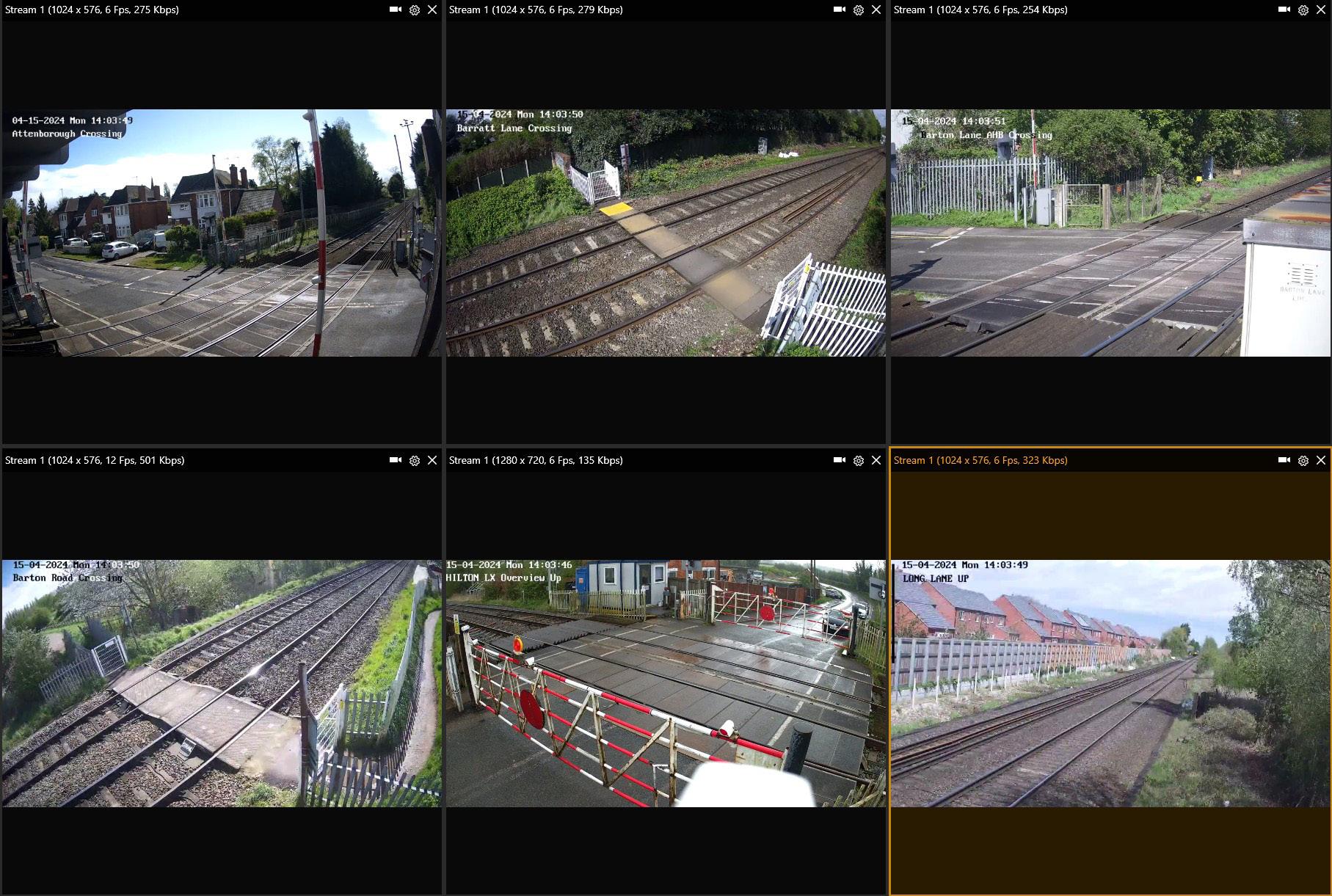

66
A
Combined Engineering Depot (CED) in Brighton [Sussex Route]
Proven Capabilities
VA-CONNECT has already been deployed at over 50 locations on the UK’s rail network and the system has assisted in the unfortunate case of accidents and has helped secure successful prosecutions of misuse at crossings. It has helped British Transport Police secure convictions against drivers for various offences, from red light offences to unsafe loads damaging the crossing itself.
The system’s rapid deployment has helped in instances where fixed monitoring systems have been knocked out of service due to occurrences on the track. “In 2019 we had a fatal accident at one of our crossings,” said a representative from Network Rail’s Combined Engineering Depot (CED) in Brighton [Sussex Route].
“The investigation took months as the data logger was destroyed in the accident.We needed to find a CCTV system that was affordable and quick to deploy to help with any future incidents.
“Since then, we have installed around 20 VA-Connects to date with another seven sites planned this year. The system has also helped with failure investigation of auto half barriers,they have reduced our fault time drastically and helped with diagnoses of wrong side failures reducing the amount of testing and time required to bring them back into full operation.”
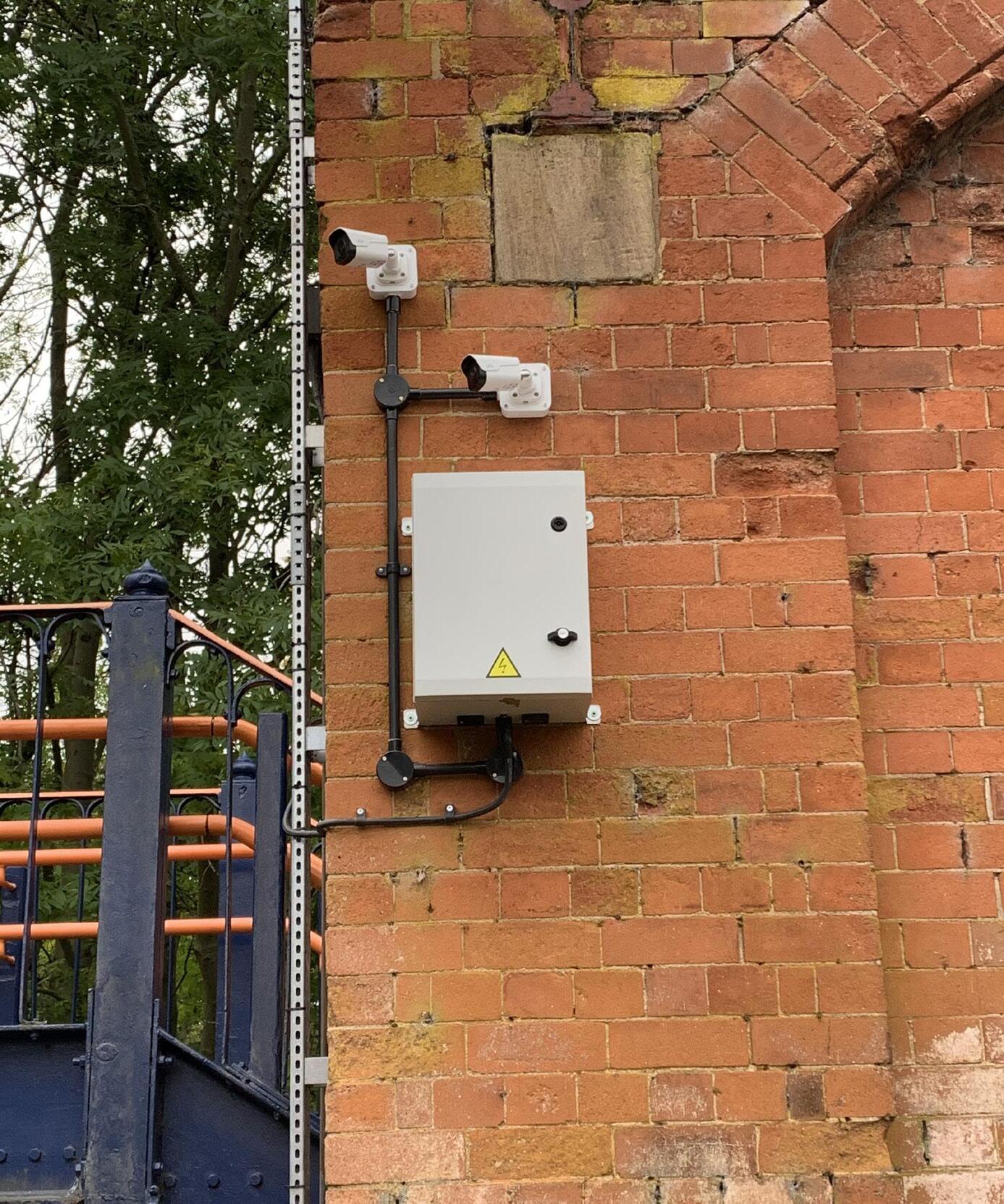
challenging environments. With trespass on the tracks becoming a growing problem (incidents of trespass increased by 40% as lockdown restrictions were lifted), tools that can act as a deterrent and gather evidence for prosecution of offenders are very attractive. After all, the rail industry is keen to take advantage of technologies to increase safety and avoid the fines that result from delays caused by accidents and trackside crime.
The system has many more uses than surveillance at level crossings and can be employed at remote stations, depots and work sites where assets, workers or passengers may be at risk. All these uses, and more, make the system excellent value for money, according to Network Rail’s representative.
“We have deployed one site with a people counting camera so we can see the number of users per day, which has been of great benefit in risk analysis.As there are an ocean of cameras with a variety of‘edge’ functions,this versatility along with the support of the supplier allows maximum leverage of value from expenditure.”
Confidence Assured
Arentis’ system has been developed solely for use in the rail sector, recently being certified for use within the network by ascertaining EMC certification, so users can be confident when deploying the system in
To find out more information contact Arentis Limited
2 Wortley Road Deepcar Sheffield S36 2UZ
0114 218 04 70
sales@arentis.co.uk
arentis.co.uk

67

ExPretio
Enabling a More Competitive and Sustainable Passenger Rail Industry through AI-Driven Solutions
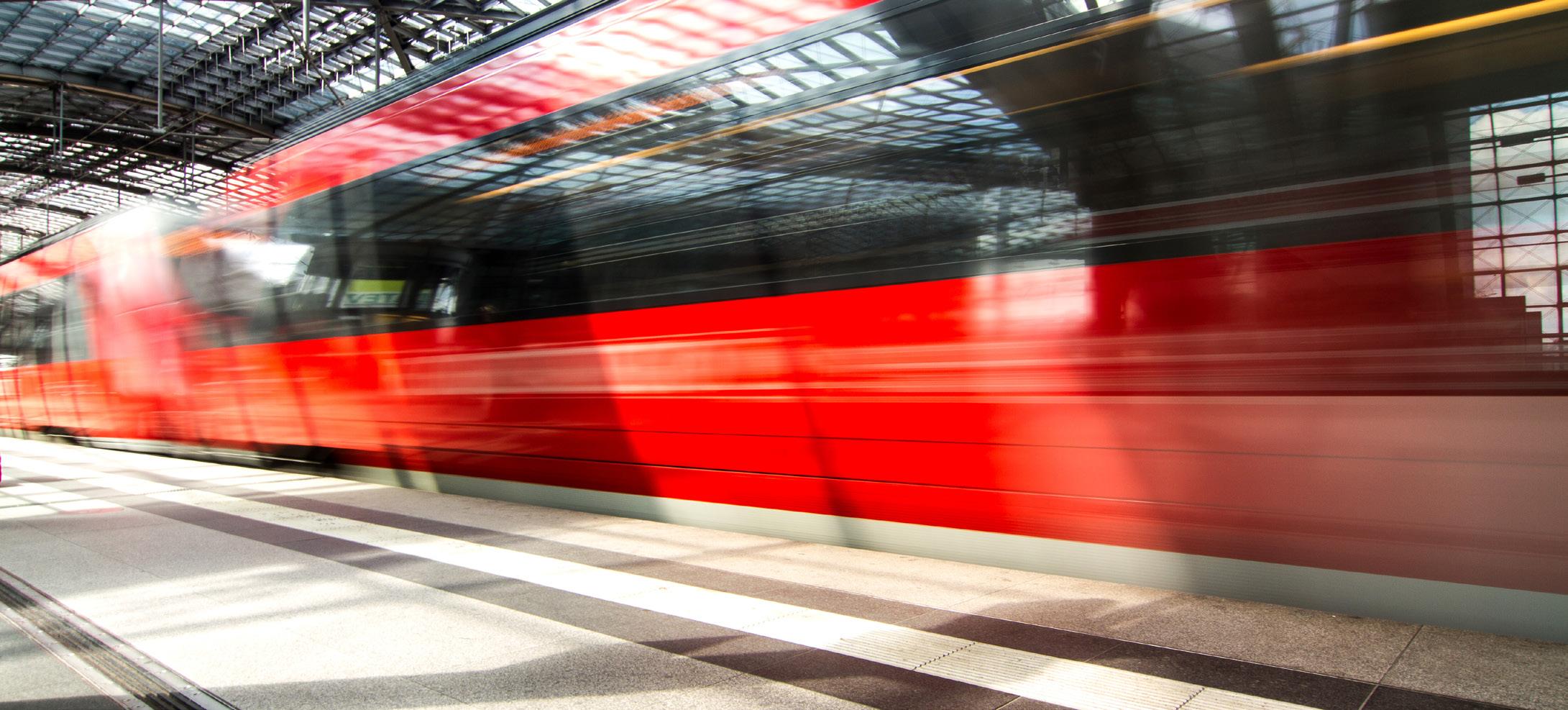
Montreal-based
ExPretio is leading the way in helping passenger rail operators increase revenues, offer more adapted products, be better positioned against competitors and have more accurate passenger forecasts.
Passenger rail operators face a myriad of challenges when it comes to optimising their capacity management and maximising revenues. Operational costs and unpredictable demand are hurdles that need to be overcome, as is increased competition for contracts. These pre-existing challenges are now exacerbated in a post-COVID era.
Furthermore, especially in Europe, the landscape is becoming increasingly competitive with new entrants to the market. In this evolving world, it is key for
operators to put forward a diversified offer that caters to each passenger segment, ensuring they offer competitive products in terms of price and quality. Offering the right product to the right customer, at the right price, at the right time is the core of the revenue management practice. But, in the passenger rail industry, it is much more.
Improving Revenues and Competitiveness While Offering Attractive Products
AI-based software solutions in the realm of revenue management can help operators improve their competitiveness in a constantly evolving market by giving them a better understanding of passenger demand and adjusting their sellable products accordingly.
Directory Data & Monitoring
68
ExPretio Technologies Inc.

Appia's forecast and automated optimisation capabilities,combined with customisable dashboards and flexible rules allows revenue management at various levels of detail
This is made possible through detailed analysis of bookings, forecast of demand and optimisation of product availability at the origin-destination (OD) level. By turning data into actionable insights, rail operators can anticipate and proactively adjust to demand patterns opening or closing specific ticket types for different trains, classes, routes, ODs and sales horizons. In the passenger rail industry, the combination of possible products is significantly higher than any others (such as the airlines or hospitality) and requires specific solutions and optimisation capabilities.
Getting the Most out of Each Journey Requires Proper Tools and Skills
Leading the way in this area is ExPretio, which offers revenue management, competition positioning and demand forecasting software solutions to the passenger rail industry. Appia, ExPretio’s flagship solution, leverages more than two decades of R&D in transportation and data analysis and has been recently revamped to use the latest and proven software-as-aservice (SaaS) technologies. Dozens of rail operators
worldwide leverage ExPretio’s solutions and expertise, from international, national and regional railways to more specific operations such as night trains and shuttle services.
Thanks to recent advances in AI and their inclusion in ExPretio’s solutions, much of the sales product optimisation process can now be automated – even in the case of incomplete datasets – and analysts can use ExPretio’s software to make better tactical and strategic decisions, all while increasing revenue and improving overall productivity.
ExPretio’s solutions are the result of years of R&D in Montreal, a world-renowned centre of excellence in public transportation, AI and big data research. “You hear a lot about AI today,but that’s just the tip of the iceberg,” says Alexandre Savard, ExPretio’s Director of Business Development, Sales and Marketing. “Below the surface there’s so much more going on.This is an area that has over two decades of advanced research behind it and we’ve been working closely with customers and partners to industrialise R&D to the benefits of rail operators and the communities they serve.”
Revenue Management & Ticketing 69
The Balancing Act between Revenue Goals, Commercial Strategies and Business Constraints
Whether public or private organisations, passenger rail operators often must juggle conflicting objectives that extend beyond maximising profitability. These include, but are not limited to, minimising geographical discrimination, increasing and shifting ridership, addressing the needs of a wide range of customers, retaining or increasing market share, attracting passengers from air or car travel and optimising capacity allocation.
Balancing these can often be looked at as a multifaceted optimisation problem, which can be addressed with ExPretio’s software solutions.
“Our mission is to enable sustainable mobility through the supply and demand of intelligent solutions,” says Carlos Triana, General Manager at ExPretio.“We believe that what is called revenue management should be seen as much as a tool to achieve financial sustainability as to make passenger rail more attractive towards a greener future.”
Reinventing Passenger Rail Revenue Management for Today and Tomorrow
For over 20 years, ExPretio has reinvented revenue management for the rail industry by applying best
practices into a tailored-made solution for passenger rail. Similar solutions exist in other industries but often do not consider the specific complexities of rail. That is why some of the largest and most complex passenger rail operators in the world choose ExPretio to support their revenue management and competitive positioning activities.
“Implementing a revenue management solution is an overall commitment to introduce and exploit a sensible product structure,to formalise the decision-making processes,to better inform analysts,and to reduce commercial strategies’time-to-market,” says Savard. “We work with our clients to grow their capabilities, optimise their fare range,train their staff and tune our models to cope with their unique goals.It’s a process that evolves continuously and brings measurable results at every step.Furthermore,now that ExPretio is part of Modaxo,the synergies between businesses dedicated to public transport under one global roof magnify the benefits for the whole industry.”
ExPretio will be exhibiting at World Passenger Festival in Vienna on 25–26 June. Come meet its team at stand number 54 to discover more about the company and its solutions, or you can visit www.expretio.com for further information.

 Montreal, worldwide AI hub
Montreal, worldwide AI hub
70
Proven Tier 1 monitoring technology supporting rail operators since 2018
MILLIONS
SAVED IN CP7 WITH NEW APPROACH TO LIFE EXTENSION OF SIGNALLING POWER ASSETS
CableGuardian is a Network Rail approved Tier 3, Tier 2 and Tier 1 cable monitoring system as specified in NR/L2/SIGELP/27725
– Insulation Monitoring and Fault Location Systems for use on Signalling Power Systems.
Our unique technology provides unparalleled insights across the lifecycle of a system, moving to a true condition-based asset management approach that allows cable faults to be quickly and accurately located.
CableGuardian also complies with the updated Standard NR/L2/ SIGELP/50000, now permitting remote continuous monitoring of Signalling Power Distribution equipment. Network Rail Approved: PA05/06538
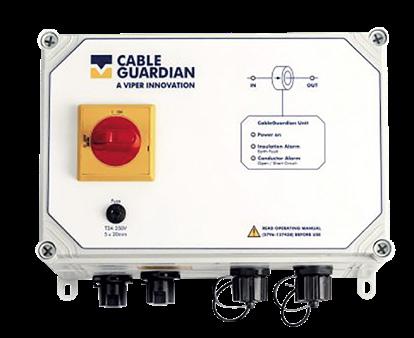

in penalty payments
30K AVOIDED in delay minutes
£150K SAVED in maintenance costs
1M+ METRES of network monitored
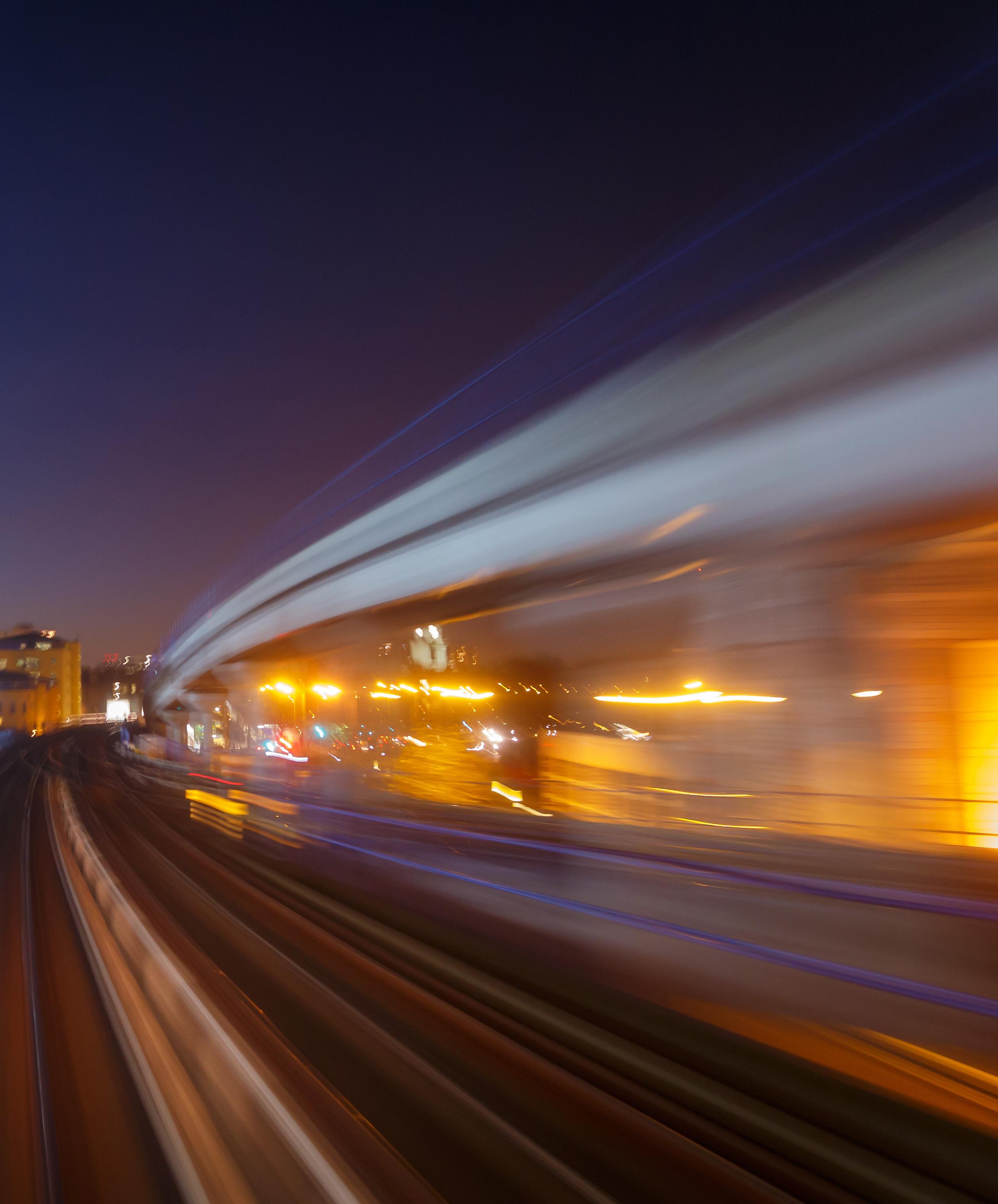
Helping passengers arrive on time
Find out more…
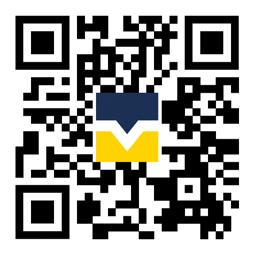
www.viperinnovations.com/cableguardian
TO BE

Viper Innovations
A New Asset Management Milestone as Viper Innovations
CableGuardian Hits the Million Metres Mark

Muchsafer trackside working, huge reductions in delay minutes, massive efficiency savings and a great leap forward in sustainability – CableGuardian, by Viper Innovations, has proven to be a safe bet for investing CP7 (Control Period 7) funding.
Signalling power supplies, often overlooked until they malfunction, carry profound safety risks and can severely impact railway performance. However, with advancements in technology, the landscape is evolving.
In partnership with Network Rail, Viper Innovations has diligently refined monitoring technology for lineside signalling power, yielding impressive results.
Continuous monitoring of over a million metres of cable has eliminated thousands of man-hours of on-ornear-the-line work, mitigated operational disruptions and prevented penalty payments exceeding £5 million Furthermore, hundreds of thousands of delay minutes have been eradicated from the network, and a revised maintenance regimen promises millions of pounds in expenditure reduction per control period. However, the best is yet to come.
Up to press, CableGuardian has excelled in identifying the disconnection of earth rods at location cases and thus prevented electric shock. The technology pinpoints latent defects in cable joints, stopping a large-scale power outage on the main line while detecting high-resistance contacts in fuse holders and allowing detection of loose cables and general
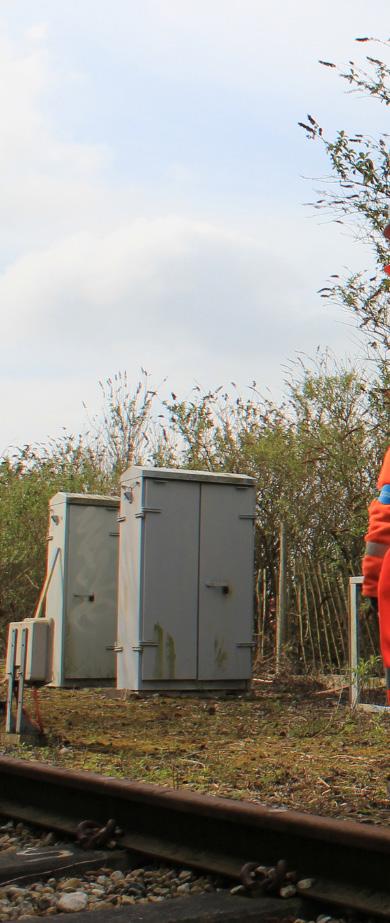
Directory
Monitoring
Data &
72
wear and tear in switchgear. Other benefits of CableGuardian include detecting hidden overloads on circuits, stopping repeat fuse failures on a mainline signalling circuit, and identifying and enabling intervention due to the general degradation of cables, therefore preventing a number of significant failures. CableGuardian has also enabled fault teams to pinpoint failures on circuits that have remained undetectable for prolonged periods, reducing risk to maintenance staff, and eliminating large amounts of OPEX. The system has even negated the need for a large equipment renewal by quickly identifying circuit failures. These day-to-day interventions have provided excellent improvements in safety, performance, efficiency and sustainability, and clients are now looking at a much bigger prize.
Recently introduced changes to standard NR/L2/ SIGELP/50000 Safe Working and Maintenance on or near Signalling Power Distribution Equipment above 175V AC, facilitated by the collaboration between Network Rail and Viper Innovations, have ushered in a next-generation insulation monitoring system and service, enabling a new paradigm of total asset management. Through CableGuardian’s technological innovation and collaborative service offering, the removal of the need to manually strip down and test systems once every five years, based on national standards for electrical safety, is opening the door to a new, safe, efficient and sustainable asset management regime fit for 21st-century railway operations.
The previous periods lacked modern, effective and remote continuous monitoring with comprehensive parameters. This required a complete strip down and test of the lineside asset, making maintenance engineers and asset managers act on evidence found during the test. These actions could be confounded because the test might only represent a snapshot in time affected by weather and other climatic conditions and not present a complete or accurate reflection of the asset condition. These working practices, driven by necessity due to a lack of credible technology, have held the industry back and enforced a regime of mass equipment renewals that undoubtedly have removed perfectly serviceable equipment, en-masse, costing millions of pounds over the years.
The introduction and moulding of CableGuardian technology and service over the last few years has provided insight into a critical asset previously hidden. This new ability will move to a position where spot
replacement of assets can be enabled, the maximum number of failure modes can be predicted and prevented and manual maintenance can be taken to the lowest possible level. Continuous improvement is now a reality, and with it will come even greater insight into asset lifecycles, enabling safe, effective and highperforming life extension works for as long as the client decides.
With over a million metres and a growing number of monitored cables, switchgear and transformers lineside, CP7 (Control Period 7) will be different. Safety, performance, efficiency and sustainability will move to the next level, with Network Rail driving even more benefits from CableGuardian and Viper Innovations.
Click here to learn more about Viper Innovations or download Viper Innovations CP7 Bid Support document
* The monetary value is determined through an analysis conducted with clients,assuming a delay of approximately 5 to 10,000 minutes per mainline failure,based on Schedule 8 penalty payments associated with mainline operation and an approximate operational expenditure (OPEX) of £10k per incident,based on detailed failure analysis.Each failure is estimated to cost between £500k and £1m conservatively.


& Train Control 73
Signalling

Data & Monitoring
Yeltech
We Manufacture Remote Condition Monitoring Units, Designed to Make Your Life Easier
Who Are We?
Yeltech Ltd stands as a beacon of innovation and progress since its inception in 2004.
Our journey has been one of constant evolution, driving forward the frontier of smart remote condition monitoring technology. With each step, we have contributed to the enhancement of industries through groundbreaking solutions.
As a trusted entity in the field, we specialise in providing bespoke engineering solutions that are not only practical but also effortless to install and cost-effective.
Our commitment to tailoring solutions to match the distinct requirements of our diverse clientele has solidified our position across various sectors.
From rail to buildings and structures, from water to environmental monitoring, our footprint spans wide, addressing the unique challenges each industry presents.
So, What Exactly Do We Bring to the Table?
• CCTV Monitoring: ensuring round-the-clock surveillance and security
• Culvert and Drainage Monitoring: offering insights into the integrity and efficiency of drainage systems
• Rail Temperature Monitoring Units: safeguarding railway infrastructure by keeping track of temperature variations
Eduardo Mendoza CEO at Yeltech

• Emergency Warning Boards: providing timely alerts and communication during critical situations
• Tilt and Noise Monitoring Solutions: monitoring structural stability and environmental noise levels
• Vibration Monitoring Solutions: detecting and mitigating potentially damaging vibrations
• Remote Track Void Monitor: identifying and addressing track voids to maintain safety standards
• Weather Stations: keeping tabs on meteorological conditions for informed decision-making
These solutions represent our dedication to innovation and problem-solving, ensuring that our clients receive nothing short of excellence in their quest for efficient, reliable monitoring systems.
At Yeltech, our commitment to quality and reliability is not just a promise – it is certified. We proudly hold the esteemed ISO 9001 Certification, a testament to our

Directory
74

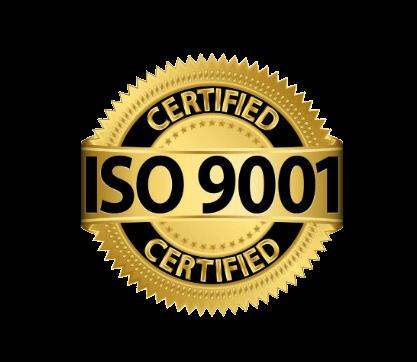
dedication to maintaining the highest standards across our entire product range.
But our pursuit of excellence does not stop there!
With an exceptional team, we specialise in the design and manufacture of intelligent remote condition monitoring solutions. By empowering maintenance engineers and asset owners, our solutions not only reduce costs but also safeguard lives.
What sets Yeltech apart is our relentless focus on innovation and adaptation. We understand that every customer is unique, with distinct needs and challenges.
That is why our entire team is dedicated to refining and customising our suite of services to deliver tailored remote monitoring products that not only meet but exceed expectations.
Driven by a commitment to continuous improvement, our engineering team is at the forefront of embracing technological advancements.
From harnessing the latest developments in wireless communication to leveraging the power of artificial intelligence, we ensure that our clients have access to the smartest solutions available.
At Yeltech, we don't just provide products – we provide peace of mind.
Our mission is not just a statement – it is a commitment to excellence. Rooted in our core values, we strive to be a trusted provider, offering costeffective remote sensing solutions that redefine industry standards.
• Quality and reliability are not just buzzwords for us; they are the foundation of everything we do. With high quality control measures in place, we ensure that each one of our products meets the highest standards, delivering unparalleled performance and peace of mind to our clients.
• But we do not stop there. We are dedicated to enhancing safety through real-time remote access monitoring. Our cutting-edge systems are designed to provide instant insights, empowering our clients to proactively mitigate risks and safeguard their assets.
• When it comes to critical avoidance systems, you can trust Yeltech to deliver solutions that are not only safe but also dependable. Our advanced technology and meticulous engineering ensure that our products perform flawlessly, even in the most demanding environments.
• We believe in the power of anticipation. That is why our condition analysis and monitoring solutions are designed to identify potential failure scenarios before they occur, enabling our clients to take preemptive action and avoid costly downtime.
Our expert team is standing by, ready to answer any questions you may have and help you find the perfect solution for your remote sensing needs.
Join us on the journey towards smarter, safer and more efficient operations.
For more information visit www.yeltech.com or email info@yeltech.co.uk
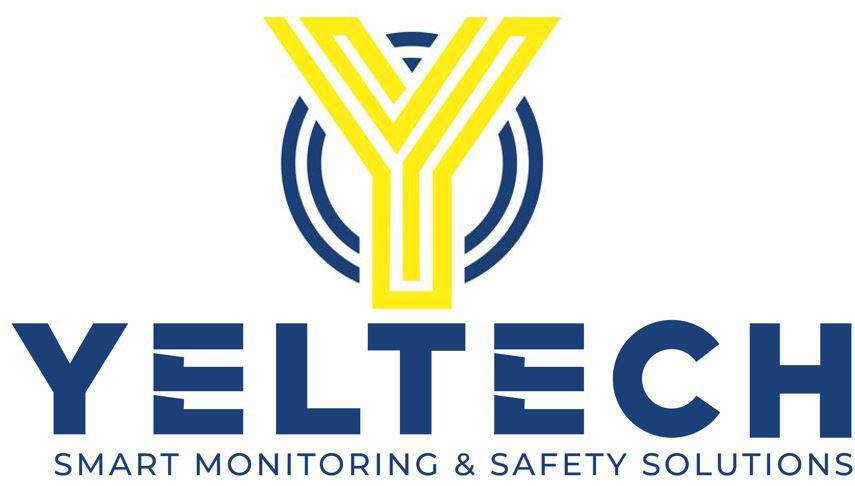
Condition Monitoring 75
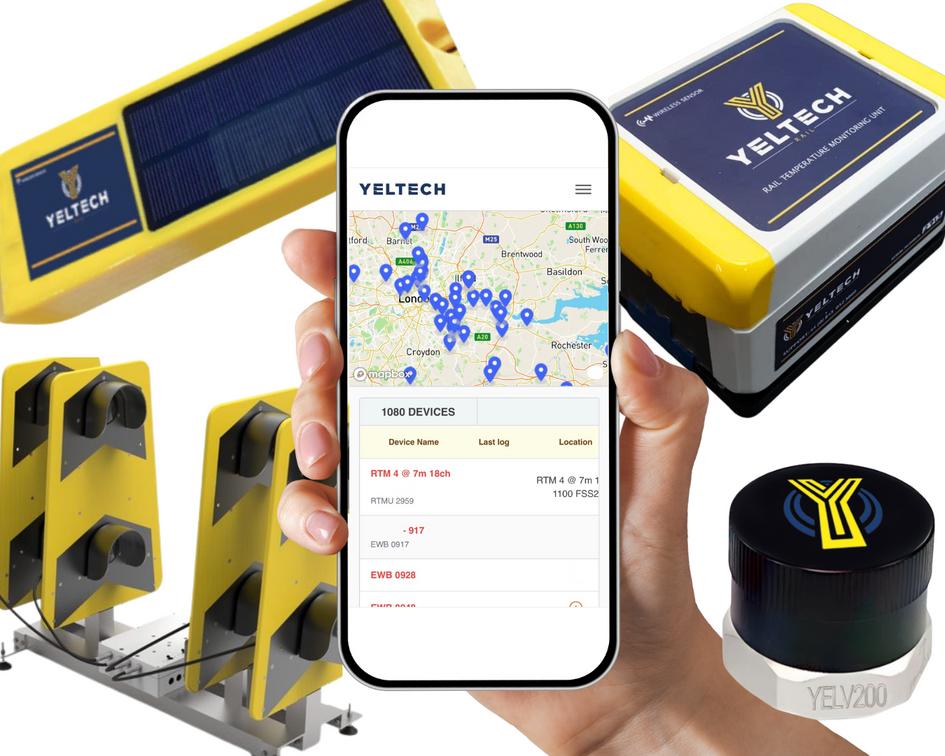

ENVIRONMENTAL MONITORING RAILWAY PRODUCTS
TELEMETRY PRODUCTS STRUCTURAL MONITORING
WEATHER MANAGEMENT
info@yeltech.co.uk yeltech.com 44 (0) 845 052 3860
WATER RESOURCE MANAGEMENT

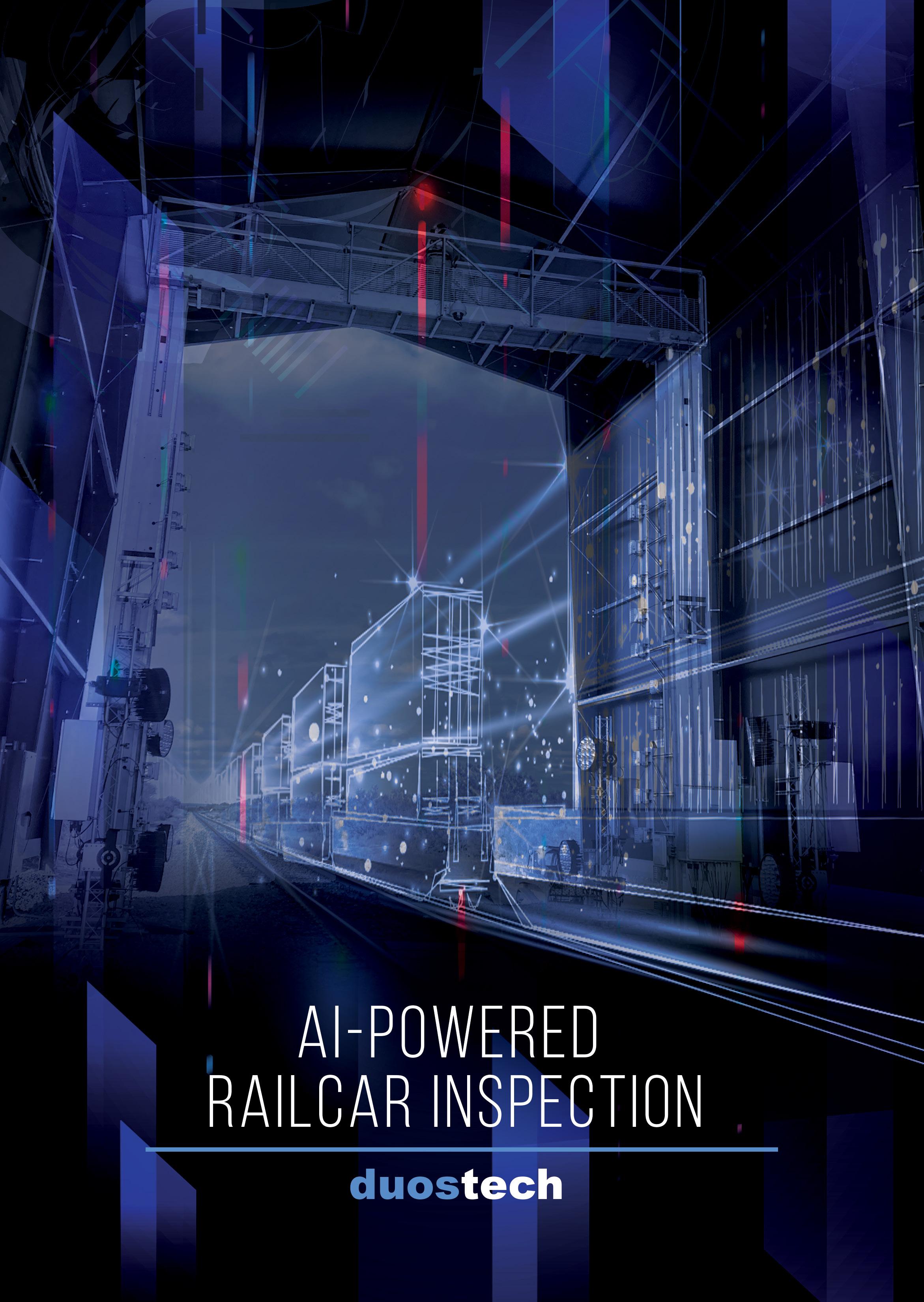
sales@duostech.com 7660 Centurion Parkway, Suite 100 Jacksonville, FL 32256 +1 904.296.2807

Data & Monitoring

Safety Is the #1 Concern of the Railroad Industry!
Railcars contain hundreds of parts and critical components that must be inspected frequently to ensure safe and reliable operations.
With more than 1.6 million railcars running on nearly 200,000 miles of track in North America, railroads and railcar owners are seeking advanced technologies to keep their operations safe, reliable and efficient. Improving processes in this area is key to improving safety and operations.
Duos Railcar Inspection Portal (RIP®) offers comprehensive remote visual inspection of railcars aided by the power of advanced artificial intelligence and machine learning (AI/ML) algorithms.
Railcar Inspection Portal (RIP®)
Remote Visual Railcar Inspections Made Easy
Capturing finely detailed high-resolution images at track speed, the RIP® provides a 360-degree (all-around) view of a passing railcar in mere seconds. The images are presented in CENTRACO® – a modern, intuitive
*Request a Duos AI Detection catalogue here
browser-based application thoughtfully designed to facilitate thorough and accurate railcar inspections within a flexible and streamlined workflow.
Expertly-Developed AI/ML Offers a Second Set of Eyes
Who couldn’t use a little help now and then?
The RIP® features a set of over forty (and growing) expertly crafted artificial intelligence/machine learning (AI/ML) models that offer just that. As the RIP captures high-resolution images, our AI models immediately analyse the images and look for anomalies or defects on the railcars. Detected defects are immediately reported in the CENTRACO® application, giving the inspector advanced notification of such conditions.
Railcar Inspectors – The Voice of Authority

No one knows more about inspecting railcars than experienced railcar inspectors. That’s why Duos employs skilled and certified railcar mechanics on our staff to oversee the planning, development and continual training of our AI models. In addition, each
Directory
78
of our AI models is developed and trained to detect conditions that matter most to railcar inspectors and railroad industry in general.
Actionable Intelligence in Record Time
We believe that intelligence is only actionable when delivered in a timely manner. That’s why our AI/ML models operate at lightning speed at the edge (track side), not in some far-off cloud. As a result, notifications of detections and anomalies found on railcars are made available within an average of 60 seconds after the railcar is scanned. This timing is especially important for defects that could result in extended dwell time or even mechanical derailments.
Sharing is Caring
It has been written that no man is an island. We believe the same is true for mission-critical systems designed to detect safety-related issues and conditions. That’s why the RIP® has been designed to make detection data and related data available in close-to-real-time via a wide variety of transport options and protocols, including text messages (SMS), email, and even APIs (application programming interfaces).
Features / Benefits
• *Modular, customisable turnkey system
• Enhances safety for employees, shippers & general public
• Mitigates risk through derailment prevention
• Improves network fluidity by reducing line of road delay & yard dwell
• Improves fleet utilisation
• Railroad benchmark study showed 8x more effective than human inspection alone
*All modules use high-resolution technology combined with artificial intelligence to create unparalleled imagery and detection.
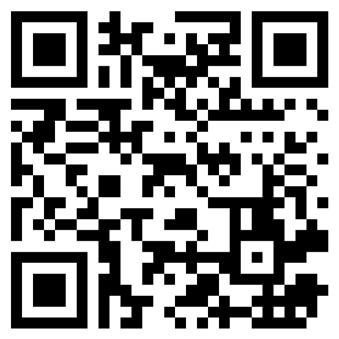

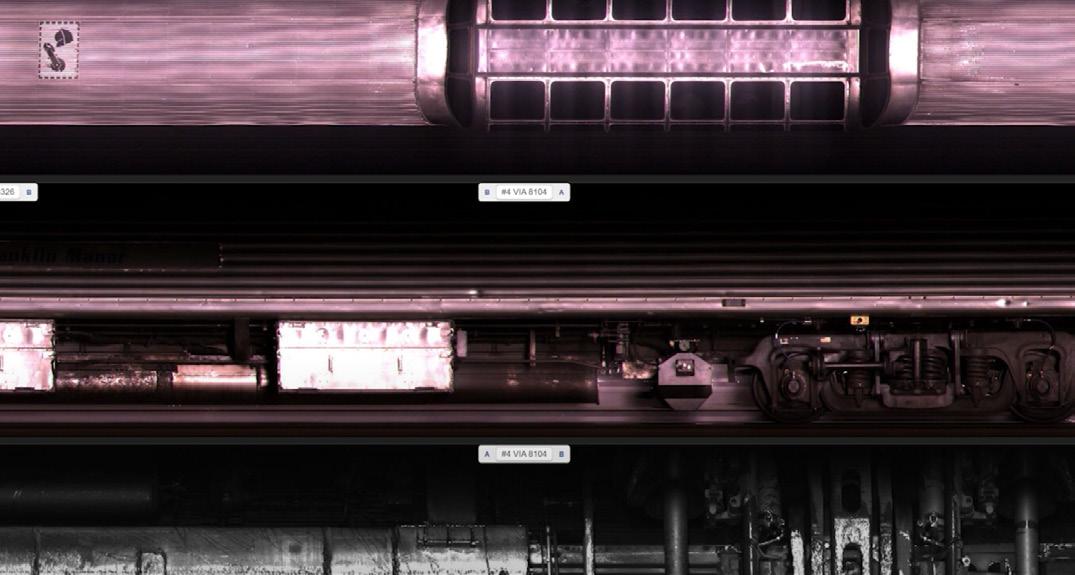


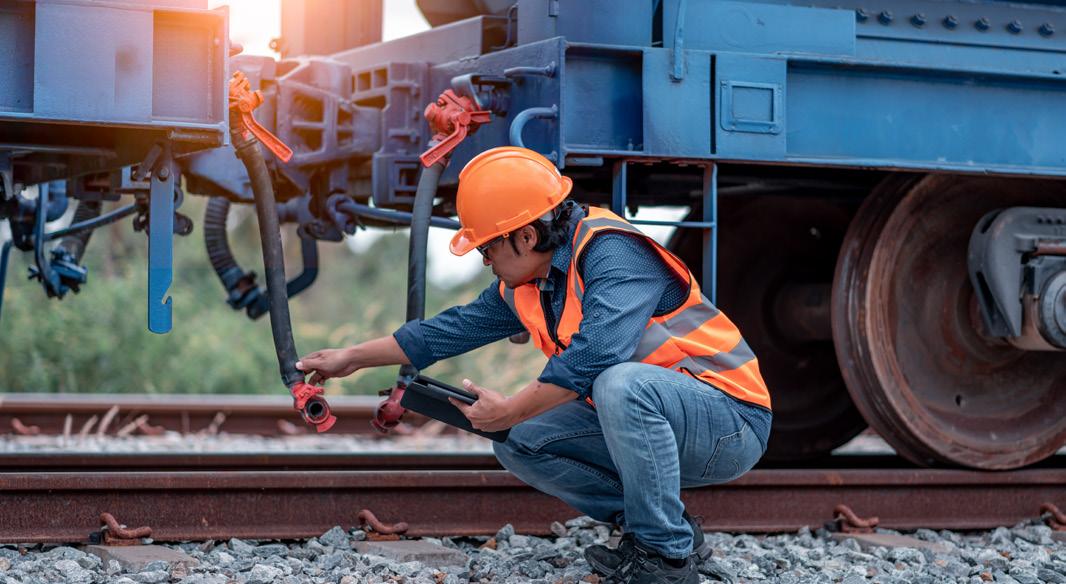
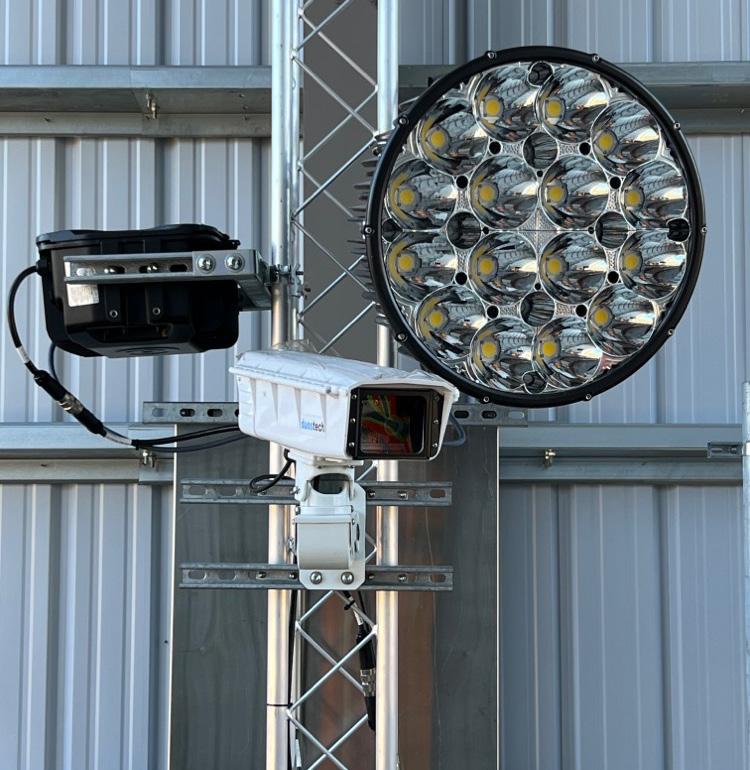
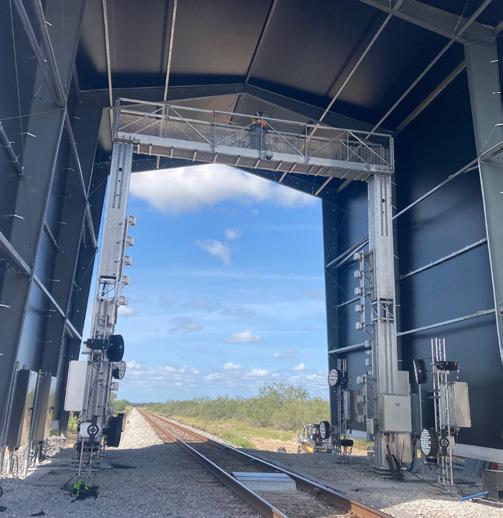


Click or scan the QR code of more information sales@duostech.com +1 904 296 2807 Condition Monitoring 79


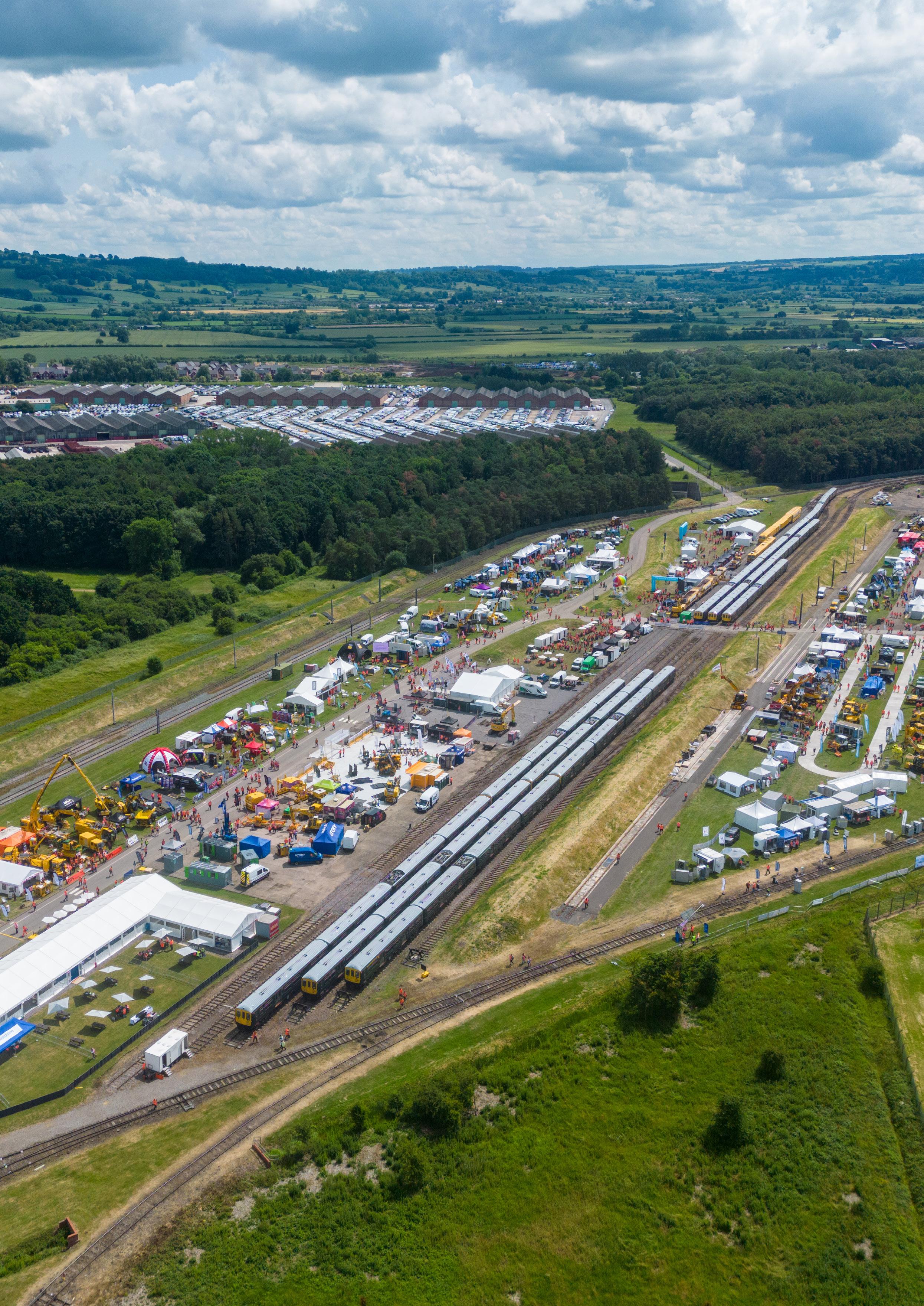
Events
Rail Live 2024 p.82
What’s in store at this year’s Rail Live, the outdoor rail event that boasts live plant demonstrations so that attendees can see the latest innovations in action. Find out about what speakers will be attending and what’s new for 2024!
Supplier Spotlight p.84
Our top picks for suppliers attending Rail Live and what solutions they offer to the rail industry.
Upcoming Events
p.85
A look at what key railway events are taking place between May and September 2024.
Rail Safety Week 2024 – Let’s
Build Safety Together
p.86
Elaine Clark, Chief Executive Officer at Rail Forum, highlights the need to have a continued focus on safety in the rail industry, both internally and towards the public. The event will run 24–30 June 2024, with the Rail Safety Week Conference taking place in Manchester on 24 June.
Directory
81

Where: Long Marston Rail Innovation Centre, Warwickshire, UK
When: 19–20 June 2024
Organiser: Bauer Consumer Media Ltd
Rail Live is the UK’s only immersive rail exhibition. It takes place in a real rail environment and hosts a range of live plant demonstrations. In 2024, the outdoor event will be attended by over 6,000 rail professionals.
The event provides attendees with the opportunity to see demonstrations, rolling stock displays and the latest innovations from over 270 suppliers. Meanwhile, industry experts and decision-makers will discuss the latest updates and developments to pave the way for 2025 and beyond.
The Exhibition
By displaying the latest solutions in a real railway environment, Rail Live aims to enable attendees to make informed decisions while directly comparing products.
What’s more, through its presentation of innovations
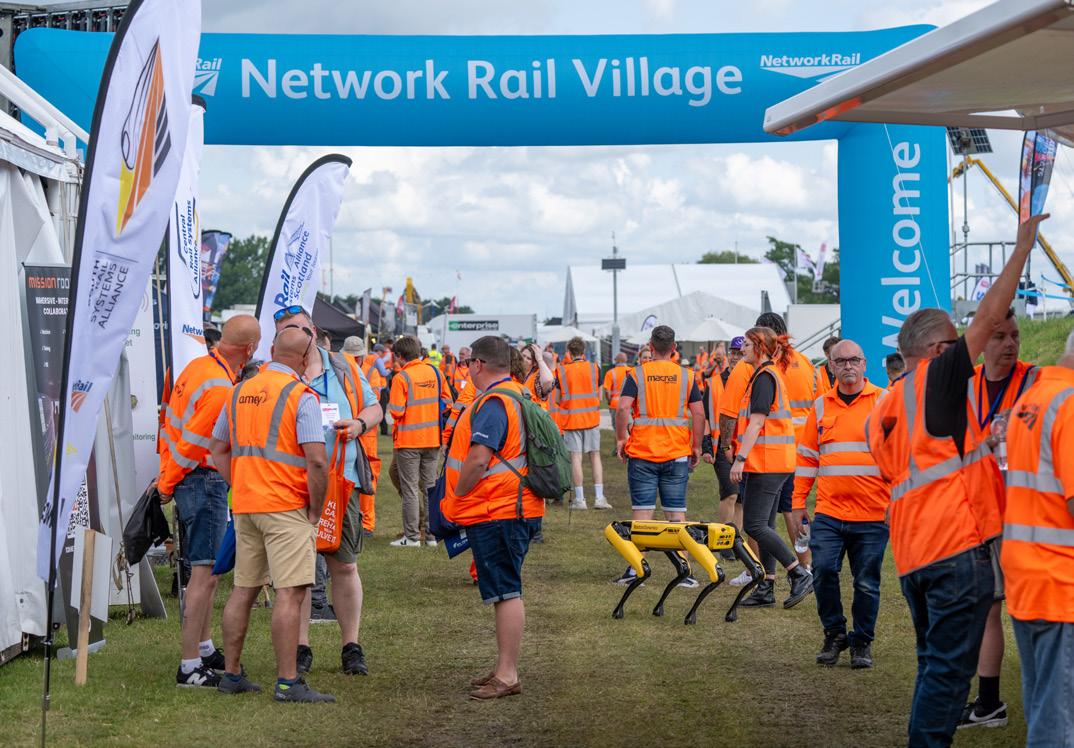
and technology in action, the event endeavours to help companies improve their workplace practices, such as through safety, productivity and sustainability. Specific showcases for the 2024 exhibition will see Rail Operations Group and Stadler display a new Class 93 tri-mode locomotive. Meanwhile, Network Rail will present a Class 153 monitoring train.
Speakers
Rail Live 2024 will host a seminar theatre in an opensided covered marquee. This year’s speakers include representatives from the Great British Railway Transition Team (GBRTT), Network Rail, the Rail Safety and Standards Board (RSSB) and the Office of Rail and Road (ORR).
In addition, Rail Minister Huw Merriman will provide an update on the government’s intentions to invest in the railway.
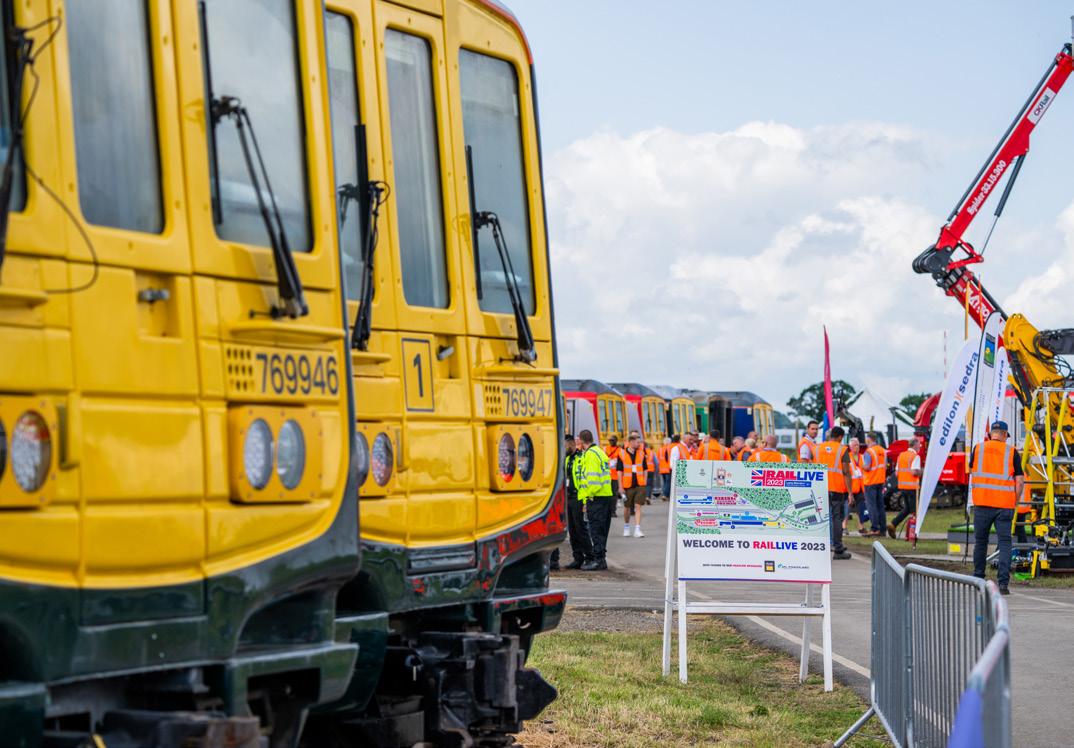
82
Informative sessions will also offer insight into topics such as the recruitment and retention of staff, enhancing safety, and financing projects.
What’s New in 2024?
For the first time, Rail Live 2024 will feature a new engineering theatre where attendees can learn how the rail industry is advancing towards a more environmentally sustainable future. This site will focus on technology such as AI and digital signalling.
In addition, the event will host its first “HS2 Meet the Contractor” event for attendees to connect with key companies involved in the HS2 project.
Venue
Porterbrook's Long Marston Rail Innovation Centre is an approved Test & Trials site. It is the largest rolling stock storage facility in the UK and includes around 20 kilometres of sidings, as well as a 3-kilometre test loop. It is connected to the national rail network at Honeybourne on the Worcester to London line.
Attendees travelling to Rail Live by train can take advantage of a complimentary coach shuttle service that will run from Warwick Parkway and Honeybourne stations.
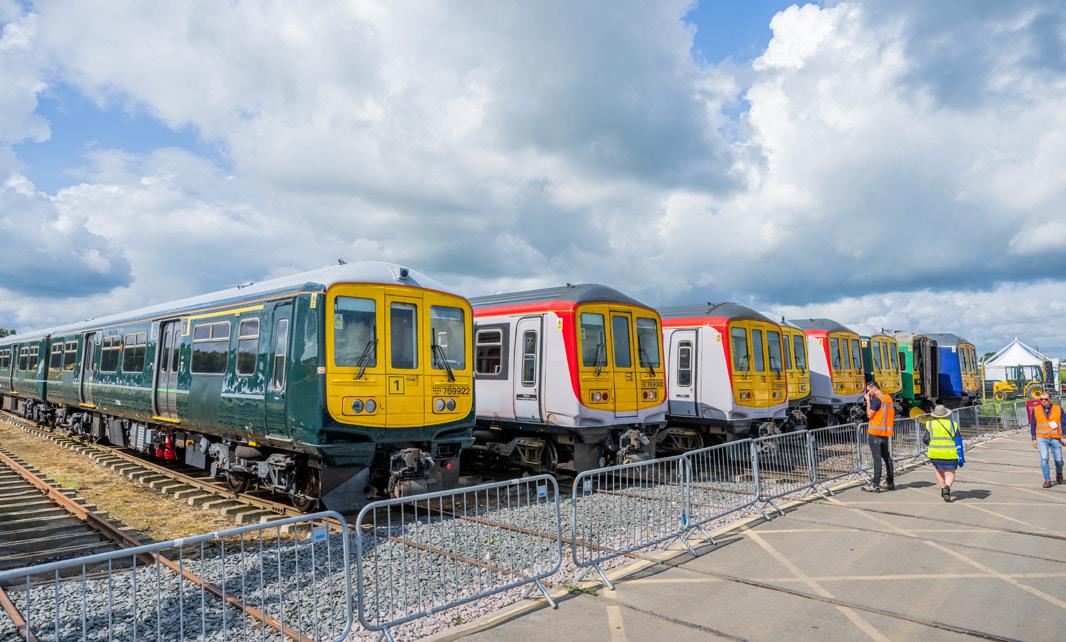
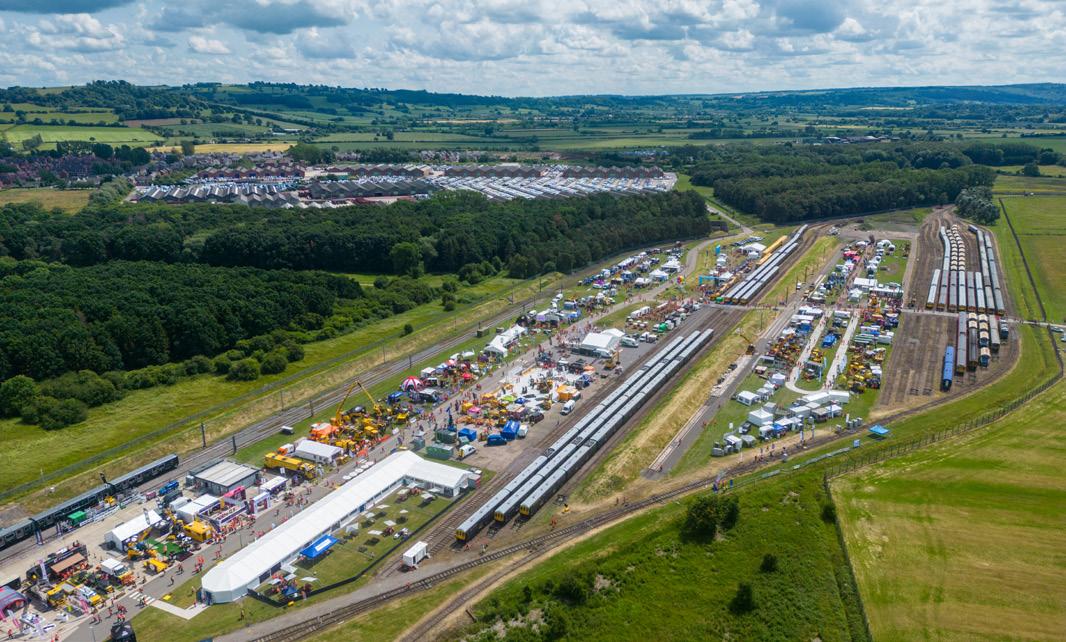
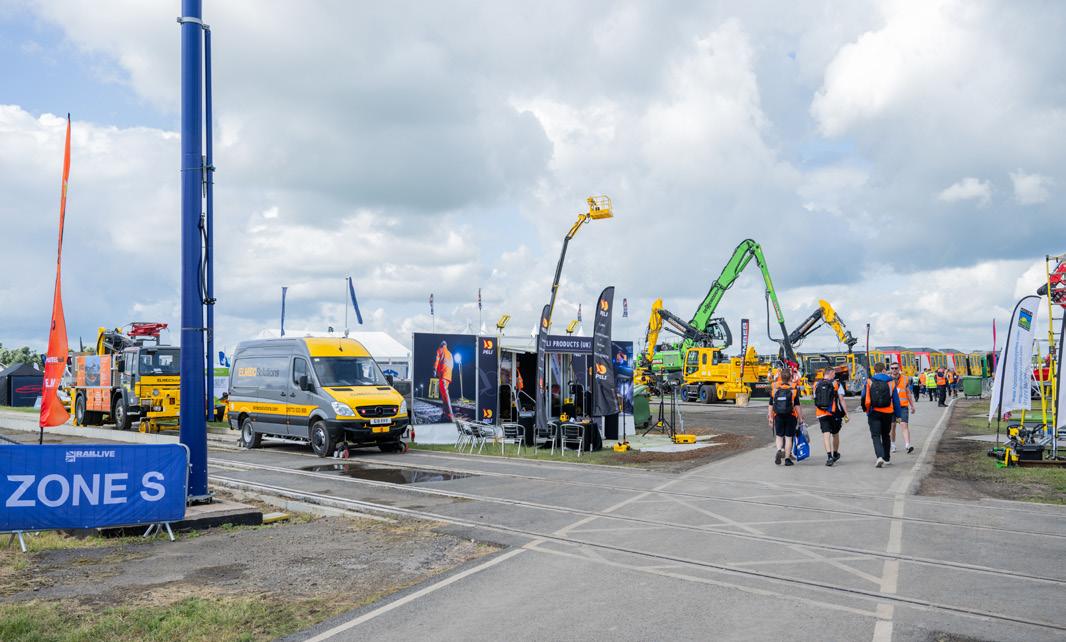

For more information about the event visit www.raillive.org.uk Register today to make sure you get ticket! All images: © JB Media 83
Supplier Spotlight
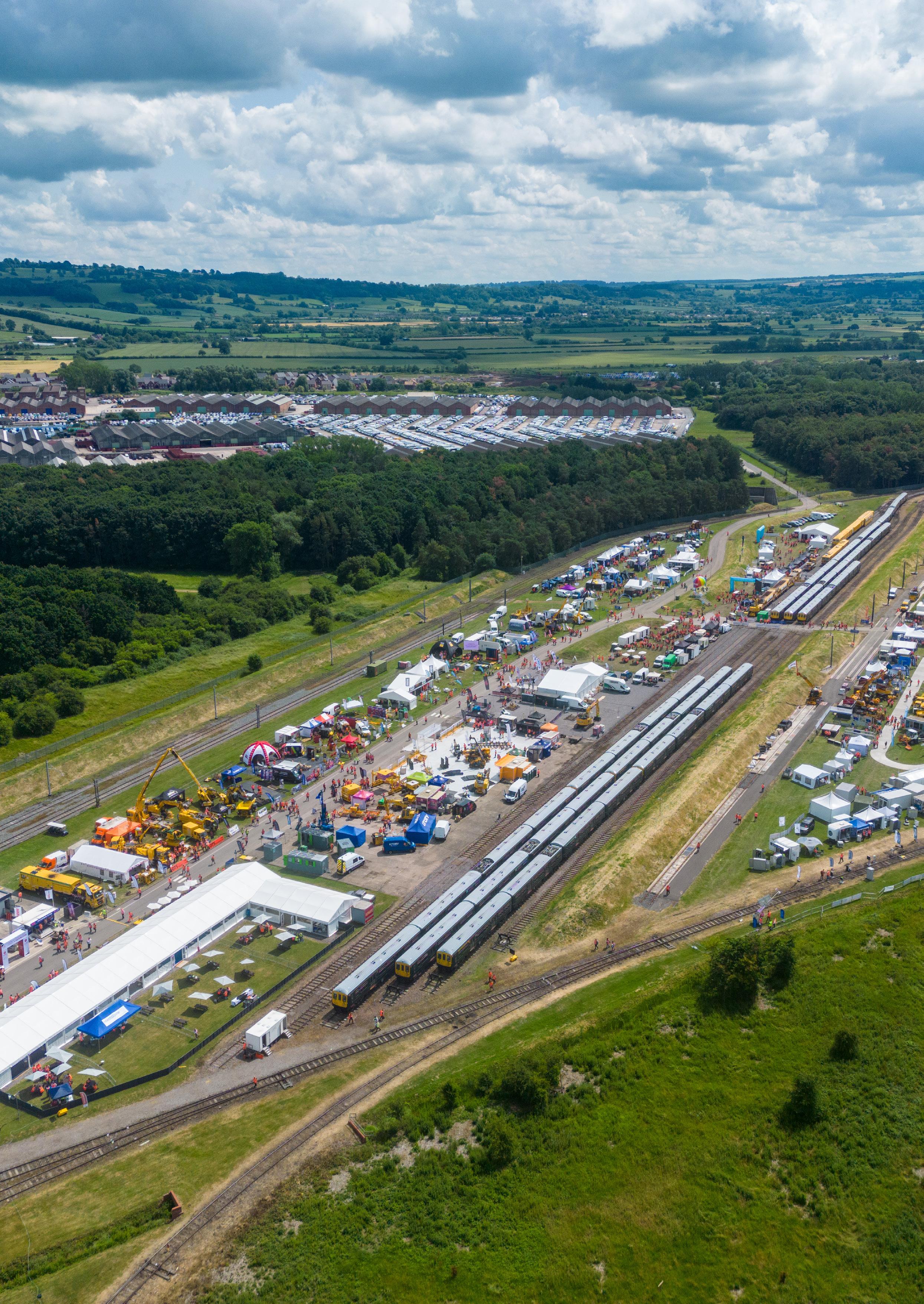
Dual Inventive - B28
Dual Inventive develops innovative rail safety products using wireless technology at the highest system safety integrity (SIL4).
Frauscher UK - M186
Frauscher Sensor Technology offers innovative solutions for the individual requirements of customers worldwide in the field of axle counting and wheel detection.
Goldschmidt - E21
Goldschmidt offers a comprehensive range of products and services worldwide for the joining of rails, modern construction of railway track and inspection and maintenance of track infrastructure.
HIRD Group - G10
HIRD Group is a major global supplier of glued insulated block joints (IBJs), hybrid polymer sleepers, bearers and anti-trespass systems and of the Green Trough range of cable management systems and combined anti-slip walkway & cable management routes.
Mosdorfer Rail Ltd - J47
Mosdorfer Rail is an industry-leading manufacturer and supplier of railway catenary systems and solutions, including the supply of complete overhead line catenary systems, cantilevers, tensioning systems (Tensorex C+), clamps, connectors and composite insulators.
Pandrol - E35
Pandrol defines the industry standard across rail fastening systems and aluminothermic welding. The company has created rail infrastructure in more than 100 countries.
Robel - B21
ROBEL creates powerful machines and systems and delivers a good service for the construction and maintenance of railway infrastructure systems all over the world.
Totalkare - M48
Totalkare is the UK’s leading provider of lifting and testing solutions for heavy-duty and light commercial workshops.
Wavetrain - SIG17
Wavetrain aims to reduce risk at level crossings globally. Wavetrain’s Network Rail type approved OMSL system installs in a night at the level crossing without service interruption.
Yeltech - C2
Yeltech is a premier provider for comprehensive monitoring requirements. Leveraging wireless data transmission capabilities, Yeltech establishes smooth communication channels between products and engineers, maximising the advantages of monitoring.
Zöllner UK - E17
Zöllner UK is a worldwide supplier of railway safety solutions and in particular, track warning systems. With fantastic solutions for LOWS and SATWS already on the market, the company has now developed a brand new Automatic Track Warning System solution which it will be showcasing at this year's event.
Interested in becoming a supplier? Click here to get in touch and find out what Railway-News can do for you.
84
Upcoming Rail Events & Exhibitions
May 2024 – September 2024
Click here to see all of our event and exhibitions listings APTA Rail Conference 2–5 June 2024 | Cleveland Railway Evolution 4 June 2024 | Toronto Rail Business Days 11–13 June 2024 | Ostrava, Czechia World Passenger Festival 25–26 June 2024 | Vienna UK Light Rail Conference 17–18 July 2024 | Leeds Rail Decarbonisation 5–6 August 2024 | Sydney InnoTrans 24–27 September 2024 | Berlin Rail Live UK 19–20 June 2024 | Long Marston, UK Asia Pacific Rail 29–30 May 2024 | Bangkok Rolling Stock Networking 4 July 2024 | Derby 85
Rail Safety Week 2024 –Let’s Build Safety Together
By Elaine Clark Chief Executive Officer at Rail Forum
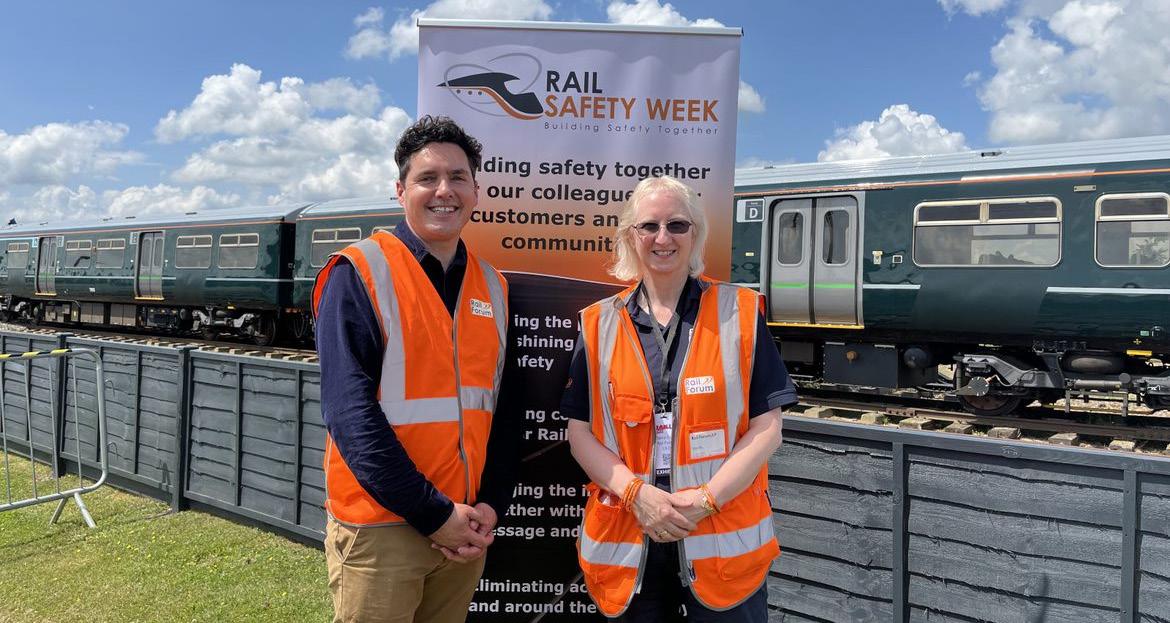
Rail Safety Week 2024 will run from Monday 24 –Sunday 30 June.
With safety remaining of paramount importance to the rail industry, Rail Forum is committed to delivering Rail Safety Week 2024.
Rail Safety Week was the brainchild of Alan Tarrant. In 2023, Rail Forum then adopted the initiative. Rail Safety Week runs separately to Rail Forum’s day-to-day work
with its own website and the clear message that safety is for everyone, and anyone can get involved.
Over 140 organisations took part last year, bringing rail safety to the forefront of people’s minds in the workplace, the industry, communities and schools, and we hope that in 2024 it will be even bigger.
Safety is and always will be a key priority for the rail industry. While other initiatives come and go, safety

86
Elaine and Huw Rail Safety Week 2023

should be an enduring constant that transcends commercial interests. This dedicated week encourages organisations to take action and reinforce the importance of health and safety. We all have a vested interest in ensuring that everyone gets home safely every day, and by getting involved and supporting Rail Safety Week we can amplify our collective safety messages to colleagues, customers and the public.
So What Is Rail Safety Week?
It’s a dedicated week during which we encourage as many organisations to do something health or safety related for their staff, customers or the general public. What organisations do is entirely up to them. Suggested options include launching a new health or safety initiative, running health or safety training or holding tool box talks. It could include social media videos of team members talking about what safety means to them. This is an opportunity to be creative and involve team members in developing ideas. Publicfacing organisations might run an initiative improving public awareness of the hazards on or around trains or stations; those working with young people could educate them about the danger of trespassing on the
railway. It doesn’t need to cost a lot. In fact it doesn’t need to cost anything other than a bit of time. Rail Safety Week isn’t a single event, rather a dedicated week full of activities and events by organisations across the industry. Rail Forum’s role is to encourage people to get involved to do something for themselves.
Currently, a lot of companies are focusing on mental health and wellbeing. Rail Safety Week could provide an opportunity for you to address that gap. Alternatively, you could focus on a specific aspect of safety that is especially relevant to your organisation. For ideas and inspiration on how to get involved, click here and for further inspiration, see the support and activities from organisations in 2023.
“Rail Safety Week is something all of us can get behind,at a time when the industry is being encouraged to collaborate more, what better reason can there be to work and build safety together?”
Elaine Clark, CEO of Rail Forum
87

Organisations can submit their plans via a simple form on the What’s On 2024 page, and Rail Forum will promote your events and activities via the Rail Safety Week channels. There is also a FREE suite of Rail Safety Week branded materials that we encourage you to use to showcase your support.
“It’s not for us to tell people what they should do,” says Elaine Clark, CEO of Rail Forum.“We organise a one-day launch conference which covers a range of topics from workplace health and safety to the work of community rail partnerships.Our 2024 conference includes a wide range of speakers from industry,regulators and more; it’s open to all and free to attend.We also publicise events that organisations are arranging and highlight those that are open to others to attend.”
Rail Safety Week also presents a fantastic opportunity to provide some fun activities for our younger audience and to educate school-age children about the importance of safety on and around the railway. There will be a colouring competition for younger children and a rail-themed crossword for those a little older. Both can be found on the Rail Safety Week website and are open to children from across the UK. So why not encourage your children, or grandchildren to take part?
“Rail Safety Week is something all of us can get behind,” concludes Elaine. “At a time when the industry is being encouraged to collaborate more,what
better reason can there be to work and build safety together?”
Click here to find out more
Rail Forum invites industry colleagues to join the Rail Safety Week Conference which will be hosted in Manchester between 09:30 – 14:00 on Monday 24 June 2024
The focus of this year’s Conference will be on driving improvement in health and safety and we will consider the importance of both process and people. We have a great lineup of speakers, with contributions from Kier Group, PA Consulting, 3Squared, Intersol Global, Evalu-8, Network Rail, ORR, LRSSB, Department for Transport, Morson Group, Railway Mission, Community Rail Network, East Midlands Railway and more.
Secure your free place here.

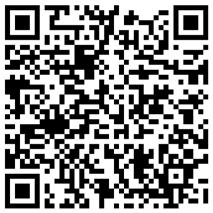

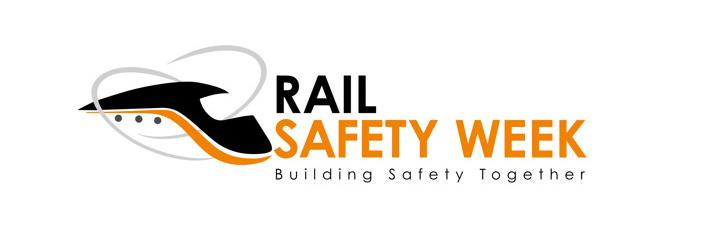
88
Original founder with Elaine and Rail Safety Week Chair Simon Higgens

Thank you for reading Issue Two 2024 of the Railway-News magazine. Visit our website to keep up to date with the rail sector.

































 Martin Shaw Head of On-Train Digitalisation for Icomera
Martin Shaw Head of On-Train Digitalisation for Icomera






























 Installation of external cabinet, DMP Rack located in SolarXBox
Installation of external cabinet, DMP Rack located in SolarXBox

















































 Polarteknik’s employee installing a window seal frame
FinnProfiles supplies several different sealing materials and profiles to Polarteknik.All of them comply with the EN 45545-2 standard
Polarteknik uses several kilometres of sealing material every year
Polarteknik’s employee installing a window seal frame
FinnProfiles supplies several different sealing materials and profiles to Polarteknik.All of them comply with the EN 45545-2 standard
Polarteknik uses several kilometres of sealing material every year














 Three dedicated PAUT scanners,optimised for inspection of wheelset axle,rim and tread
Three dedicated PAUT scanners,optimised for inspection of wheelset axle,rim and tread







 Andreas Bayerlein Roediger Vacuum GmbH andreas.bayerlein@roediger-vacuum.com
Andreas Bayerlein Roediger Vacuum GmbH andreas.bayerlein@roediger-vacuum.com






























 Montreal, worldwide AI hub
Montreal, worldwide AI hub













































